
THE PROJECT LANDSCAPE ISSUE
Margaret A. Kidd: Champion for Breakbulk’s NextGen Houston Stalwart Forges Academia, Industry Bonds
Issue 2 2024
Wind, Infrastructure, Oil & Gas, CCS and Hydrogen Opportunities


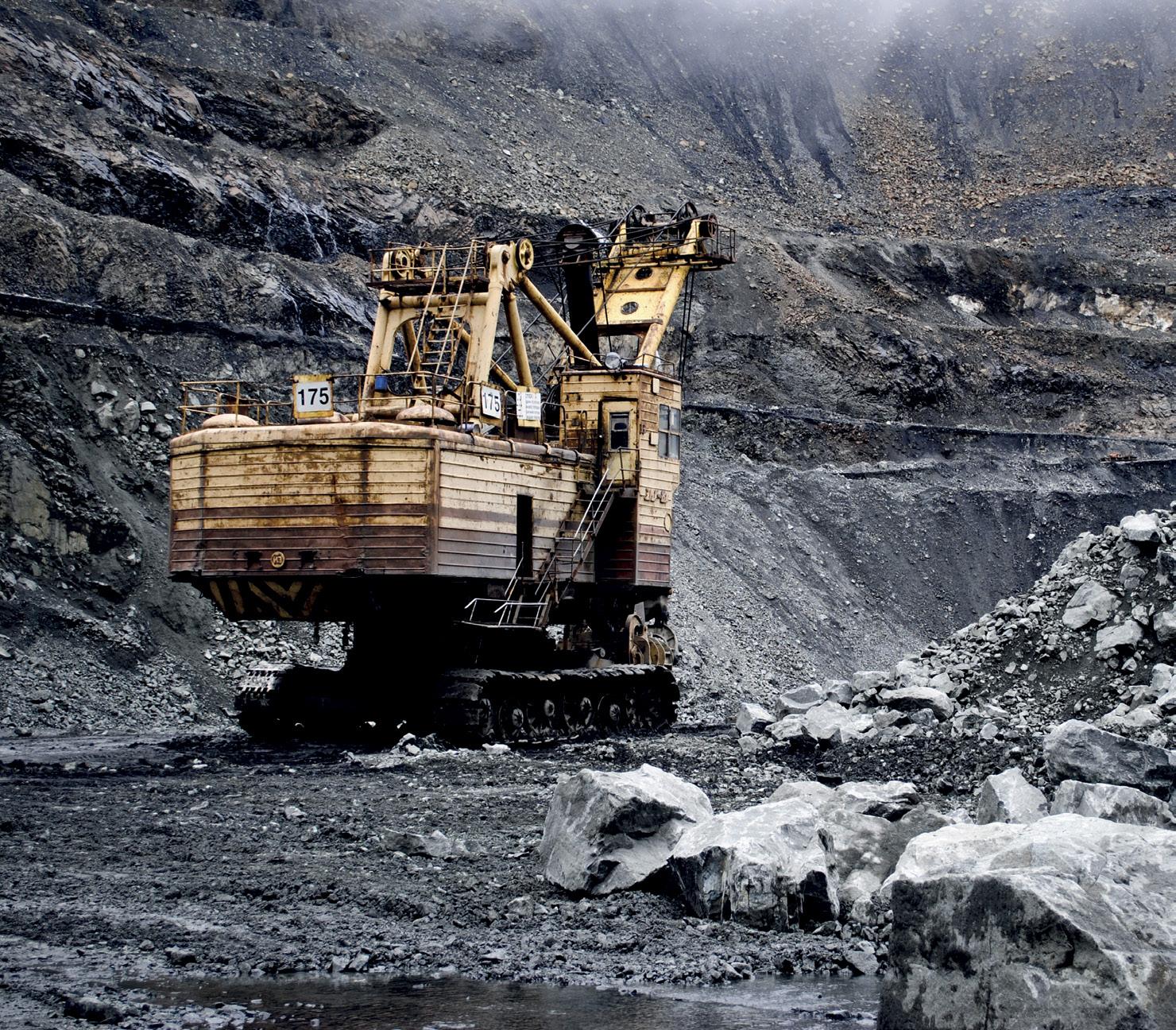
3 Breakbulk Magazine Issue 2 2024 breakbulk.com Inside This Issue 46 Europe Too Many Turbines, Too Few Vessels Could Lack of Heavy-lift Vessels Slow Europe’s Offshore Wind Ambitions? 50 Europe Lessons Learned From CCS Projects Heidelberg Materials’ Facility Overcomes Challenges 54 Europe SASA’s Çelikoğlu Rises to Quake Challenge Petrochem Producer Mobilizes Resources for Search and Rescue Support 58 Europe Closing the Loop With Circular Logistics Increasing Focus in Sustainable End-to-End Logistics Solutions 60 Europe Trying Terrain for Collett Turbine Move Partnerships Smooth Out ‘Sharp Corners and Pinch Points’ 64 Americas Chile Seeks to Speed Up Project Approvals Forwarders Welcome Plans to End “Nightmare” Permitting Process 26 Global How China Plus One Derisks Supply Chains Revisit Sourcing Strategies to Reduce Overdependence 30 Global Prepping for a Hydrogen Heyday Wider Adoption a New Business Line for Project Cargo Specialists 33 Global Nickel Needs Set to Drive Mining Projects Metal Demand Forecast to Increase 65% by 2030 36 Profile Sameer Parikh: Epitome of an Earnest Operator JM Baxi Heavy President Breaks Boundaries 40 Global Accelerating Vehicle Growth Drives Capacity Constraints High and Heavy Volumes Strong Amid Geopolitical Risks 44 Global Alliances Make Even the Trickiest Projects Run Smoothly Engagement Brings Construction, Engineering Teams Together Cover Story 70 Mark Your Calendars for Upcoming Breakbulk Events Breakbulk Europe 21-23 May 2024 Rotterdam Ahoy, Netherlands Breakbulk Americas 15-17 October 2024 George R. Brown Convention Center, USA Breakbulk Middle East 10-11 February 2025 Dubai World Trade Centre, UAE 46 Margaret A. Kidd: Champion for Breakbulk’s NextGen Houston Stalwart Forges Academia, Industry Bonds Nickel Needs Set to Drive Mining Projects
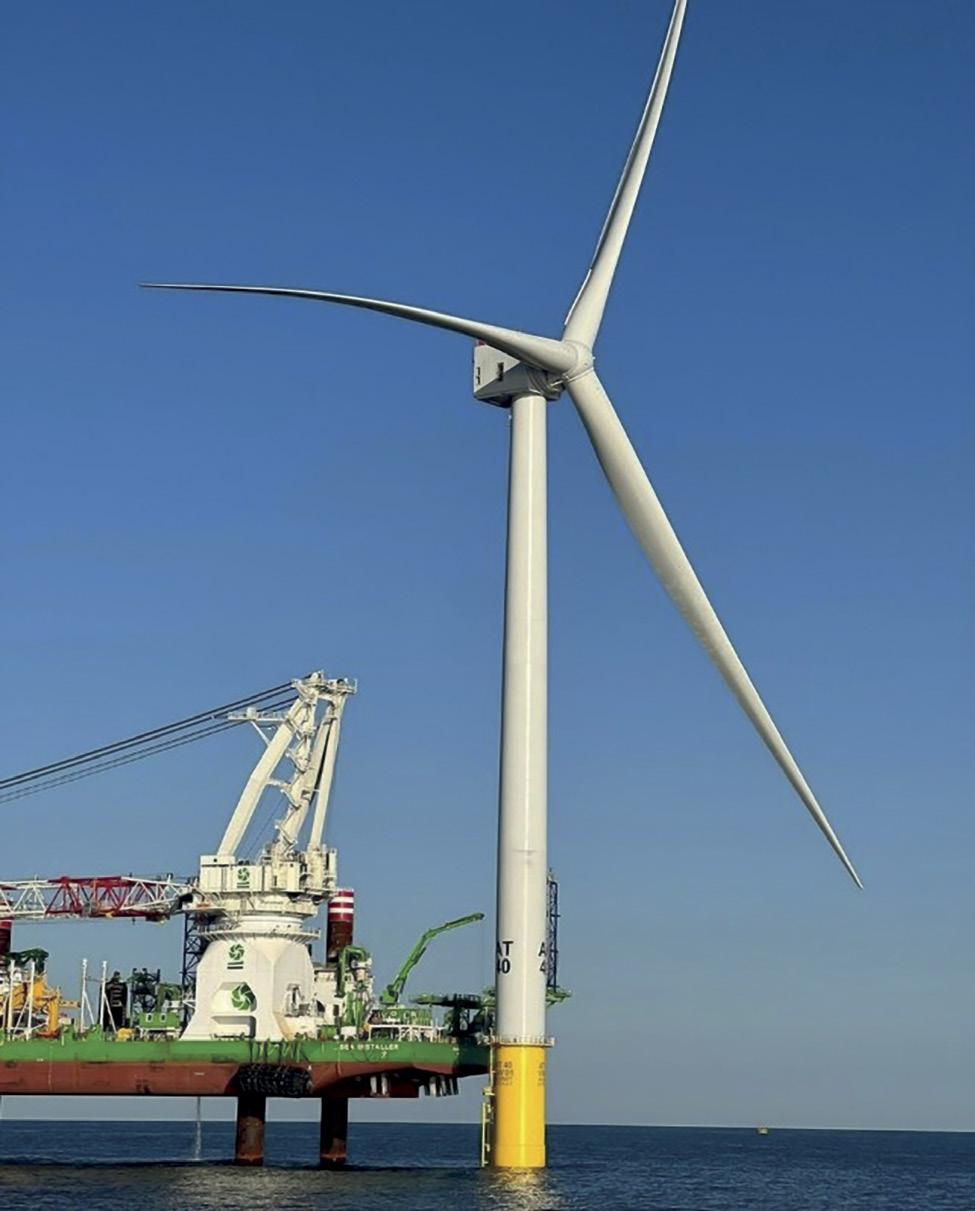

4 Breakbulk Magazine Issue 2 2024 breakbulk.com Inside This Issue 66 Americas US Wind Projects Set back, Not Stalled Supply Chain Issues, Escalating Costs Are Surmountable 70 Profile Margaret A. Kidd: Champion for Breakbulk’s NextGen Houston Stalwart Forges Academia, Industry Bonds 74 Middle East Saudi’s Horizon of Project Opportunities Look Beyond NEOM for More Mega Developments 78 Thought Leader Mining For Glory in Africa Continent on Brink of Minerals, Metals Explosion
Middle East Iraq’s Mega-project Sparks Infrastructure Boom Country’s US$17 Billion Road and Rail Plan to Create Opportunities
Middle East Africa’s Oil and Gas Sector Surges US$800 Billion Investment Drive Accelerates Amid Rising Demand
Asia Asia Set to Dominate Wind Power Scene Offshore Projects Ready for Liftoff in Region Also in This Issue 06 Foreword 09 UpFront 86 Breakbulk Middle East Recap 93 Best of BreakbulkONE 96 Projects in This Issue 66 82 US Wind Projects Set back, Not Stalled Africa’s Oil and Gas Sector Surges
79
82
90

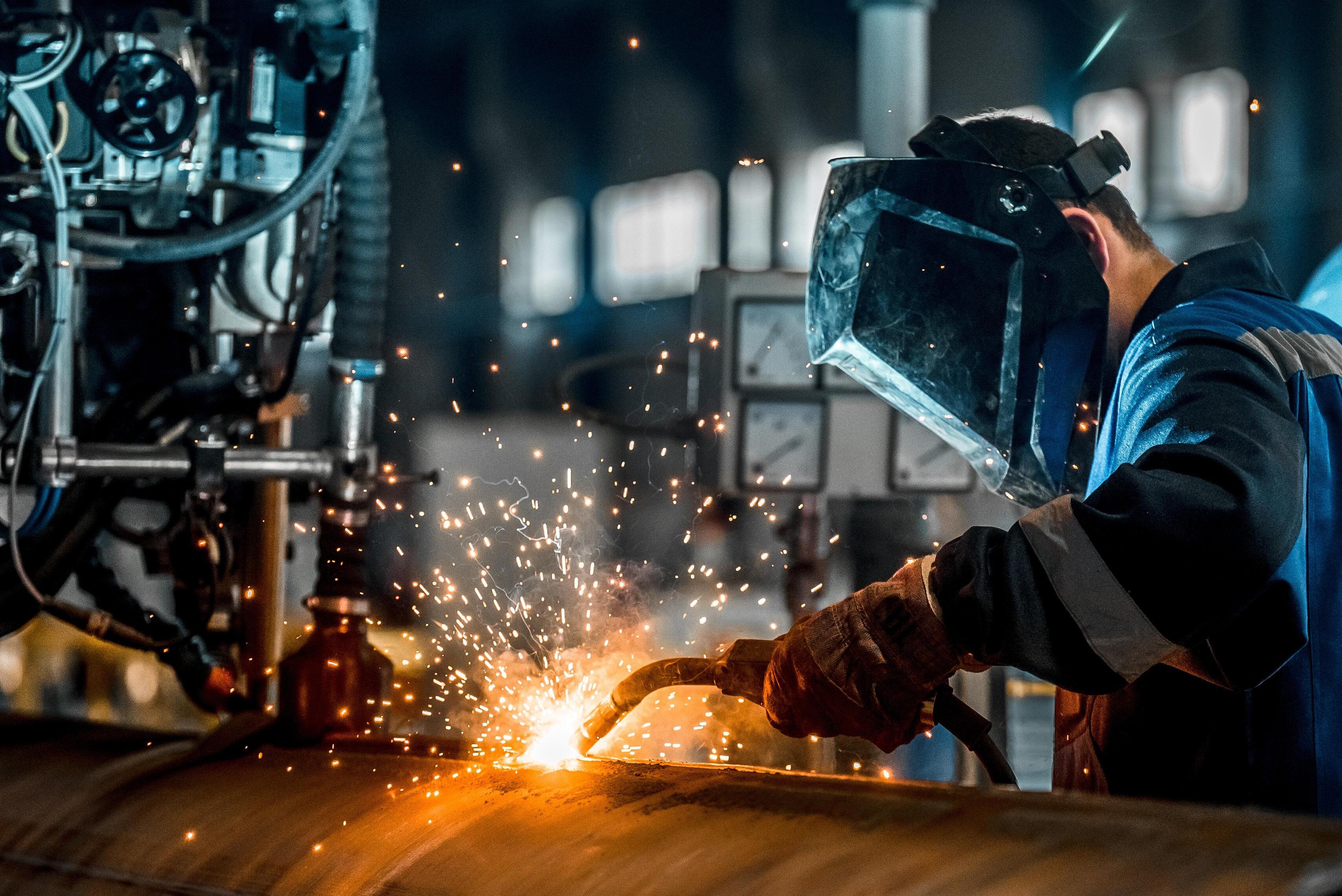
Delivering what your customers need.
Houston City Docks
Port
www.porthouston.com
A BOOMING PROJECT LANDSCAPE BECKONS
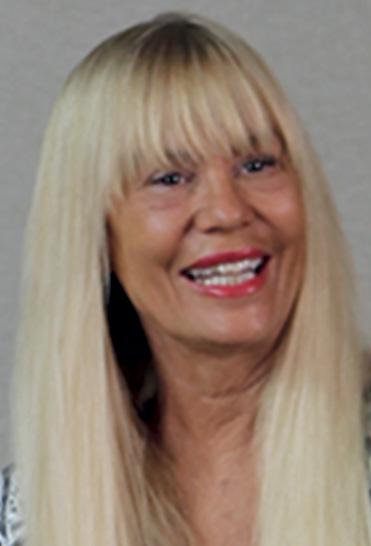
I can describe this issue in just one word: opportunity.
The project landscape is bursting with opportunities across multiple sectors.
Along with wind farms and oil & gas projects, new areas like carbon capture and storage (CCS), hydrogen, and futuristic infrastructure projects are rapidly gaining momentum.
Of course, with any opportunity comes its share of challenges such as meeting equipment needs and finding capacity for project cargo shipments, but industry professionals are optimistic. The key word here is collaboration. By working together, we can tackle these challenges headon and ensure everyone benefits from the exciting times ahead.
To help you navigate this dynamic picture, we’ve packed this issue with insightful articles and features.
Starting with the global section, “How China Plus One Derisks Supply Chains” by Felicity Landon explores a strategic approach to managing geopolitical risk. Move on to “Prepping for a Hydrogen Heyday” by Luke King who delves into the global rise of hydrogen projects, opening a new business line for project cargo specialists.
In our Europe section, take a candid look at project development in Felicity Landon’s “Lessons Learned From Heidelberg Materials CCS Project.” This story offers a thorough assessment of what went right and what could have been done differently in this brownfield project where laydown space was at a premium.
In Türkiye, project cargo service providers have had their share of challenges, but nothing can daunt their
commitment to seeing projects through completion. Check out Q&As with three Turkish exhibitors who you can meet at Breakbulk Europe. Staying in Türkiye, “SASA’s Çelikoğlu Rises to Quake Challenge,” by Simon West, presents an interview with Uğur Çelikoğlu from Turkish chemicals giant SASA. Çelikoğlu relates his on-the-ground experience as his project was rocked by the devastating February 2023 earthquake.
Travel across the Atlantic to the Americas where our cover story focuses on a familiar industry face at Breakbulk events. In “Margaret A. Kidd, Champion for Breakbulk’s NextGen,” read about her remarkable journey from Wall Street to the University of Houston and onto the international stage as the go-to resource for all things logistics.
Looking at projects, offshore wind in the U.S. is facing challenges, but Carly Fields’ report on the sector reveals a more optimistic picture as discussed by deugro’s Thomas Wylie and UTC Overseas’ Marco Poisler.
Moving on to the Middle East, Africa and Asia, writer Heba Hesham gives us a look at “Iraq’s Mega-project Sparks Infrastructure Boom” through the expert eyes of Captain Cem Ercan, CEO for CETA Logistics & Projects. Ercan is involved in the US$17 billion Development Road project to link Iraq with Türkiye via high-speed rail. Liesl Venter reports on Africa’s oil and gas project boom fueled by an accelerating US$800 billion investment, while Thomas Timlen reveals the most promising markets for offshore wind across major Asian markets.
Our next issue is the Europe edition and will be distributed at Breakbulk Europe, May 21-23. To discuss opportunities and challenges in person, plan to join us in Rotterdam.
Best,
Leslie Meredith Marketing and Editorial Director Breakbulk Events & Media
Marketing and Editorial Director
Leslie Meredith / +1 (801) 214 4229
Leslie.Meredith@breakbulk.com
News Editor
Carly Fields carly.fields@breakbulk.com
Senior Reporter
Simon West simon.west@breakbulk.com
Designer
Mark Clubb
Reporters
Heba Hashem
Luke King
Felicity Landon
Lori Musser
Malcolm Ramsay
Thomas Timlen
Liesl Venter
Breakbulk Magazine Editorial Board
John Amos Amos Logistics
Tina Benjamin-Lea Air Products
Dea Chincuanco dship Carriers
Elisabeth Cosmatos Cosmatos Group of Companies
Dennis Devlin Maersk Project Logistics
Dharmendra Gangrade Larsen & Toubro
Margaret Kidd University of Houston
Stephen “Spo” Spoljaric Bechtel Corporation
Jake Swanson DHL Global Forwarding
Grant Wattman Combi Lift Americas
Portfolio Director
Jessica Dawnay
Jessica.Dawnay@breakbulk.com
To advertise in Breakbulk Media products, visit: http://breakbulk.com/page/advertise
Subscriptions
To subscribe,
6 Breakbulk Magazine Issue 2 2024 breakbulk.com Foreword
A publication of Hyve Group plc. The Studios, 2 Kingdom Street Paddington, London W2 6JG, UK
go to https://breakbulk.com/page/ breakbulk-magazine
Leslie Meredith
SEAMLESS CONNECTIONS
At DP World, our ports and terminals help businesses streamline operations, lower costs and achieve sustainability goals.
We’re working to end supply chain disruption by reducing friction in every part of your cargo’s journey, creating certainty and security for all.
From the factory floor to your customer’s door, DP World is working to ensure the fast, transparent movement of goods, connecting you to your customer.

Speakers, Exhibitors and Breakbulk Global Shipper Network Members in this issue:
Movers & Shakers, page 12
AsstrA-Associated Traffic AG, CEVA Logistics, Fracht Group, Gebrüder
Weiss, Port of Corpus Christi, Port of Rotterdam, RAK Ports
Driving Excellence in SPMT Operations, page 10
Fagioli, Goldhofer, Mammoet, TII Group, Wagenborg, Collett, Technip, Saipem and Siemens Gamesa
Africa’s Oil and Gas Sector Surges, page 82
John Pittalis, Head of Marketing and Communications, AAL Shipping (AAL)
Gopalakrishnan Srinivasan, General Manager for Special Projects –Energy, GAC Group
Accelerating Vehicle Growth Drives Capacity Constraints, page 40
Emmanuel Cheremetinski, Global Finished Vehicle Logistics Leader, CEVA Logistics
Trying Terrain for Collett Turbine Move, page 60
Roy Edmondson, Project Manager, Collett & Sons
GE Renewable Energy
Prepping for a Hydrogen Heyday, page 30
Thies Holm, General Manager, GAC Germany
Lorenzo Simonelli, Chairman and CEO, Baker Hughes
David R. Edmondson, Chief Executive Officer, NEOM Green Hydrogen Company (NGHC)
Port of Stade, Seaports of Niedersachsen, PD Ports, Chipolbrok
Iraq’s Mega-project Sparks Infrastructure Boom, page 79
Captain Cem Ercan, CEO, CETA Logistics & Project Daewoo Engineering & Construction, Hyundai Engineering and Construction, JGC
Nickel Needs Set to Drive Mining Projects, page 33
Colin Charo, CEO, Trans Global Projects
Trevor Blair, Senior Supervisor of Strategic Planning and Business Development - Raglan Mine, Glencore
Sameer Parikh: Epitome of an Earnest Operator, page 36
Sameer Parikh, President & Chief Business Officer, JM Baxi Heavy Larsen and Toubro, Wärtsilä, Caterpillar, Technip
Closing the Loop With Circular Logistics, page 58
Dr. Sven Hermann, Professor of logistics and Supply Chain Management, NBS Northern Business School Hamburg, and Founder and Managing Director of ProLog Innovation GmbH (speaker)
André Starke, Head of Project Logistics, Andritz Hydro
Daniel Duus, Global Head of Logistics, thyssenkrupp Uhde
How China Plus One Derisks Supply Chain, page 26
Vilasini Krishnan, Vice President, 4D Supply Chain Consulting
Peter Molloy, senior maritime research analyst, Drewry
Dr. Ferenc Pasztor, Deputy Head of Research at Drewry
Too Many Turbines, Too Few Vessels, page 46
Brian Boutkan, Manager Commerce Offshore, Jumbo Offshore
Ørsted, Allseas
Carriers, Shippers, Forwarders Need to Be United, page 86
Denis Bandura, Managing Director, BBC Chartering UAE*
Carsten Wendt, Head of Sales for High & Heavy and Breakbulk, Wallenius Wilhelmsen
Vilasini Krishnan, Vice President, 4D Supply Chain Consulting
Call for Supply Chain Agility, Resilience, page 87
Jamilya Garajayeva, Logistics Manager, Petrofac
Peter Dudas, Head of Global Commercial and Tendering Strategy, DHL Industrial Projects
Christopher Grammare, Managing Director, AAL Shipping
Women Leaders Inspire Next Generation, page 88
Abir Leheta, CEO, Egytrans
Dalia Farahat, Regional Control Tower Manager O&G – MEA IP, DHL
Global Forwarding
Simona Peter, Business Development, Fleet Line Shipping
Alia Janahi, Vice President of HSE, DP World GCC
Corpus Christi to Handle More Project Cargo, page 93
Omar Garcia, Chief External Affairs Officer, Port of Corpus Christi
AAL Responds to Perils of Red Sea Routes, page 94
Christopher Grammare, Managing Director, AAL Shipping (AAL)
Swire Projects Launches Asia-Americas Service, page 95
Rufus Frere-Smith, Regional Head of Americas, Swire Projects
Lessons Learned From CCS Project, page 50
Meriaura, Paldiski North Port, Port of Antwerp-Bruges, Port of Rotterdam
Navigating an Unprecedented Challenge, page 54
Uğur Çelikoğlu, New Investments Logistics Lead, SASA CJ-ICM Logistics
Chile to Speed Up Project Approvals, page 64
Alberto Oltra, CEO for South America and Country Manager for Chile, DHL Global Forwarding
US Wind Projects Set Back, Not Stalled, page 66
Thomas Wylie, Head of Global Strategic Projects and Accounts, deugro
Marco Poisler, Chief Operating Officer, Global Energy and Capital Projects, UTC Overseas Ørsted
Saudi’s Horizon of Project Opportunities, page 74
Almajdouie Logistics Company, Mawani, Saudi Ports Authority
Ma’aden, Saudi Aramco, Technip Energies
Key:
Breakbulk Global Shipper Network Member
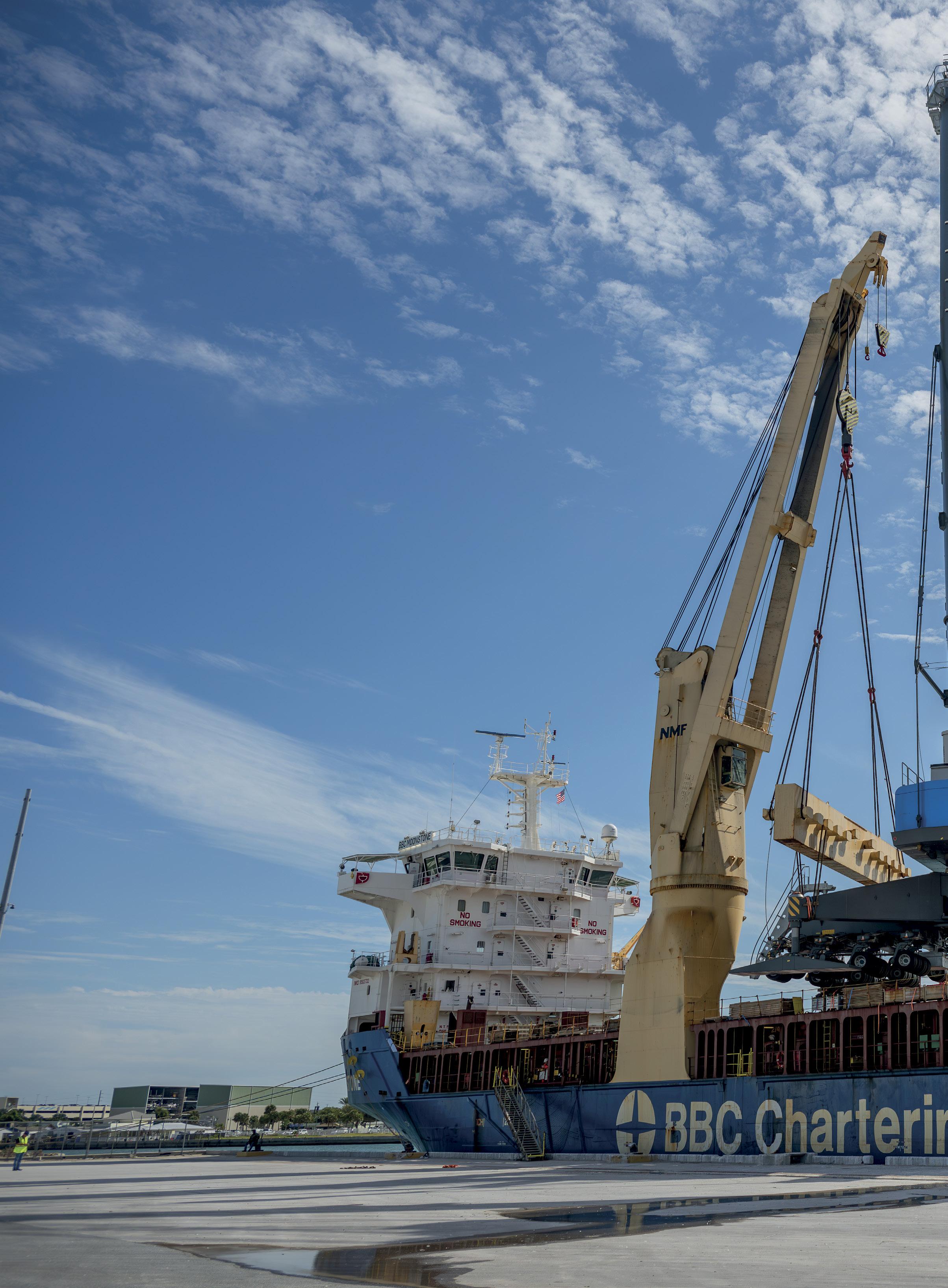
Credit: BBC Chartering
Inside This Issue 8 Breakbulk Magazine Issue 2 2024 breakbulk.com

Credit: Wagenborg Ton Klijn on SPMT Growth Movers & Shakers Spotlight on Türkiye New Faces at Breakbulk Europe 2024 Breakbulk Middle East – By The Numbers Gift Guide INSIDE
Thought Leader
DRIVING EXCELLENCE IN SPMT OPERATIONS
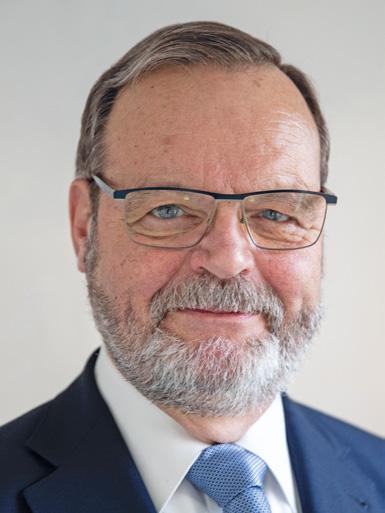
Urgent Need for Operator Training and Standards
By Ton Klijn
One of the most notable trends in logistics and heavy transport markets in recent years has been the rapid growth in the use of selfpropelled modular transporters, or SPMTs.
For the uninitiated, an SPMT allows very large and heavy loads to be transported with great precision. It consists of a platform supported by computer-controlled axles and the modular nature of the system allows for unlimited configurations by adding axles lines.
They are used for moving massive objects, such as large bridge sections, oil refining equipment, ships, heavy machinery and industrial components – in other words, loads that are too big or heavy for trucks.
The growth in off-site manufacturing and construction, combined with all industries’ continuous quest for greater efficiency, has resulted in a steady increase in the height, size and weight of modules, components and structures needing to be transported, and hence, strong growth in the market for SPMT services.
But that success comes with a price. There is no industry-wide standard or system for training SPMT operators, and the growth in demand has attracted increasing numbers of inexperienced entrants into the market.
The simple and unpalatable truth is that around the world, we are seeing far too many accidents involving SPMTs and we firmly believe that improved technical guidance coupled with properly regulated operator training are essential for the future.
Stability Guidance Published
At the end of last year, ESTA – the European Association of Abnormal Road Transport and Mobile Cranes – published a new transport stability guideline for the use of modular hydraulically suspended trailers including SPMTs.
If we were in any doubt before publication about the industry’s need for such work, those doubts were rapidly dispelled. We had the biggest response we have ever received in my time working with ESTA.
The guideline is the product of ESTA’s SPMT working group whose member companies come from eight different countries, reflecting the widespread concern across Europe.
It specifies the factors to be considered when verifying the global stability and capacity of a modular hydraulically suspended trailer by calculation, assuming that the trailer is operating on a stable surface.
It also details the conditions and considerations for local stability of trailers within a transport arrangement and the stability of the cargo itself and is referenced in the DNV ST-N001 Maritime Operations Standard published by DNV, an independent expert in assurance and risk management.
The guideline will eventually be incorporated into a completely updated best practice guide to be published later this year.
Alongside this work, ESTA has started on plans to develop SPMT operator training through the launch of ETOL – a European Transport Operators Licence – using the structures developed for our European Crane Operators Licence (ECOL).
We will create a new European Crane and Transport Operators Licence organization as an umbrella body that will oversee both the existing ECOL and the new ETOL which will initially focus on training for SPMT operators. We decided that this will be simpler and more efficient than creating a completely new organization from scratch.
10 Breakbulk Magazine Issue 2 2024 breakbulk.com
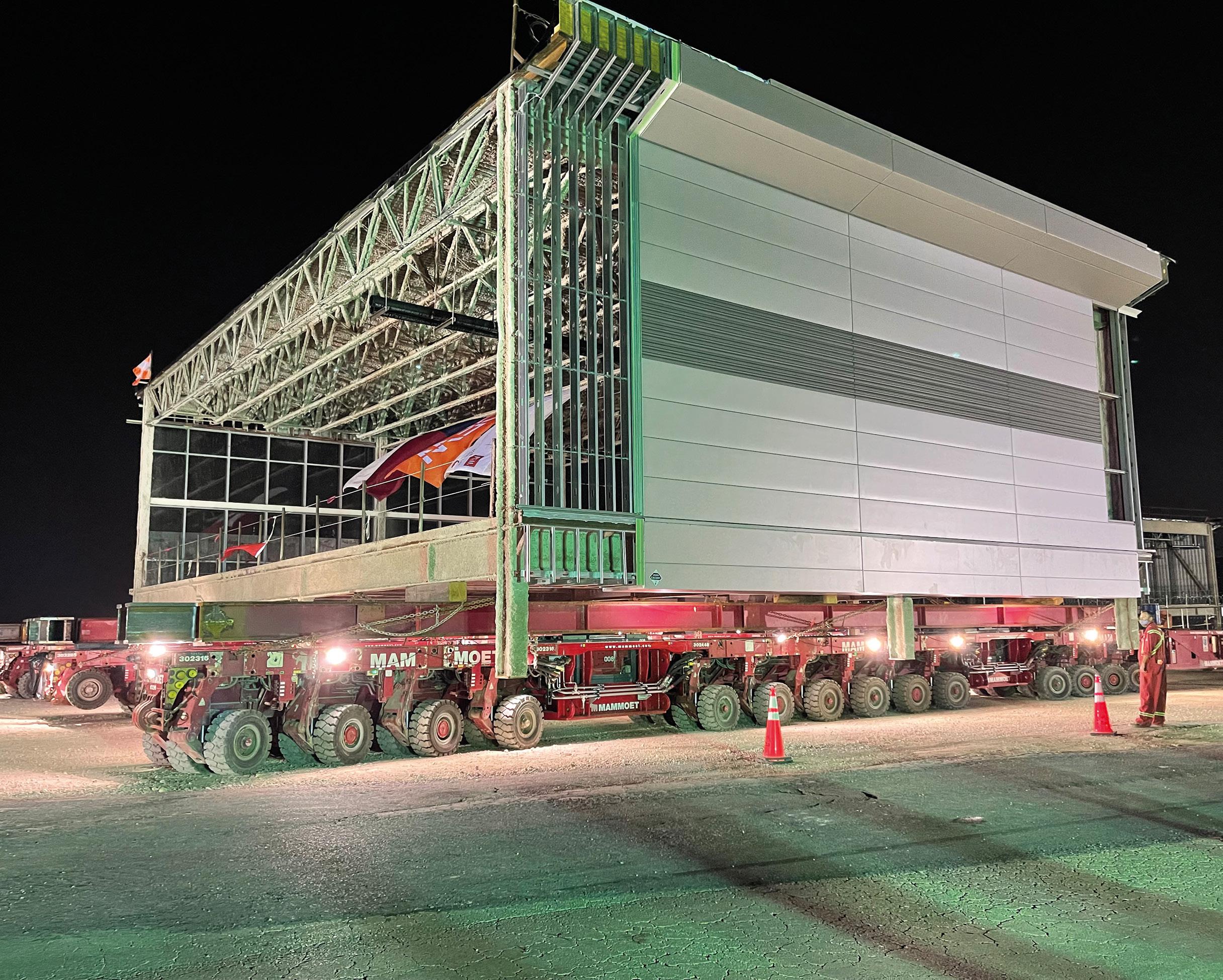
Common, professional operator training standards – using the structures developed for ECOL – will not just raise safety and efficiency but will also help the industry recruit the operators it needs going forward.
Of course, we have been working on improving our industry’s safety and efficiency for many years – that is what ESTA exists to do. But the truly exceptional response to this project underlines the crucial importance of our work in this area. We’d love to hear from you if you want to join in.
The companies helping ESTA in this work are Cometto, DNV, Fagioli, Goldhofer, Mammoet, Sarens, Technip, TII Group, Wagenborg, BMS, Collett, Saipem, Siemens Gamesa and Transportes y Grúas Aguado. Ton Klijn is director of ESTA and chair of the ECOL Supervisory Board. Further information about ESTA can be found at www.estaeurope.eu
*Breakbulk Europe exhibitor. Visit: www.europe.breakbulk.com/home BGSN member
Mammoet puts an SPMT through its paces
11 Breakbulk Magazine Issue 2 2024 breakbulk.com
Credit: Mammoet
MOVERS AND SHAKERS
Highlighting Recent Industry Hires, Promotions and Departures

Fracht Group
Breakbulk Europe Advisory Board member Tim Killen has joined Fracht Group as the Switzerland-based logistics company’s head of growth for projects with overall responsibility for supporting the strategic development of the organization’s global project growth across all key offices, regions, and markets.
Killen boasts more than 25 years of experience working on capital projects across all the main energy related industry verticals for companies including deugro, Abnormal Load Engineering and Alstom Power. Prior to joining Fracht, the executive served as A.P. Moller-Maersk’s global head of growth for project logistics and was also a non-executive director on the board of the Energy Industries Council (EIC).
Port of Corpus Christi
The Port of Corpus Christi, the largest U.S. port in revenue tonnage, has stuck with a familiar face after naming Cindy Bertolami as its new CFO, a role she had been undertaking on an interim basis since September. Bertolami, previously the Texas port’s finance director, takes over from Kent Britton, who last year was appointed CEO.
In her new role, the executive will oversee the port’s real estate, IT, finance, accounting, procurement, and risk management departments. “Cindy brings a wealth of knowledge to her new role as CFO that will be a strong benefit to the Port of Corpus Christi team and our customers,” Britton said. “I have no doubt she will not
only continue this institution’s commitment to financial accountability and transparency, but also continue the push to improve our internal processes and systems.”

CEVA Logistics
CEVA Logistics has appointed Milton Pimenta as its new managing director for Latin America, tasked with driving the company’s growth in the region. Pimenta joined CEVA in 2001 and has held various executive roles – based mainly in Sao Paulo – including in business development and operations. In 2019, the executive left Brazil to become managing director of CEVA in Australia & New Zealand.
“I’m deeply honored and excited to lead CEVA Logistics in the dynamic Latin America region,” Pimenta said. “We have a deep-rooted culture of operational excellence at CEVA, and I’m committed to building upon that culture by delivering innovative logistics solutions and exceptional service to our valued customers. Together with our dedicated team, we will continue to drive growth and success in LATAM, ensuring that CEVA remains a trusted partner for all of our customers’ supply chain needs.”

K2 Project Forwarding
Ida Ullestad Misje has begun a new role as head of operations at K2 Project Forwarding, the Norwaybased logistics venture founded in 2021 by Peak Group and deugro. Misje joins K2 after a 15-year stint at Kuehne+Nagel, where she enjoyed executive roles in marine logistics, projects, and chartering.
“Ida’s experience, network, and positive attitude will be of great benefit not only for our clients but for the whole team,” said Leif Arne Strømmen, CEO at K2 Project Forwarding.
Tim Killen
Cindy Bertolami
Milton Pimenta
12 Breakbulk Magazine Issue 2 2024 breakbulk.com
Ida Ullestad Misje
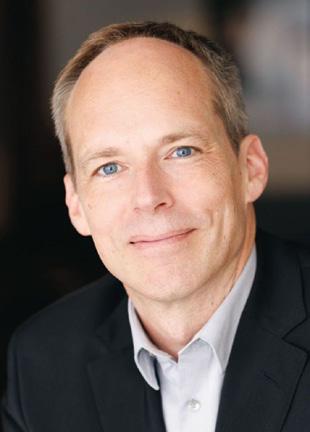
Gebrüder Weiss
Gebrüder Weiss has chosen Torge Runge as new senior operations manager of Industrial Projects & Energy Transport Solutions – North America, overseeing all project cargo operations and related activities. Runge, who will report to the division’s director Michael Ruediger, boasts more than 25 years of experience in project logistics, enjoying managerial stints with companies including Kuehne+Nagel, Conceptum Logistics USA, and deugro.
Runge and Ruediger are based at the company’s Houston office, which is dedicated to specialized projects and project transportation. “We are thrilled to have Torge join the project team,” said Mark McCullough, CEO of Gebrüder Weiss North America. “The caliber of his leadership abilities and operational expertise is second to none, and his vast experience will further enhance the tailor-made logistics solutions and project execution capabilities we provide to our clients.”

Asstra-Associated Traffic AG (Middle East)
AsstrA-Associated Traffic has named Daniel Staples as its new head of industrial projects in the Middle East. Staples will be based in AsstrA’s Dubai office, which was launched in December 2023. The executive boasts more than three decades of experience in the logistics sector –working mainly in the UAE – and has enjoyed stints with several leading players including CEVA Logistics, deugro, and Hellmann Worldwide Logistics.
In this latest role, Staples will focus on expanding AsstrA’s project logistics business throughout the region while overseeing efforts to optimize supply chain processes, foster innovation, and drive sustainability, the company said, adding that his strategic leadership will play a “pivotal role” in shaping the company’s fortunes in the region.
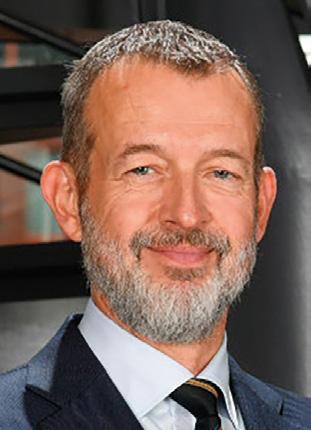
Port of Rotterdam
Boudewijn Siemons has begun his new role as CEO of the Port of Rotterdam Authority, succeeding Allard Castelein, who left the Port Authority last summer. Siemons had been serving as CEO on an interim basis since Castelein’s departure, in addition to his position as COO. The process of looking for a new COO has begun, the Port Authority said.
Siemons, who will serve as CEO for four years, said working at Rotterdam gave him “enormous energy.” He added: “The port of Rotterdam connects Europe with the rest of the world through logistics chains. With our employees and customers, the Port Authority is shaping a future-resilient port that is firmly rooted in the region and the city.” Rotterdam is host port for Breakbulk Europe 2024, happening May 21-23 at Rotterdam Ahoy.

RAK Ports
RAK Ports in Ras Al Khaimah, the northernmost emirate of the UAE, has named Hugh Cox as its new chief commercial officer. Cox, a senior ports and supply chain leader with more than a decade of experience in large infrastructure, ports, and heavy bulk supply chains, previously served as commercial manager for DP World, based in Sydney.
In his new role, Cox will focus on retaining existing customers, attracting new business to the port, developing and delivering new products, and accelerating the organization’s growth strategy. RAK Ports operates at four hubs across Ras Al Khaimah, including Saqr Port, the biggest bulk handling port in the region, and RAK Maritime City, the only freezone in the region to have direct quayside access.
Torge Runge
Daniel Staples
Boudewijn Siemons
13 Breakbulk Magazine Issue 2 2024 breakbulk.com
Hugh Cox
SCANDINAVIA EXPORTS GREEN ENERGY KNOW-HOW TO US

Extending the Hand of Project Trade Friendship Across the Atlantic
By Ilya Goncharov
In the breakbulk world we are on the cusp of a remarkable transition. The expansion of Scandinavian green technologies into the U.S. marks a pivotal moment in our industry. I am thrilled to witness and be part of this transformative journey. The influx of Scandinavian companies, encompassing onshore and offshore firms, forwarders, and shipping companies, heralds a new era of sustainable business and environmental stewardship.
Recent developments have underscored the momentum of this expansion. Eurowind Energy’s establishment of new offices and projects in the U.S. signifies the growing appetite for sustainable energy solutions. Its foray into onshore and offshore wind projects is a clear indication of the expanding renewable energy market in the U.S. Likewise, the Danish Embassy in North America’s recruitment drive for the offshore sector signals a burgeoning industry.
Scandinavian company 3P Logistics plays a pivotal role in this green shift. This spring, we managed a project from Denmark for the Dutch vessel Bokalift 2, which was engaged in a new offshore project in the U.S. This endeavor is a prime example of the increasing logistics challenges and opportunities presented by the green technology wave.
The establishment of a new Vestas plant in New York for blade manufacturing, alongside Ørsted’s significant offshore wind projects, further illustrates the scale of this transformation. These initiatives are not just business expansions; they are beacons of sustainable change.
Ilya Goncharov is global 3PL project manager, BDM, at 3P Logistics Group. Thought Leader
Forming Alliances
A noteworthy addition to this narrative is the formation of the Green Maritime and Port Alliance. This initiative aims to strengthen cooperation and dialogue between the U.S. and Denmark, leveraging expertise in maritime innovation, particularly in areas crucial for the green transition. The alliance brings together a wealth of competencies and capabilities, setting a new benchmark for international collaboration in sustainable maritime practices.
Adding to this green mosaic is the Swedish company Cinis Fertilizer, which is set to construct a new plant in the U.S., reinforcing the country’s commitment to eco-friendly solutions. The presence of Danish companies like FORCE Technology, COWI, DEIF, Dansk Gummi Industri, DIS Creadis, and Global Wind Service fortifies this green bridge between Scandinavia and the U.S. And of course, the new Coastal Virginia Offshore Wind project is the largest contract ever for Bladt Industries.
The backdrop to these expansions is the special energy research agreement between Denmark and the U.S., aimed at accelerating decarbonization efforts. In line with President Biden’s Investing in America agenda, this partnership catalyzes a clean energy industrial revolution across America, with Denmark playing a crucial role.
The increased volume of shipments from Danish shipping and forwarding companies is a tangible indicator of this growth. This surge in logistics demand necessitates innovative, efficient solutions to manage the green technology supply chain.
As industry leaders, we must adapt to and embrace these changes. The expansion of Scandinavian green technologies in the U.S. is more than a business opportunity; it is a commitment to a sustainable future. This green revolution is reshaping our industry, and we stand ready to navigate these exciting new waters.
14 Breakbulk Magazine Issue 2 2024 breakbulk.com


COUNTRY SPOTLIGHT: TÜRKIYE
We spoke to some of our Turkish exhibitors at Breakbulk Middle East about their companies, the project outlook in Türkiye, and what they are looking forward to at Breakbulk Europe 2024.


Hareket Heavy Lifting and Project Transportation
Hareket H ü samettin Aldatmaz, Qatar
Country Manager
Stand 2G50-H51
Road Transport
Tell us a little bit about your company?
We are a 66-year-old company, specializing in engineering, heavy-lift, and project transportation services. We are headquartered in Istanbul, but we have a global presence in CIS countries such as Uzbekistan, Kazakhstan and Azerbaijan. In East Europe, we have a presence in Ukraine, Poland and Germany and in the Middle East region, we have offices in Dubai, Abu Dhabi, Qatar and now we are establishing a new company in Saudi Arabia.
What is the project outlook in Türkiye right now?
For Türkiye, there are a lot of opportunities, especially for renewable energy such as wind turbine installation. We have a key part in this process including transportation and building. In Türkiye, we have experience of up to 6.5 gigawatts capacity from wind turbines. This is not just for us but for other regions as well. We are the turnkey providers for wind energy. Now we are planning for offshore wind energy. There are still studies going on but they will start in around three years. Hareket wants to be a part of this process. There is so much potential.
What should people understand about doing business with Turkish companies?
Most of the business now is heavy project cargo transportation. We are personally working on power plant transportation and nuclear energy. We have finished so many projects just in the last five years.
What are the three most important values to your company?
From the client side the most valuable part is that we are a reliable supplier.
We have so many competitors, but when it comes to complete solutions Hareket has more of an advantage because we have a transportation division, a heavy lifting
division, and a mechanical installation division. It combines all the projects. It means we can provide all services to our clients.
We also make sure we are very professional on HSE requirements. Finally, we make sure our team is very well educated and committed to the highest class.
What is more important, years in business or technical expertise?
Technical expertise. It’s very important for these kinds of global projects because our clients are spending so much money; they’re investing a lot. And if you cannot supply enough expertise on an operation they will fail, and we could lose part of the project. We must pass our technical qualifications because we are doing business globally. Everyone knows everyone.
Do you prefer email, video call or in-person meetings? In-person meetings in this region [Middle East] work well. The people here want to see you, they want to discuss in person and face-to-face.
Hareket is an exhibitor at Breakbulk Europe 2024 (Stand 2G50-H51), what are you looking forward to at Breakbulk Europe?
We are a global heavy-lift and project transportation company; we have branches in Europe. We have ongoing projects in this region. For Breakbulk Europe we want to meet our global clients. It is a show with global attendance, so we are also discussing other regions besides Europe.
Who are you looking to meet at Breakbulk Europe 2024? We are looking forward to meeting EPCs.

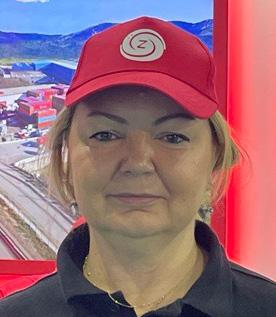
Öznakl¡yat
Filiz Bozat, General Manager
Stand 1F01
Road Transport
Tell us a little bit about your company? Our company is 75 years old. We are experienced in heavy transport, project transportation, warehouse management, and empty container
16 Breakbulk Magazine Issue 2 2024 breakbulk.com
storage. We have our own customs clearance department and container transportation.
What is the project outlook in Türkiye right now? In the near future, there will be a second nuclear power plant, but right now there are no big projects in Türkiye, There are some individual investments for energy power plants and many valuable factories producing transformers, and wind turbines.
What should people understand about doing business with Turkish companies?
We can work 24 hours and 365 days in a year. We can travel very easily because of our location in the world, and we are easily reachable because we have a very good airport in Istanbul. As a country we have so many ports, seaports, and international customs ports. We are like a hub between Europe, the Middle East, and Central Asia. So many transshipments pass through Türkiye so we can handle anything and deliver to anywhere in the world.
What are the three most important values to your company? For our company: trustworthy, innovative, and experienced.
What is more important, years in business or technical expertise?
It depends on each customer and subcontractor.
Do you prefer email, video call or in-person meetings? I am old-fashioned and prefer face-to-face meetings always. They are very valuable to me. But of course, when you think about the current world conditions, we are having so many online meetings. I can have a meeting in China in the morning and a meeting in the U.S. in the afternoon.
Öznakl¡yat is an exhibitor at Breakbulk Europe 2024 (Stand 1F01), what are you looking forward to at Breakbulk Europe? Collaborating with new partners. Building a reputation and spreading our company brand out and of course promoting our services and new equipment.
Who are you looking to meet at Breakbulk Europe 2024? Freight forwarders know us very well because in Türkiye most are located in Istanbul. But of course, the first thing is to find the EPC companies.

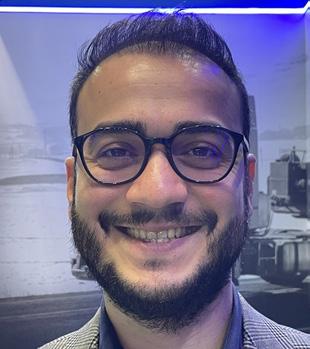
Gürkan Nakl¡yat
Furkan Bayram, Sales Operations Assistant
Stand 1F40
Maritime Transport
Tell us a little bit about your company?
Our company is based in Istanbul, Türkiye. So, we work with road transportation with our oil trucks, our trailers, and other equipment. We are doing transportation from Europe to Türkiye and CIS countries, as well as Russia, Iraq, and Iran.
What is the project outlook in Türkiye right now?
For us it’s good. Türkiye is the center of the world; most products and cargo ships arrive in Türkiye at some point. If cargo is going to CIS countries, it comes to Türkiye first.
What should people understand about doing business with Turkish companies?
We are friendly and trustworthy people.
What are the three most important values to your company? Everything is important.
What is more important, years in business or technical expertise?
Both of them.
Do you prefer email, video call or in-person meetings? Email. Sometimes it is hard to understand each other on video calls or on the phone. But in emails I find it easy.
Gürkan Nakl¡yat is an exhibitor at Breakbulk Europe 2024 (Stand 1F40), what are you looking forward to at Breakbulk Europe?
We like going because the show is so big. We can find whatever we want in Rotterdam. We are really looking forward to it.
Who are you looking to meet at Breakbulk Europe 2024?
Freight forwarders.
17 Breakbulk Magazine Issue 2 2024 breakbulk.com
NEW FACES AT BREAKBULK EUROPE 2024
Get to know some of the new exhibitors at Breakbulk Europe 2024.
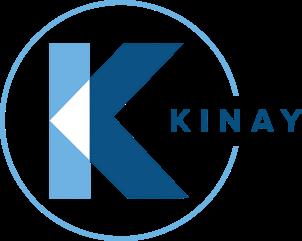
Kınay Transport and Logistics
Özgür Konakçi, Brand and Marketing Manager, Kınay Stand 2H74
Türkiye
Freight Forwarder
1. What is the most interesting thing about your business?
Our company, Kinay Group, epitomizes a comprehensive approach to logistics, offering a spectrum of services through our flagship brand, Kinay, and its distinguished sub-brands. At the core of our operations lie KTL (Kinay Transport and Logistics & KTL International Logistics & Trading Inc.), which provides a seamless array of forwarder services spanning ocean, air and road freight. Complementing this, KC (Kinay Chartering) specializes in chartering services, catering to the diverse needs of our clientele. ARK (A.Riza Kınay Agency) is a beacon of excellence in agency services, ensuring meticulous attention to detail and unmatched efficiency. Additionally, LIMSER signifies our commitment to excellence in port operations and project shipment handling services. Our integrated approach consolidates logistics solutions under one roof, offering unparalleled convenience and efficiency to our esteemed clients.
2. What made your company want to exhibit at Breakbulk Europe?
Our decision to exhibit at Breakbulk Europe stems from a strategic initiative to showcase our expertise in port operations and project shipment handling on a global platform. As a leader in the logistics industry, we recognize the significance of Breakbulk Europe as a premier event for networking, forging partnerships, and staying abreast of industry trends. By participating in this esteemed event, we aim to highlight our capabilities, foster meaningful connections with industry peers, and explore collaborative opportunities that align with our vision for growth and expansion. It is a testament to our commitment to excellence and innovation in the European market.
3. What is your company’s outlook on project opportunities in Europe at the moment?
Our company maintains a highly optimistic outlook on project opportunities in Europe, underscored by our
strategic presence and ongoing investments in the region. With established branches in the UK, Netherlands and Belgium and imminent operations in Italy, we are strategically positioned to capitalize on the burgeoning demand for logistics solutions across Europe. Our expansion initiatives reflect our confidence in the region’s economic prospects and our unwavering commitment to serving our clients with unparalleled excellence. By continually investing in infrastructure, technology, and talent, we are poised to seize emerging opportunities, drive innovation, and set new benchmarks for success in the dynamic landscape of European project logistics.
Musfeld Kran AG
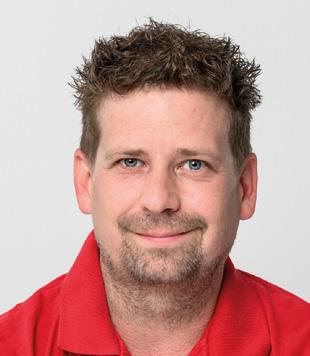
Sebastian Menze, Clerk for Large-Volume and Heavy Transport Warehouse Logistics,
Musfeld Kran AG
Stand 2A72
Switzerland Equipment
1. What is the most interesting thing about your business?
We see ourselves as a full service provider for our customers. We offer national and international heavy transport, customs clearance and cranes for loading or unloading. Thanks to a wide range of locations and strategic partnerships, we can respond quickly to all of our customers’ concerns throughout Switzerland and beyond.
2. What made your company want to exhibit at Breakbulk Europe?
We would like to take this opportunity to introduce ourselves to a wider audience. Switzerland is a rather closed, selfsufficient market. We would like to break through this and establish interesting new contacts with hopefully future partners and customers.
3. What is your company’s outlook on project opportunities in Europe at the moment?
We look positively into the future. Although we expect a slight decline in the number of projects compared to last year, we think that the Swiss market will remain quite stable. We also expect constant to increasing numbers for projects in the
18 Breakbulk Magazine Issue 2 2024 breakbulk.com
energy sector. In contrast, we suspect a decline in the area of mechanical and plant engineering.
A positive thing to mention is that it is much quicker to obtain special permits for heavy transport compared to last year!

Origin Logistics
Burcin Civan, Marketing Communications Manager, Origin Logistics
Stand 2L21
Türkiye
Freight Forwarder
1. What is the most interesting thing about your business?
The most interesting thing about our work is that each project has its own rules, characteristics, strategy and operation.
2. What made your company want to exhibit at Breakbulk Europe?
To come together with all overseas agents that we want to work with. And, to explain that we are a good project company and are recognized all over the world.
3. What is your company’s outlook on project opportunities in Europe at the moment?
We have completed our office organization in Türkiye and have plans to open offices abroad.
We may invest in other parts of Europe depending on future opportunities – places where projects are decided and where large industrial factories are located.


Trans Global Projects
Colin Charnock, Group CEO, Trans Global Projects Group
Stand 2D94
United Kingdom
Freight Forwarder
1. What is the most interesting thing about your business?
The variety! No two days are the same and varying developments, usually positive seem to arrive unexpectedly with pleasing regularity.
2. What made your company want to exhibit at Breakbulk Europe?
Breakbulk Europe is by far the most important such event in the project shipping calendar every year.
3. What is your company’s outlook on project opportunities in Europe at the moment?
We are bullish about project opportunities in Europe at present based on the momentum of developments in energy transition.

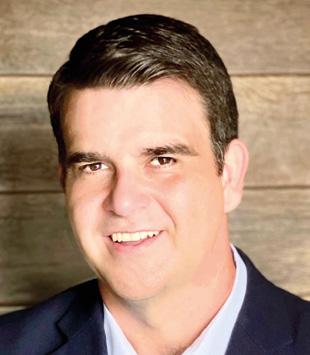
Red Global
Luis Padilla, Managing Director / CEO, Red Global Logística Stand 1A41
United States
Road Transport
1. What is the most interesting thing about your business?
Red Global is heavy haul based on a growing economy in Brownsville, Texas. Our operation yard is located inside the Port of Brownsville that gives us a magnificent spot to support our clients, also we, as a Mexican/American company, are able to move the cargo on both sides of the border and even execute projects in Mexico.
2. What made your company want to exhibit at Breakbulk Europe?
Brand positioning, so that companies in Europe can know that Red Global is a capable company to be able to do business. We have a team of professional people dedicated to providing the confidence and security that every project requires.
3. What is your company’s outlook on project opportunities in Europe at the moment?
Energy sector (wind, power plants, oil and gas), and car manufacturers with press machines.

Welcome Airport Services
Izabela Kamińska, Senior Marketing Specialist, Welcome Airport Services Stand 2H91
Poland
Air Transport
1. What is the most interesting thing about your business? We are the largest ground handling agent in Poland in terms of the number of carriers served. WELCOME Airport Services has been providing cargo handling services to dozens of airlines for nearly 25 years We have the most modern terminals in Poland, where we carry out security checks of cargo and mail based on the Registered Agent status, which we have in all our locations. We are GDP (Good
19 Breakbulk Magazine Issue 2 2024 breakbulk.com
Distribution Practices) certified. As well as Customs Agency (in 2022 we received AEO permit) We handle other types of cargo transported by air. We have high specialized staff in the field of handling dangerous materials (DG), radioactive materials (RRY), perishable materials (PER), live animals (AVI), shipments valuable (VAL) and other types of special cargo (HUM, CRT, COL, PIL). We have equipment to service all types of aircraft, as well as all types of ULD, including 20-foot units and a 30 t high loader. We handle loads using drones.
2. What made your company want to exhibit at Breakbulk Europe?
Breakbulk Europe is the place to be. We hope to meet the biggest players in the industry in one place. In our opinion, the aviation market of Central and Eastern Europe is still underestimated and poorly recognized. Our ambition is to show its potential, convince potential investors of our professionalism and indicate that they may have a reliable partner for expansion in this area.
3. What is your company’s outlook on project opportunities in Europe at the moment?
We are a European company, so we already operate on this market. In our part of Europe, we see potential in the development of the market in Ukraine after the end of the war. We count on the creation of a large hub airport in our country and the resulting dynamics in the development of new transport possibilities. Welcome Airport Services invest in innovation and infrastructure. We have plans related to the observed development of transport using drones. We initiate comprehensive solutions by developing our own road transport fleet and comprehensive customs services.
NEW EXHIBITORS AT Breakbulk Europe 2024
AeKo Dynamics 2J74 IT Germany Alatas Crane Services Worldwide 1E41 Equipment United Kingdom Aprojects nv 2D21 Freight Forwarder Belgium Ast Uluslararasi Tasimacilik Ve Dis Tic Ltd 1L25 Freight Forwarder Türkiye Baggio Shipping & Chartering - Multimodal Logistics 1G10 Freight Forwarder Italy Best-Hall 2E71 Industry Related Services Finland Block 1H31 Air Transport Finland Bruhat Logistics 2E84 Freight Forwarder Singapore Cansu Warehouse, Port & Logistics Services 2H34 Industry Related Services Türkiye Caucastransexpress 2F101 Freight Forwarder Georgia Centrimex 1D51 Freight Forwarder France Chinaland Shipping Pte. Ltd. 2E65 Freight Forwarder Singapore Chirey Global Logistics Group Limited 1J50 Freight Forwarder China Clockwork Logistics 2C89 IT United States Dahlia Technologies Pte. Ltd. 1L51 IT Singapore Dataloy Systems 2M25 IT Norway Delta Shipping Agency 2J24 Marine Transport Romania DeMase Trucking Co., Inc. 1K52 Road Transport United States dteq Transport Engineering Solutions GmbH 2L14 Freight Forwarder Germany
Company name Stand number Sector Country 20 Breakbulk Magazine Issue 2 2024 breakbulk.com
NEW EXHIBITORS AT Breakbulk Europe continued
ESL shipping 1F47 Marine Transport Finland Faisal M. Higgi & Associates Co. Ltd. 2F80 Industry Related Services Saudi Arabia Friday & Co Shipbrokers B.V. 2H20 Industry Related Services Netherlands Fuchs a Terex Brand 1D50 Equipment Germany Global Soluções em Logistica 2A45 Industry Related Services Brazil GreenRouter 1M22 IT Italy Hapo International Barges BV 2C83 Freight Forwarder Netherlands Heavy Haul Solutions 1G50 Equipment United States Industrias Murtra Cadenas, S.L. 1J43-H44 Equipment Spain ISA / CNAN EL DJAZAIR 1L10-K11 Marine Transport Belgium Italian Trade Agency & Assoporti 2G91 Industry Related Services Italy Itg Bohwa Shipping Limited 2M51 Freight Forwarder China Kınay Transport and Logistics Inc. 2H74 Freight Forwarder Türkiye Leon Vincent Overseas 2C90-D91 Freight Forwarder France Logiswift DWC LLC 1C51 IT United Arab Emirates Marguisa 2F74 Marine Transport Spain Musfeld Kran AG 2A72 Equipment Switzerland Noord Nederlansche P&I Club 1C24 Industry Related Services Netherlands Origin Logistics 2L21 Freight Forwarder Türkiye Palco Transportation 2L24 Road Transport United States Port de Sete 1J40-H41 Ports & Terminals France Promartime International 1C45 Freight Forwarder France Red Global 1A41 Road Transport United States Relopack Solutions Sp. z o.o. Sp.k 1A53 Industry Related Services Poland Rongtua Shipping Group Pte.ltd. 2J54-K55 Marine Transport Singapore ScLashing Shanghai Co.,Ltd 2M02 Freight Forwarder China Seashell Logistics Pvt Ltd. 1F55 Freight Forwarder India Shanghai Honghao International Freight Forwarding CO.,LTD. 2M08 Freight Forwarder China SIA Bolivar Logistic 1F45 Freight Forwarder Latvia SIBRE 1B50 Equipment Germany Simex Transport and Forwarding B.V. 2E103 Freight Forwarder Netherlands SSA Marine 2E81 Marine Transport United States TAD 2M35 Freight Forwarder Ukraine Trans Global Projects 2D94 Freight Forwarder United Kingdom Transporter Industry International Sales 2M11 Road Transport Germany TSA Agency Sweden AB 2J80 Ports & Terminals Sweden VOSS International 2A71 Road Transport Germany Welcome Airport Services 2H91 Air Transport Poland
Company name Stand number Sector Country 21 Breakbulk Magazine Issue 2 2024 breakbulk.com

BREAKBULK MIDDLE EAST BY THE NUMBERS • ABB Adani Group • Air Liquide Air Products • ArcelorMittal Projects Baker Hughes Energy • Bechtel Corp. • Bharat Petroleum • Calik Energy • Caterpillar SARL • CB&I • China Petroleum Engineering & Construction Desmet • Elsewedy Electric Emirates Steel • Enerflex Energy Envision • Fluor • General Electric • Hitachi Energy • Hyundai Engineering • Infinite Mining & Energy • Lamprell Energy • Larsen & Toubro Linde Engineering • Ma’aden Macsteel International • Maire Tecnimont McDermott Middle East • National Oilwell Varco • NMDC Energy • Oman & Etihad Rail • Petrofac • Samsung Engineering • Saudi Aramco • SLB Shell • Siemens Energy Subsea 7 • SULB Sumitomo Corporation • Technip Energies • Tecnicas Reunidas • Tecnimont • Unisteel International • Wartsila • Westinghouse 301 77% Breakbulk Global Shipper Network SHIPPERS THE DECISION-MAKERS EVERYONE WANTS TO MEET 7,197 2,406 157 Companies Exhibitors 101% Rebooked for 2025 (11% increase compared to 2023) Attendees of shippers attended the event to source new suppliers and network Watch the Official Video here 22 Breakbulk Magazine Issue 2 2024 breakbulk.com 127 Countries Top 4 countries: 1. UAE 2. India 3. Saudi Arabia 4. United Kingdom Including: Top 4 countries accounted for Türkiye Oman Germany Pakistan Egypt Qatar Singapore China Netherlands United States Spain Italy Belgium France 73 % attendance UNLOCKING THE GATEWAY TO PROJECT CARGO & BREAKBULK ROUND THE WORLD
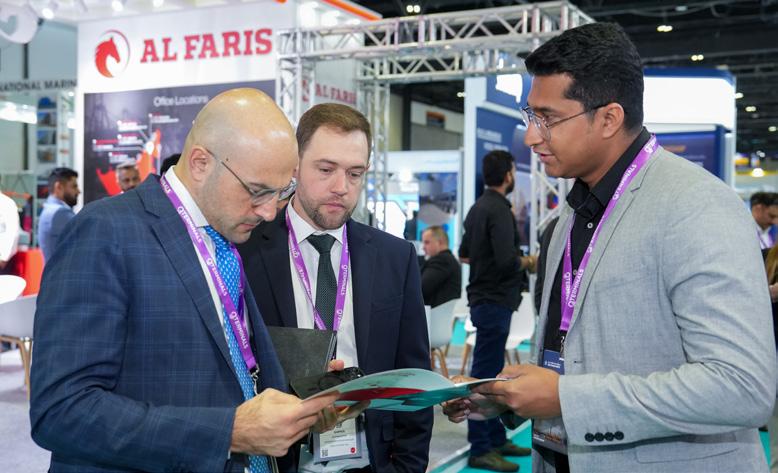
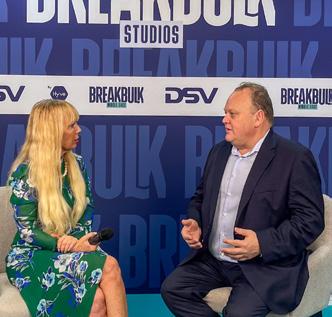


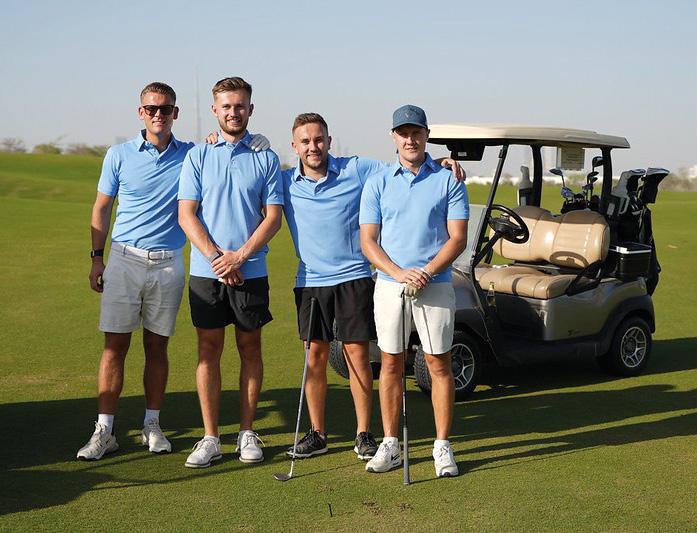
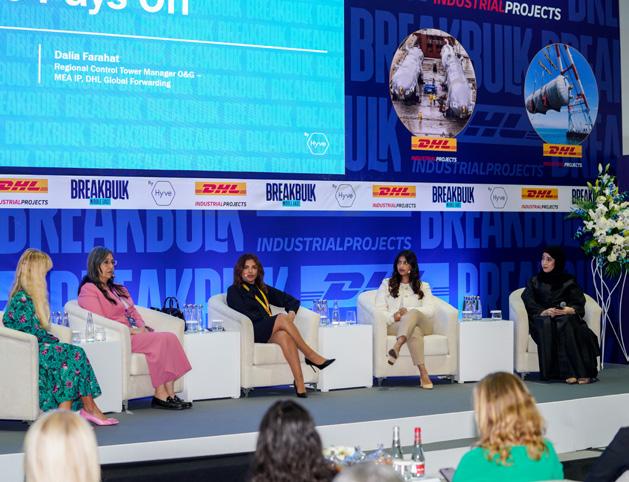
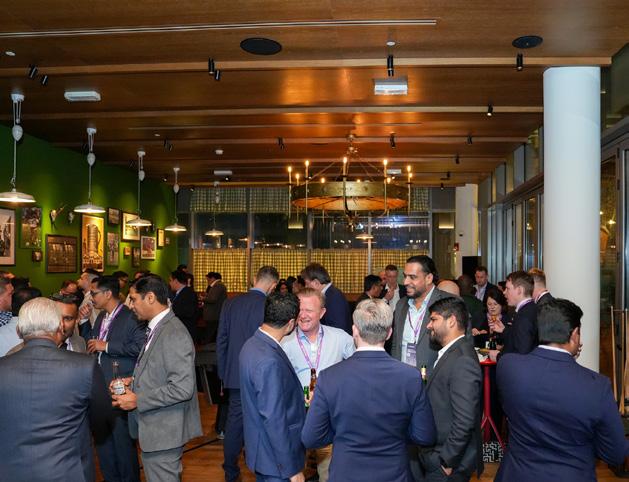



BREAKBULK STUDIOS: CONVERSATIONS HEARD AROUND THE WORLD... THE RIGHT AUDIENCE FOR NEW BUSINESS TOP SECTORS BUYING POWER 35 % 35 % 19 % 31 % 5 % 5 % Freight Forwarder Final Purchasing Authority Maritime Transport Recommend/Specify EPC Manufacturer JOIN 18,000+ AND FOLLOW BREAKBULK EVENTS & MEDIA ON LINKEDIN FOR ALL THE LATEST NEWS TOP INTERVIEWS How Projects Are Transforming Saudi Arabia Lars Greiner, Managing Director/ RSGT Multipurpose Business for Red Sea Gateway Terminal DHL Strategy Provides Stability in an Uncertain Market Peter Dudas, Head of Global Commercial and Tendering StrategyIndustrial Projects for DHL Global Forwarding Técnicas Reunidas: Manageable Challenges for Huge Project Growth Across GCC Alberto Solana, Managing Direct Head of Purchasing for Spanish EPC Tecnicas Reunidas NETWORKING BEYOND THE EXHIBITION FLOOR 240 100 200+ Golfers in attendance attended GOLF DAY WOMEN IN BREAKBULK BREAKFAST NETWORKING WELCOME RECEPTION AT 25 HOURS HOTEL Sponsored by Sponsored by See them all on our YouTube Breakbulk Middle East playlist https://youtube.com/playlist?list=PLQ4mPLfWAHh05azvHGqT2qdQeM_TuN0pZ&si=2CrSbzzq5o6p-Vuf 23 Breakbulk Magazine Issue 2 2024 breakbulk.com
BREAKBULK SPRING GIFT GUIDE
Get ready for spring!

Spring Medley from Snackmagic
US$50
Celebrate the season’s fresh flavors of citrus, florals and vegetables to help put a spring in your step. www.snackmagic.com

Standard Baggu in Orange Tree Periwinkle
US$14
Carry everything in style this spring. www.baggu.com

ban.do - Puffy Picnic
Blanket in Green Gingham
US$70
A quilted nylon picnic blanket with a velcro closure so you can roll it up and bring it anywhere. www.bando.com


Chamberlain Coffee Cold Brew Coffee Starter Pack
US$44
A perfect way to cool off as the temperatures start to heat up. www.chamberlaincoffee.com
Kite Stripes - Sun Squad
US$8
High-flying fun for the little ones!
www.target.com/p/kite-stripes-sun-squad-8482/-/A-88914785
24 Breakbulk Magazine Issue 2 2024 breakbulk.com

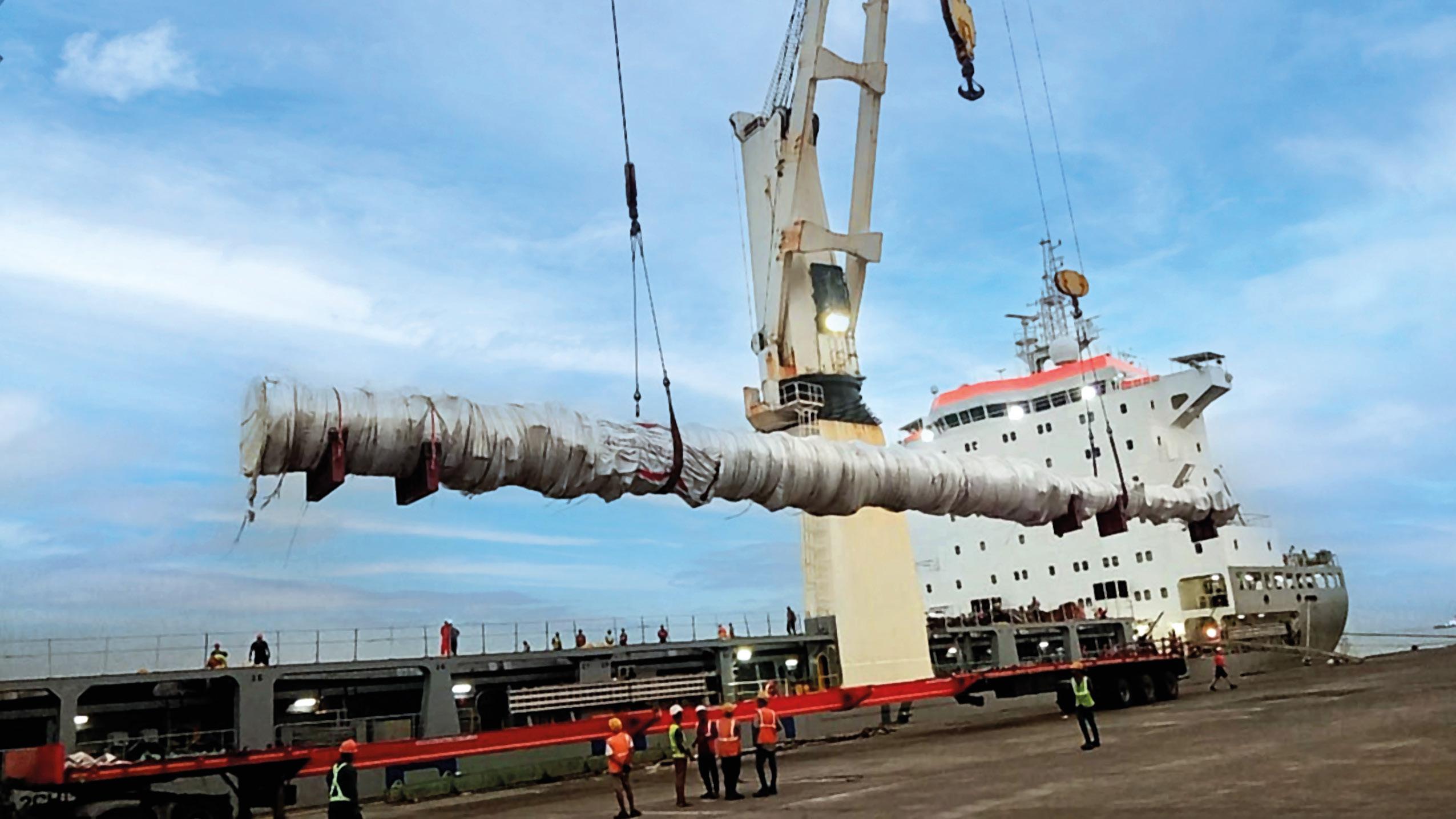


HOW CHINA PLUS DERISKS SUPPLY CHAINS

Revisit Sourcing Strategies to Reduce Overdependence
Apple, Samsung, Sony and Adidas have all moved some of their manufacturing activities from China to elsewhere in South-East Asia – as UNCTAD reported in its Review of Maritime Transport towards the end of last year – due to rising labor costs in China and risk management considerations.
Summary:
Project cargo companies looking to reduce the risks of overreliance on China for shipbuilding and manufacturing can shift to a China Plus One strategy to diversify sources. Raw material sourcing is ripe for change, while nearshoring and reshoring could lead to a major shift in supply chains over the next five years.
“A strategy adopted by some companies for diversifying supply sources and reducing overdependence on China is the ‘China Plus One’ strategy, where companies expand outside China while still maintaining a presence there,” UNCTAD said. For example, the share of U.S. container imports from Vietnam increased from 4 percent in 2017 to 8 percent in 2022, while India’s share moved up from 3 percent to 5 percent. China’s share dropped from 40 percent in 2017 to 31 percent in 2022.
According to 4D Supply Chain Consulting, an independent supply chain consultancy focused on the heavy-lift market, there has also been a shift in the project cargo sector, as shippers are concerned about the risk of overreliance on one country when it comes to project sourcing.
By Felicity Landon
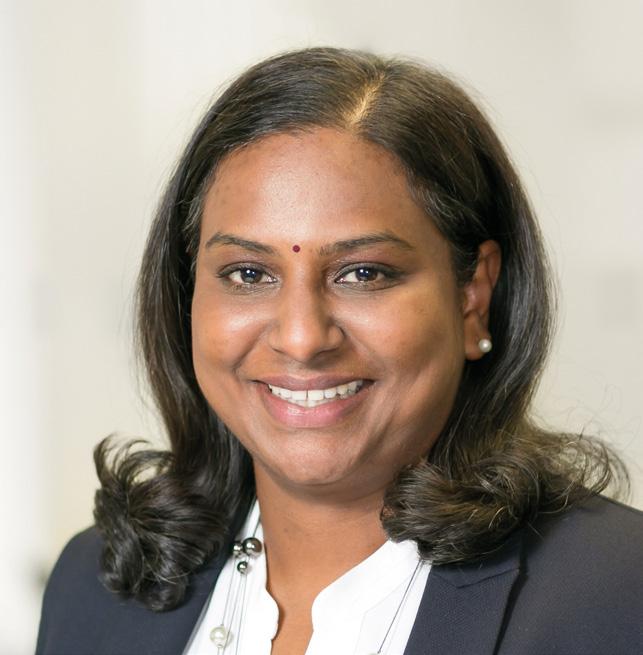
“There is definitely a desire to adopt the China Plus One strategy, or to find new sources, but how much it affects project budgets is a big question,” said Vilasini Krishnan, vice president of 4D. “How soon it will happen, where possible, is where the complexity is.”
26 Breakbulk Magazine Issue 2 2024 breakbulk.com
Vilasini Krishnan
ONE CHAINS

For starters, with the cost of labor increasing in China, there is money to be saved by sourcing from elsewhere in South-East Asia, she said; but in the medium term, we could see far more radical change.
While project cargo owners are – at present – largely sourcing components from the same places, their sourcing of raw materials is shifting, said Thomas Skellingsted, president of 4D. “During Covid-19 we saw that sourcing moved from China to other Asian countries, including India. But now we are also seeing things moving across to the Americas. The U.S. is sourcing much more locally or regionally. There are governmental incentives to do so. Projects’ components are still coming from the normal suppliers –it’s more about where these suppliers are sourcing their raw materials
from. The U.S. is also talking about building a free trade zone close to Mexico, which is another factor.”
Shifting Supply Chains
Skellingsted predicts that in five years’ time, supply chains will look very different, with a huge shift to nearshoring or even onshoring. The crisis in the Red Sea, with ships taking the long route around South Africa to avoid the Suez Canal, and the limits of navigation caused by drought in the Panama Canal, could well accelerate these moves. There is also the concern of the potential introduction of emission trading systems similar to the EU’s in other parts of the world, creating challenges for the shipping industry.
Skellingsted said that the pandemic served as a wake-up call for many shippers who hadn’t perhaps given sourcing that much thought before. “The way in which China handled Covid was when companies found out how vulnerable they were,” he said. “There are also rumors that some parts of China are going into recession financially. Is that also because of the China Plus One trend? Possibly.”
Most of 4D’s clients are within the heavy-lift industry – cargo owners looking for support and transparency in their supply chains for projects, he said. “We have clients who have no idea about the cost of shipping. When a project requires 500,000 tonnes of steel to be shipped from India or China, sometimes logistics is the last scope to be considered.
“You’re talking half a million dollars for breakbulk to go around South America instead of through the Panama Canal. The same thing is now happening with the Suez Canal; all the multipurpose vessels are going south around the Cape of Good Hope, which means they are out of sync by 12-14 days. That is delaying things within the project business and adding to everything else that is going on.”
The current supply chain model for containerized consumer goods is based on “warehousing on the ocean,” Skellingsted added. “Of course, within breakbulk we are also trying to optimize the usage of the vessels because there is a lack of vessels. Every year vessels are being taken out of service and we do not have the same number coming into the market. For shippers, therefore, it is a carrier’s market, not a buyer’s market.”
Capturing Risk
4D advises its shipper clients on landed cost, emerging trends, changing concepts and “seeing what we can do now,” he said. “For example, procuring items in Brazil and importing directly into the U.S. instead of from India.”
Krishnan added: “The risk analysis we do is essential. We can capture risk and projected risk, but we can’t predict unseen issues like war. However, we can at least provide options – not putting all your eggs in one basket; consider what are the alternatives if something goes wrong. We can build in contingency plans.”
And that appears to be the crux of it – projects can be meticulously planned in advance, but having a back-up plan seems to be increasingly essential.
Skellingsted said: “Take the insurance of cargo going through Suez – prices have gone through the roof. So the budget you had one year ago, you can throw out now. Depending on the project, some shippers do pin down the shipping costs in advance but, as I said, it’s a carrier’s market. The carrier will come back to the freight forwarder and say, ‘we can’t do this’ and effectively tear up the contract.”
Covid made it painfully clear where shippers did not have contingency plans or, indeed, any visibility as to where things were coming from and how, Krishnan said.
Of course, when it comes to specialist projects requiring specific, complex and sophisticated modules or units, for example,
27 Breakbulk Magazine Issue 2 2024 breakbulk.com
Global
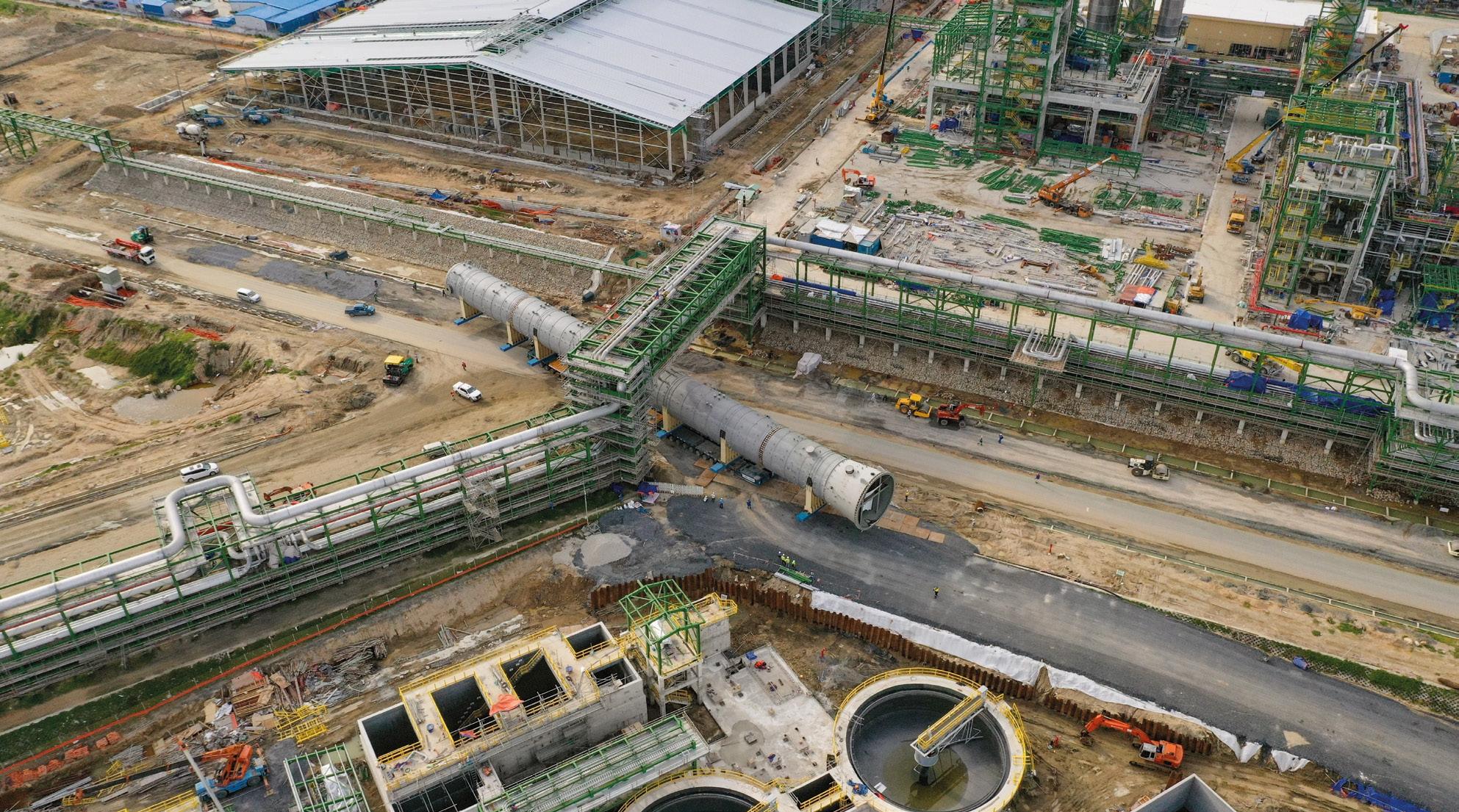
there is often a limited choice of ‘baskets’ to put the eggs in.
“In project procurement, there is a limited number of manufacturers/ countries that would supply items to the standard the project developer is looking for,” Krishnan said. “But we can look for a ‘contingency pipeline’. If a certain manufacturer is not up to standard, what can we do as a partnership to ensure that standard is reached? In other words, if it’s not 100 percent of what you are looking for but there is potential, it’s probably worth investing time and effort in the longer-term to bring the production up to standard. You see it in vendor management of project forwarding; the same can be applied in manufacturing and in logistics.”
Alternative Bases
Are companies looking to open new offices in strategic alternative sourcing option countries?
“The big companies already have offices in many countries,” Skellingsted said. “The medium-size companies are not going to have this set-up, especially in the short-term, and
the small companies are struggling as well due to the fact they are not present in these countries.”
This is an issue 4D is looking to tackle, he said. “We use our network to help our clients find alternative solutions. With some certainty, I can say that, in the future, you will see a lot of companies joining forces to match up skills and ability and a lot of consolidation on projects going forward.”
This is a new concept for 4D, he said, bringing together large and small companies to work together. For example, an oil major might have a project in Guyana. The company goes to its regular suppliers, but rates are high and it is difficult to find a supplier for a certain product. In this scenario, another company may have the relevant product in Brazil but has never supplied to Guyana or to the oil major concerned.
“Bring the two together and you get the product at the right time in the right location.”
4D is setting up a register of project companies and suppliers, region by region, to join up these dots, starting with a pilot of 15 companies.
However, Skellingsted is frustrated by the secrecy of the project cargo freight forwarding world: “We all know who’s who, who’s doing what. Let’s break down those walls, and work together. Traditionally, companies keep everything secret because they are afraid of losing out and afraid of the competition, so there is no transparency. But companies can sign NDAs so each party is still protected. They can work together and share the profit. Ultimately, this is necessary to weather the challenges that the industry is currently facing.”
Shipbuilding Concerns
From Drewry’s point of view, the biggest concern around China for the project cargo sector is the concentration of shipbuilding in the country’s yards.
“When looking at MPVs, about 85-90 percent of the orderbook in deadweight-ton terms is being built in China,” said Peter Molloy, senior maritime research analyst. “These are our heavy-lifters, all the project vessels that we are expecting we will need to do energy products and the green transition. So, the whole
28 Breakbulk Magazine Issue 2 2024 breakbulk.com
Global
A deugro petchem move to Long Son, Vietnam. Credit: deugro
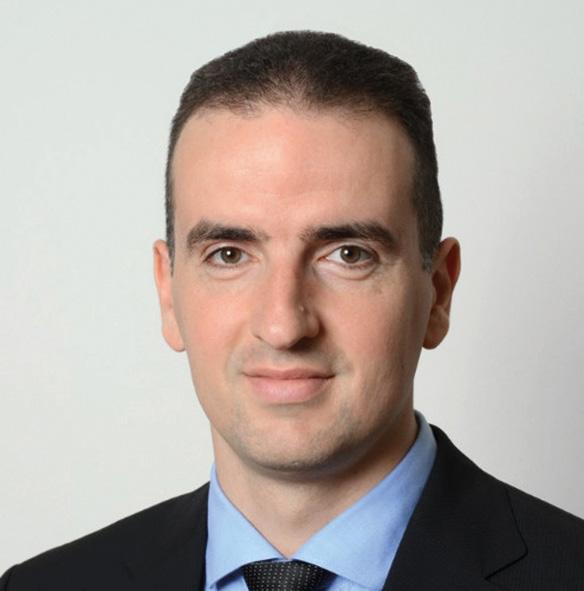
[energy transition] plan is based on the capacity of ships coming out of China.”
A recent analysis of delivery rates of ships from European and Chinese yards showed the Chinese deliveries slipping quite a bit more, Molloy said. “We do get concerned that there is an overreliance on China and that is before we even get down the road of geopolitical concerns. If China falters in any way, the knockon effect on several projects and on the global plan for the environment becomes quite concerning.”
This focus on China is to the detriment of the skillset that should be spread across other countries and therefore spread the risk, he added. “These are highly specialized and advanced vessels where there is going to be a saving by going to China – but the saving is maybe not as big as you think.”
China has a huge share in shipbuilding across all categories. As Dr. Ferenc Pasztor, deputy head of research at Drewry, said: “With container ships and LNG vessels, the shift to China has just started. Most of the tier one yards in Korea and Japan have been taken up for either container ships or LNG carriers for the next four years.”
Hence, he said, any attempt to move away from China and build large MPVs in other countries would likely run into trouble. Not only are yards in Korea or Japan ‘maxed out’ but MPVs have mostly not been built in these countries for nearly ten years. “The last deliveries were 2014-15 and it was only a handful of vessels. The shipbuilding experience
in the large MPV segment outside China in the last decade is basically gone.”
Early Delivery Benefits
Molloy’s concern is with the slow nibbling away of the Chinese economy. If things slow down, these ships may not be delivered. “People will say they are building their ships but what if the ships don’t arrive in time as we try to get projects started?”
Time is money, he added. A ship owner might go to China and be told they will have a two-year wait for a newbuild. What if that vessel could be built elsewhere for an additional US$2 million-3 million? “The question is, are you going to make an additional US$4m or US$5m by having it earlier? Or maybe having the vessel sooner enables you to get a two-year contract.”
There may be a margin of cost saving by building in China, Molloy said. “But it’s about having the ship or not. You will make up that margin very quickly if you have a trading vessel [more quickly].”
When it comes to sourcing patterns for actual project components, Pasztor
and Molloy pointed out that in general, these projects are not centered on one location. Most large projects source the various components from different manufacturers/ countries in any case. Meanwhile, steel production is well spread out.
“I don’t see China Plus One being a concept for a large project because it’s rare for full manufacture to happen in one place, except for the final assembly.”
Pasztor suggested that much of the China Plus One idea is ‘just a kind of a show’. “I don’t think there will be a complete move away from China. It will always be superficial. It will be Chinese components going into Vietnam, being assembled there and shipped to the U.S.
“The U.S. will buy fewer things directly from China, buying them instead from Mexico. But where does Mexico buy the components from? China! So much of this nearshoring merely adds additional players and steps into the supply chain.”
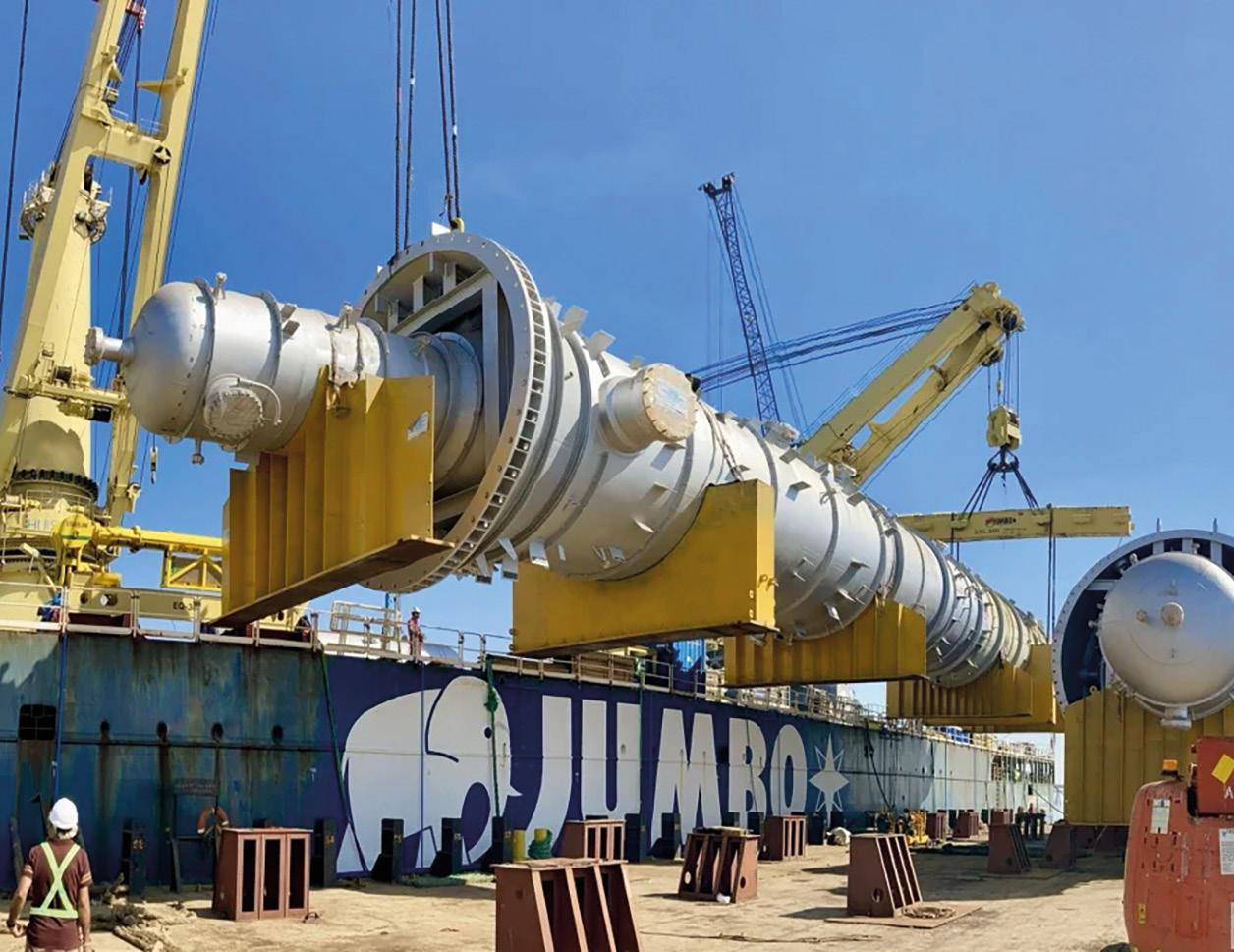
29 Breakbulk Magazine Issue 2 2024 breakbulk.com
Felicity Landon is an award-winning freelance journalist specializing in the ports, shipping, transport and logistics sectors.
Global
Dr. Ferenc Pasztor
The Jumbo-SAL-Alliance transported units for the Basra Refinery Upgrade Project from facilities in China, India, Thailand and Korea.
Credit: Jumbo-SAL-Alliance

PREPPING FOR A HYDROGEN HEYDAY
Wider Adoption a New Business Line for Project Cargo Specialists
By Luke King
Project forwarders are increasingly preparing to serve the hydrogen industry, buoyed by substantial investment in clean technology and favorable international environmental policies.
In Europe, shipping and logistics group GAC has opened a new office in Stade – with one eye on future hydrogen
Summary:
New facilities, projects, investments, and policy frameworks are combining to promote global clean hydrogen production and use. From Canada and Saudi Arabia to India and Europe, hydrogen projects are taking shape across the world.
investment in Germany. “As hydrogen grows in popularity and becomes more commercially viable as an alternative fuel source, there is no question that hydrogen production – especially the setup of new hydrogen production facilities – will generate business for companies involved in the project cargo supply chain,” Thies Holm, general manager of GAC Germany, told Breakbulk “Components for the plants are not produced onsite and their dimensions usually make them perfect for handling as project cargo. As the magnitude of production grows, those components will get even bigger. This is comparable with oil and gas refining projects we have worked on in the past, which saw multiple shipments being transported from specialized facilities around the
world. We would expect to see a similar scenario for future hydrogen projects.”
Explaining the rationale behind January’s office opening in Stade, Holm elaborated: “Germany has made a long-term commitment to developing renewable energy sources, including hydrogen, and the Port of Stade is set to play a key role in the construction of production facilities in the region. Aside from the environmental appeal, the economic argument for hydrogen is also becoming more compelling.
“Production costs are falling, more advanced technologies are being developed, and federal initiatives such as the National Hydrogen Strategy are making hydrogen significantly more appealing to investors. GAC Germany has had ship agency services in the
30 Breakbulk Magazine Issue 2 2024 breakbulk.com
Global
GAC has opened an office at the port of Stade, Germany.
Credit: Ulrich Wirrwa

region for some time, culminating in the decision in late 2023 to set up a permanent base at the port to support Germany’s long-term targets.”
Holm said he was “confident” about the development of hydrogen plants in the coming years, pointing to Germany’s National Hydrogen Strategy, which includes the completion and conversion to hydrogen of 1,800 kilometers of pipelines by 2027/28. Existing onshore liquefied natural gas (LNG) terminals are also supposed to be hydrogenready, enabling them to switch promptly once LNG imports are stopped.
“To meet this expected rise in demand, Germany’s port infrastructure must be expanded and improved in the coming years. We expect the Port of Stade to become a critical import location for hydrogen and other renewable energy options, hence our decision to open an office there. This switch to hydrogen will not happen overnight but we have already begun our preparations to be ready when it does,” Holm concluded.
COP Accord
New hydrogen projects could soon be underway across Europe, the Americas, Asia Pacific and MENA following the signing of a strategic development agreement at the UN’s Climate Change Conference, COP28, held in Dubai last December.
Masdar, also known as the Abu Dhabi Future Energy Company, said it would team up with Hy24, the
world’s largest clean hydrogen pureplay investor, to spend up to US$2bn on large-scale green hydrogen projects in various global markets.
The two companies agreed a framework to explore the development and investment in projects along the “Power-to-X value chain”, which involves producing renewable power converted via electrolyzers into green hydrogen and, subsequently, its derivatives such as green ammonia, e-methanol, sustainable aviation fuel and liquid hydrogen.
“Hydrogen is unanimously recognized as one of the most promising tools for the energy transition, a view that has been reinforced at COP28,” said Pierre-Etienne Franc, co-founder and CEO of Hy24. “Our joint agreement aims to unlock investments for some of the largest and most strategic green hydrogen projects in the world. We need to see more capital allocated by institutional investors and sovereign wealth funds to climate action.”
Also in December, the UK said it would support 700 new hydrogen jobs with funding worth £2bn over the next 15 years. The UK will back 11 major projects to produce green hydrogen via electrolysis and has confirmed suppliers will receive a guaranteed
price from the government for the clean energy they supply. Energy secretary Claire Coutinho said the funding would help deliver 125 megawatts (MW) of new hydrogen for businesses, including PD Ports in Teesside, which will use hydrogen to replace diesel in their vehicle fleet, decarbonizing port operations from 2026.
Europe’s Hydrogen Backbone
The European Union, meanwhile, adopted the 6th list of Projects of Common Interest, or PCIs, in November. The list details initiatives which the European Commission has identified as key to integrating energy infrastructure in the EU and are therefore eligible to receive public funds.
For the first time, the list includes 65 hydrogen-related projects, though most of those selected are located in Western Europe and just two were offshore pipeline projects. “The inclusion of hydrogen projects for the first time in a PCI list is a major step forward and shows Europe’s commitment to lay the foundation of a European hydrogen backbone,” said Daniel Fraile, chief policy officer at Hydrogen Europe, an organization which seeks
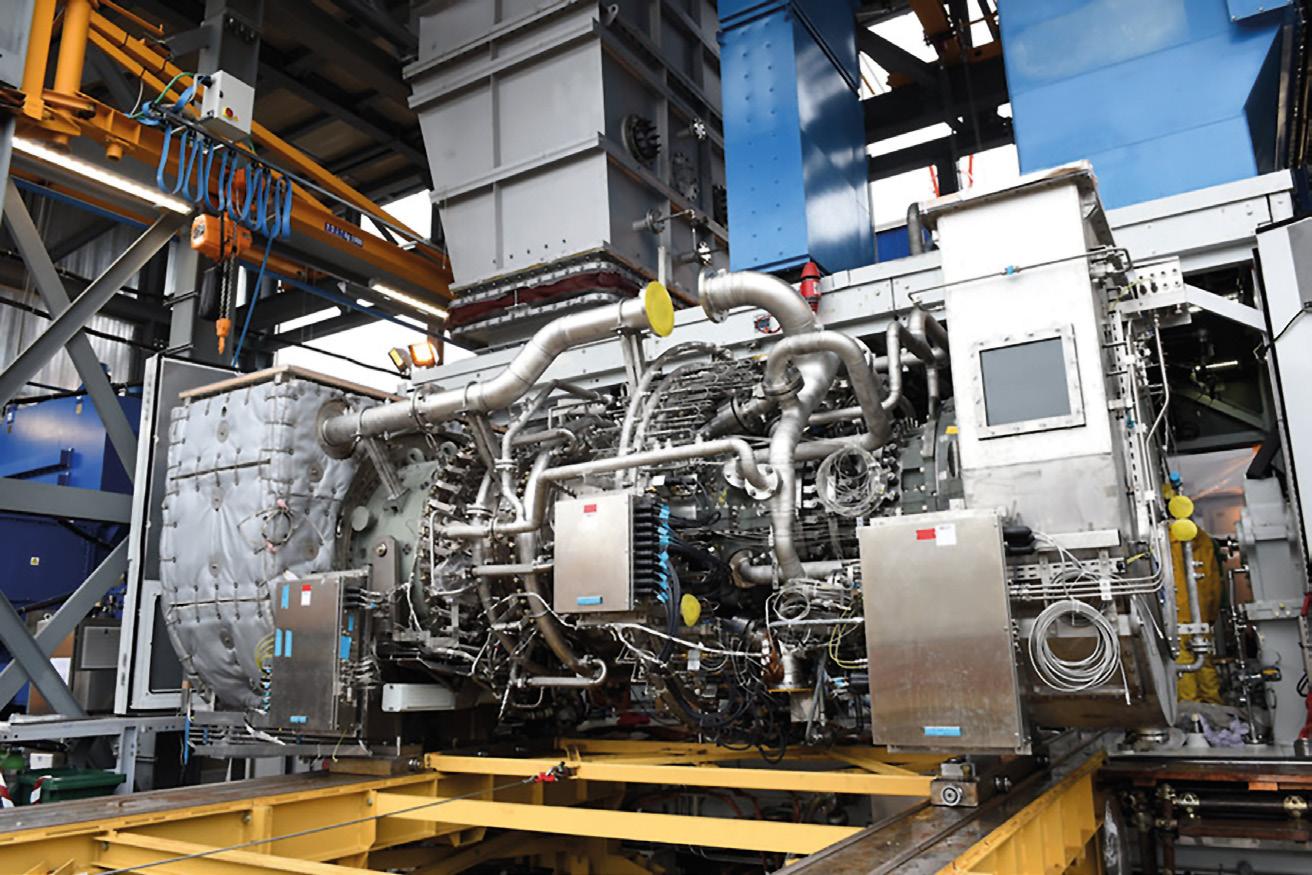
31 Breakbulk Magazine Issue 2 2024 breakbulk.com
Global
A Baker Hughes NovaLT16 gas turbine. The energy technology company claims to have achieved a number of “milestones” for the development of the hydrogen industry. Credit: Baker Hughes
Thies Holm
Credit:

to promote the sector. “This first selection process is also a valuable lesson learnt. We will be working with our members to ensure the next list includes more diversified projectsboth type wise and geographically.”
As Breakbulk went to press, representatives of hydrogen associations in nine central European and Baltic states signed a cooperation agreement in Paris, pledging to develop the hydrogen sector in the region. The agreement was concluded at February’s Hyvolution conference by the 3 Seas Hydrogen Council, which plans to represent the sector in the European Commission and Parliament. Its aims include supporting regional funding and encouraging joint hydrogen projects in the participating countries, which include Poland, Czechia and Hungary.
Further afield, India’s largest stateowned oil and gas company, ONGC, said it would spend US$10bn on two green hydrogen and ammonia projects by 2035, plus US$12bn on installing 10 gigawatts (GW) of renewable energy assets by 2030. ReNew Power, one of India’s largest renewable-energy developers, has reportedly proposed a 2GW green hydrogen and ammonia project in the southwestern state of Kerala.
Hydrogen ‘Milestones’
In January, Baker Hughes, the Houston, Texas-based oilfield services and energy technology company, said it had achieved a number of “milestones”
that it said would support the entire hydrogen value chain – from production to transportation and utilization.
Among the developments announced was the opening of a new hydrogen testing facility in Florence, Italy – a manufacturing site that will be used to further support the deployment of hydrogen-ready technologies and serve as a hub for Baker Hughes’ collaboration with its hydrogen customers.
The company, which began working on hydrogen projects in the 1910s, said it had recently concluded manufacturing and testing of its NovaLT™16 hydrogen turbines for Air Products’ Net-Zero Hydrogen Energy Complex in Edmonton, Canada. The turbines underwent full load testing at the newly unveiled Florence facility and form part of a family of turbines that can be deployed for a variety of industrial applications, including combined heat and power, as well as for pipeline and gas storage operations.
Baker Hughes also reported progress on another Air Products’ hydrogen project, with the delivery of the first two trains of advanced hydrogen compression solutions for the NEOM project in Saudi Arabia, the largest green hydrogen project in the world. It has recently expanded its manufacturing site in Modon, Saudi Arabia, to further support the delivery of projects in the country, including NEOM.
“These low-carbon and carbon-free energy advancements illustrate how
the urgency of the energy transition has transformed customer relationships into comprehensive partnerships for innovation across several projects,” said Lorenzo Simonelli, chairman and CEO of Baker Hughes. “There is no path to net-zero without innovation and collaboration, and our work with customers and partners, including Air Products, is proving the validity of the hydrogen economy.”
NEOM Shipments
The NEOM project is already generating work for multipurpose shipping line Chipolbrok, which has delivered wind turbines to the port of NEOM in northwest Saudi Arabia for NEOM Green Hydrogen Company (NGHC).
In November, NGHC said it had taken an initial delivery of the wind turbines to power the world’s largest green hydrogen plant, with 250 turbines expected to be installed to power the facility via a dedicated electricity transmission grid.
NGHC’s facility, located in Oxagon, NEOM’s industrial city, will integrate as much as 4 GW of solar and wind energy to produce up to 600 tonnes of carbonfree hydrogen daily. Once the plant is fully operational in 2026, 100 percent of the green hydrogen produced will be available for global export in the form of green ammonia, through an exclusive long-term agreement with Air Products.
David R. Edmondson, chief executive officer of NGHC, said: “This is the first of a series of major equipment deliveries arriving over the next year. We continue to make great progress and are on track to start exporting green hydrogen in 2026. It is a major milestone in NGHC’s journey to becoming a leader in green hydrogen and a major step forward in Saudi Arabia and the wider region’s energy transition.”
Luke King is a freelance reporter and communications consultant who has been involved in the project cargo industry since 2007.
*Global Event partner / Breakbulk Europe Exhibitor
Visit: www.europe.breakbulk.com/home
*BGSN member
32 Breakbulk Magazine Issue 2 2024 breakbulk.com
Global
Barrow Green Hydrogen is one of 11 major projects to receive government funding in the UK.
Barrow Green Hydrogen

NICKEL NEEDS SET TO DRIVE MINING PROJECTS
Nickel may have historically been one of the more ‘invisible’ elements –despite its use in virtually everything from stainless steel to mobile phones – but it’s becoming a more widely known presence because of its contribution toward renewable energy sources such as rechargeable electric cars and vehicle batteries. The International Energy Agency has predicted that by 2030, demand for nickel will increase by at least 65 percent. New mines and project cargo logistics support will be needed to support the growth.
Clare Richardson, director of communications and member services at the Nickel Institute, said that the
Summary:
Metal Demand Forecast to Increase 65% by 2030
By John Bensalhia
The global energy transition hinges on greater extraction of nickel for renewable energy sources, supporting a need for new mines. Boring equipment and heavy-duty machinery are on the shopping lists of mine developers. Next stop, securing logistics to move out-of-gauge units to mines in remote locations.
main benefits of nickel mining are that it enables society to benefit from an amazing resource that is very versatile. “Nickel has a range of
properties which enable it to be used in thousands of applications. Most nickel production is used to make stainless steel. In this application, it brings ductility and works with the chromium in stainless steel for corrosion resistance. Nickel-containing stainless steel is long lasting and is suitable for hygienic applications like food preparation and medical equipment.”
Richardson added that there are some great examples of longevity: “Take the Chrysler building in NY –it has only been cleaned a couple of times in over 90 years, and the nickel-containing stainless steel cladding still looks amazing.”
33 Breakbulk Magazine Issue 2 2024 breakbulk.com
Global
TOP: Quarry Bear stream, Norilsk, where interspersed copper-nickel ore is mined. Credit: Nikolay Zhukov, imaggeo.egu.eu, CC BY 3.0
Oversize Equipment Need
With such demand, project cargo movers are increasingly involved in the burgeoning nickel mining sector, shifting large, oversized equipment to mines.
Mining projects around the globe have continued apace, and in some cases, are relatively new. Pacific Nickel Mines Ltd, which owns the majority of Pacific Nickel Mines Kolosori Limited, recently completed its first direct-ore shipment.
While it may not have had the giftwrapped goodies of Santa’s sleigh, a 60,000 deadweight-ton bulk carrier was used to transport the nickel ore on Christmas Day 2023. Four 3,000ton barges were employed to transfer the ore from Isabel Island (in the Solomon Islands) on to the vessel.
The Kolosori Project’s future looks set to be a healthy one. A forecast predicts that Kolosori can yield around 1.4 – 1.5 million tons per annum (mtpa) of nickel ore for the next six years. This year will witness a move into steady state production, with a second project in the pipeline that will aim to replicate the success of the first, adding extra value.
Nickel mining does, however, pose some challenges for the breakbulk sector. Accessibility to and from the nickel source can prove to be a problem. For instance, if the source is in a remote location with adverse weather conditions, navigating the intended route requires not only extensive planning, but also a touch of spontaneous improvisation.
A recent case in point is Trans Global Projects Brazil’s mission to ferry vital equipment for mining work at the Araguaia nickel project based in Para State Brazil. Hired by Horizon Minerals, TGP Brazil was tasked with the transportation of 1,600 tons worth of mining equipment, including transformers, kilns, rotary dryers and feed bins. But as Colin Charo, CEO of Trans Global Projects, commented, transportation was to prove to be a huge challenge for the company, owing to various issues that arose during the journey to the Carajas
mining district. “We had to navigate a lack of proper infrastructure in the region, manage complex red tape, and handle the out-of-gauge dimensions and weights of the cargo.”
Preparing a River Run
To overcome the challenge of the area’s landscape, TGP Brazil elected to use specially configured barges to ferry the equipment down the Araguaia River. But as Charo explained, this required a great deal of pre-planning. “As there are no established ports along the Araguaia River, soil preparation works had to be carried out by our team to enable discharge of the barges to the river bank. By making use of the river, we shed months off the journey compared to moving the 15 loads of cargo solely by road transport from the port to the project site.”
Extensive planning and meticulous coordination were also required once the cargo reached dry land in order to reach the Carajas mining district safely. “We faced our biggest obstacle during this final stretch of the journey,” Charo said. “We had to lift 500 power lines in total to allow the cargo to pass under... Finally, after a complex journey across continents and waterways, the cargo arrived at its destination.”
Another example of accessibility is Raglan Mine, which is located 80 kilometers south of the Arctic Ocean in Quebec, Canada. In a video presentation, Trevor Blair, senior supervisor of strategic planning and business development for Glencore’s Raglan Mine, explained that “nickel sulfides develop in tectonic environments where you have spreading of tectonic plates.” The outcome of this is that the magma that comes out from the core of the earth has a high concentration of nickel. This causes tiny little deposits to scatter all over the 70-kilometer strike length.
Once mined, the material that comes out is around an 18 percent concentrate of nickel. It’s taken to Glencore’s deep sea port, Deception Bay, which then ships to Sudbury Integrated Nickel
Operations, Ontario for smelting. While Raglan is a valuable site for nickel mining, Blair acknowledged that the area is “desolate”. “We are in permafrost and the rocks below to a depth of around 450 meters are frozen all the time.” The journey to Sudbury is also hampered by freezing weather and ice, with occasions when the ship can take days simply to travel a few miles.
Energy Transition Demand
But while nickel mining may not offer a smooth path to its end destination, continued demand and interest hold out much potential for the project cargo market.
The early part of 2024 has already continued to see new mining potential for the coming year with interest and investment in future mining projects in Indonesia. Chinese EV battery company Ningbo Contemporary Brunp Lygend (CBL) has announced that it will be investing US$420 million in Indonesia’s nickel mining and EV battery manufacturing industries. The collaboration has the end goal of developing and operating an industrial zone for East Halmahera’s battery ecosystem. Also recently announced was the 60 percent stake acquisition in Indonesian miner PT Adhi Kartiko Pratama (AKP) by South Korean trading firm LX International Corp. The stake for 132.9 billion won (US$99.8 million) will be used as a means of obtaining vital minerals for secondary batteries. PT AKP’s 2,000-hectare mines, located in Morowali Industrial Park on Sulawesi Island, contain reserves of 36 million tons of mineable nickel – enough to battery power seven million electric vehicles. Furthermore, the location has convenient access to a pit, port, haul road and nickel smelters, allowing for accessible cargo management.
A report published by the International Nickel Study Group, or INSG, in the wake of meetings held in October 2023, also provided some insights into what this year could hold
34 Breakbulk Magazine Issue 2 2024 breakbulk.com Global
TGP Brazil used specially configured barges to ferry the equipment down the Araguaia River.

in store for the mining sector. As well as a forecast growth for nickel usage in batteries, the INSG also predicts an increase in another big market for nickel – stainless steel. On a more general note, the report also estimates that world primary nickel production will see a further increase in 2024 to 3.713 million tons, catering for a predicted
increase in world primary nickel usage of 3.474 million tons for this year.
The last word on the future of nickel and the need to increase mining of it goes to Gary Coates, market development and technical manager of the Nickel Institute, who said he sees a bright road ahead. “I see it as an element of change, not only to build emerging
economies, assets and infrastructure, but also to be able to connect the world.”
John Bensalhia is a freelance writer and author with 25 years’ experience of writing for a wide range of publications and websites.
10 Largest Nickel Projects Being Explored Worldwide
35 Breakbulk Magazine Issue 2 2024 breakbulk.com Global
Project Country Majority Owner(s) Development Status Geology Total Resources (mt) NORI ClarionClipperton Nauru TMC the metals company Inc Advanced Exploration Sediment Hosted Manganese 11.5 1. TOML ClarionClipperton Tonga TMC the metals company Inc Advanced Exploration Sediment Hosted Manganese 10.0 2. Sangaji Indonesia ANTAM Advanced Exploration Nickel - Cobalt Laterite 6.7 3. Turnagain Canada GIGA Metals Prefeasibility Magmatic Sulfide 5.7 4. Dumont Canada Waterton Global Resource Mgmt Feasibility Magmatic Sulfide 5.7 5. Crawford Canada Canada Nickel Company Preliminary Economic Assessment Magmatic Sulfide 5.4 6. Decar - Baptiste Canada FPX Nickel Prefeasibility Magmatic Sulfide 4.6 7. Twin Metals Minnesota U.S. Antofagasta Prefeasibility Magmatic Sulfide 4.2 8. Jacare Brazil Anglo American Prefeasibility Nickel - Cobalt Laterite 3.9 9. Mesaba U.S. Teck Resources/ Polymet Mining Scoping Magmatic Sulfide 3.3 10. Source: Mining Intelligence Data, www.mining.com
*Breakbulk Europe exhibitor. Visit: www.europe.breakbulk.com/home *BGSN member
Credit: TGP
By Luke King
SAMEER PARIKH: EPITOME OF AN EARNEST OPERATOR
JM Baxi Heavy President Breaks Boundaries
Today, Mumbai-based Sameer
Parikh heads one of India’s largest heavy transport companies – the culmination of a 30-year career in the logistics industry. Remarkably, he dedicated an uninterrupted threedecade tenure to family business Lift & Shift, a household name among the Indian project cargo community that executed some of the country’s largest and most prestigious heavylift projects over the years.
Now in his mid-50s, Sameer Upendra Parikh was born in October 1968 in Bijapur, Karnataka. His grandmother was an early source of positivity and Parikh recalls how she would rise early in the morning to begin Hindu prayers at 0400 hrs. After graduating from MS Ramaiah Institute of Engineering in Bangalore with a Bachelor of Engineering in Electronics and Telecom in 1990, Parikh briefly flirted with the idea of studying for an MBA in the U.S.
He was instead drawn to Mumbai, and to Lift & Shift, part of a group of companies carrying the name of Parikh’s grand uncle, Natvar Parikh. “I selected joining business rather than going to America and it was the right decision – I don’t regret not going for the MBA, for sure.”
Working Through the Group
Parikh found no special treatment at the family firm and the then 22-year-old forwarder was quickly thrown in at the deep end. His on-the-job education began in the early 1990s with spells in the group’s air freight, customs and container warehousing divisions, followed by a move to Jawaharlal Nehru Port Trust (JNPT) in Mumbai, India’s largest maritime terminal, where the company held the contract to manage international container operations. Earlier, in 1979, the family was responsible for handling the first container on Indian shores, also in Mumbai, Parikh proudly recalls.

When the company lost the JNPT contract several years later, Parikh returned to the core logistics business and found a footing in the world of project cargo in 1997. He never looked back.
Reliance Industries Ltd, the Mumbai-based conglomerate and India’s largest private sector employer to this day, had commissioned the world’s biggest paraxylene plant at an
integrated petrochemicals complex in Jamnagar, Gujarat. In 1997, Parikh and his Lift & Shift colleagues were tasked with coordinating the movement of the heaviest equipment fabricated in India at the time. The client, Larsen and Toubro (L&T), commissioned Lift & Shift to move a regenerator weighing 1,500 tonnes from a yard in Hazira (also Gujarat) to the RIL Jamnagar Sikka site, using barges and road transportation.
“We were the only Indian company that had the self-propelled modular trailers at that time, so we had the advantage of being able to compete with the Mammoets and the ALEs of the day. That was when we really made our first move into major projects, doing things that people thought could not happen.”
36 Breakbulk Magazine Issue 2 2024 breakbulk.com
Global
Mentoring and Marine Assets
Parikh initially benefited from the mentorship of his uncle Azad Parikh for port and container operations and later, for projects and heavy-lift, Apurva Parikh (another uncle) and Upendra Parikh (his father), who guided and trained him in the finer points of the trade. Being an engineer, he quickly adapted to the megaprojects the company was handling.
Contracts with L&T, Godrej, Reliance, Thermax and others facilitated continued investment in assets, including the purchase of India’s first self-propelled modular transporters (SPMTs) from Nicolas Industrie in France, to service the ever-increasing demands of Lift & Shift’s industrial clientele. A selfdescribed “Nicolas man”, Parikh and Lift & Shift would remain loyal Nicolas customers until the brand was retired in 2018, following its earlier acquisition by the German TII group.
The company also invested heavily in marine assets and carried out countless projects in India and beyond using barges, which are “not always the cheapest, but often the safest and the fastest,” Parikh said. “A lot of India’s bridges are old so there’s no point trying to take a heavy structure over the roads and risk ending up with a disaster.”
With time, Parikh would become a director of the firm and Lift & Shift would go on to service projects for major industrial clients including Godrej, Wärtsilä, MAN, Caterpillar, MRPL, Technip, EIL, Reliance and ARVOS. Its assignments became increasingly larger, longer and more complex.
In 2003, the company completed another memorable project which included a 102-meter long C2-C3 splitter. “We took all the cargo from India to Saudi Arabia – 2003 marked our first international voyage into the Gulf region, where we did a complete package,” Parikh said.
Moving Internationally
As if there wasn’t enough action in India, Lift & Shift embarked on international expansion in 2012, opening a joint venture company, Lift and Shift Engineering Middle East LLC, in Oman. As well as in-house engineering capability, the company boasted a fleet of dedicated SPMTs and the ability to service any of the Sultanate’s ports.
In 2021, Lift & Shift claimed a record when it handled a single module weighing more than 4,500 tonnes – once again, the heaviest single module fabricated in India at the time. Contracted by L&T’s Modular Fabrication division, Parikh and his team handled seven modules weighing a total of 23,500 tonnes for the NWIS Mumbai High North project. Five modules ranged from 3,000 tonnes to 4,400 tonnes in weight, while the smallest module weighed 685 tonnes.
The culmination of the project saw the movement of the final and
heaviest module, likened to a “sevenstory building.” Weighing 4,532 tonnes, the gigantic module was moved from the fabrication yard to the jetty in an operation that included a hairpin turn, with only limited space for the axles (which were 60 meters long and 30.5 meters wide). The module was transported from the yard to the jetty in two-and-a-half hours and rolled onto a barge within an hour.
Recognition followed and the company picked up a number of local and international awards, including a global industry award for ‘Overland Transport Provider of the Year’, while Parikh himself was awarded a ‘Young Entrepreneur of the Year’ prize. “For many years we were just continuously improving our records,” he recalls. “The first jacket we did was around 1,800 tonnes, then we did 2,500 tonnes, 3,500 tonnes, and it just kept expanding. I was hoping to break the 10,000-tonne barrier, but that’s been elusive so far.”

37 Breakbulk Magazine Issue 2 2024 breakbulk.com
Global
Sameer Parikh pictured with wife Sejal, son Saumil and daughter Shraddha.
Credit: Sameer Parikh
Lift & Shift claimed a record in 2021 when it handled a single module weighing more than 4,500 tonnes, the heaviest such module fabricated in India at the time, for the NWIS Mumbai High North Offshore Project.
Credit: JM Baxi Heavy
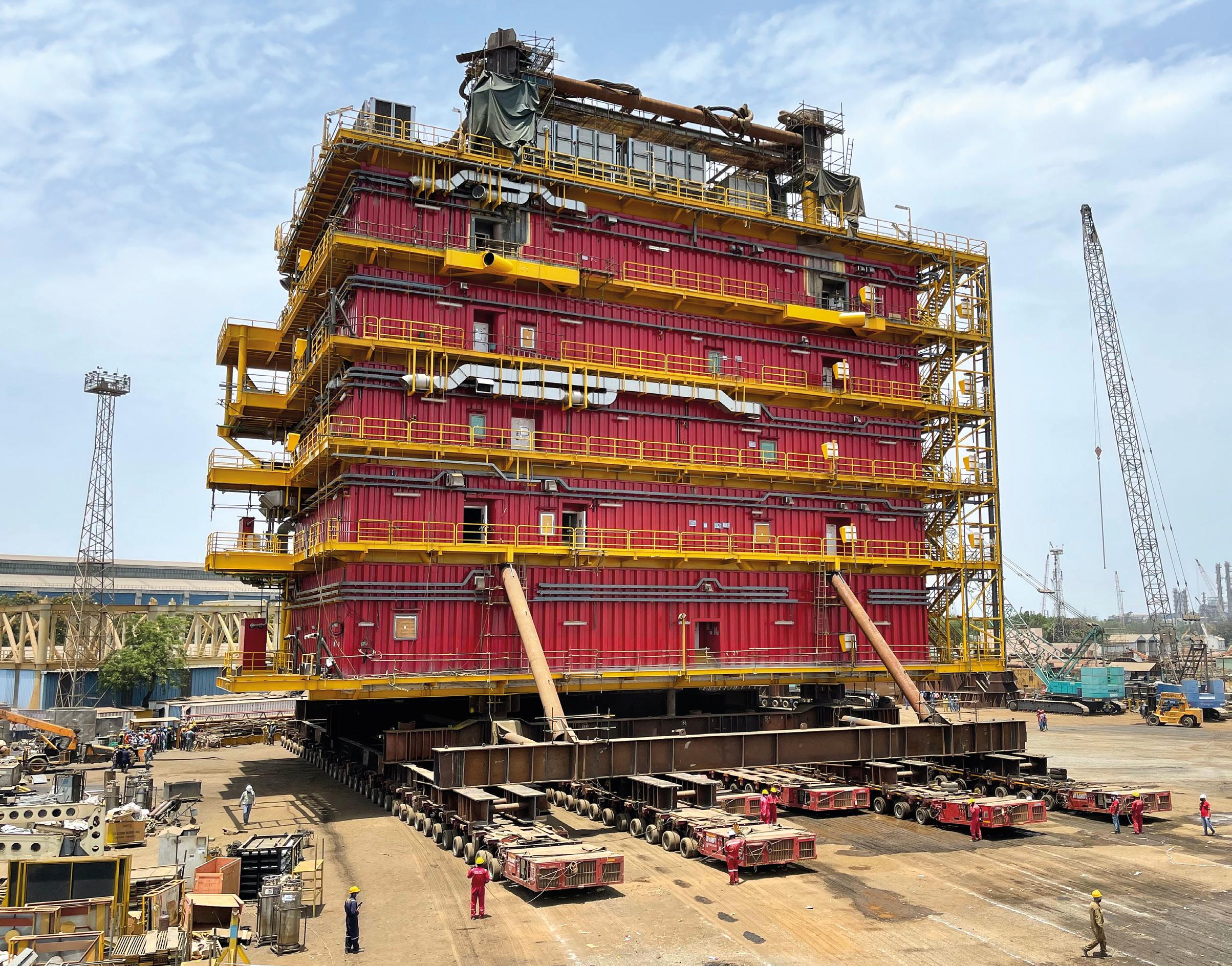
A Change of Direction
All good things must come to an end, as the proverb goes, and so it was for Lift & Shift. In March 2022, three of Mumbai’s biggest names in the industry announced they were coming together to form India’s largest heavylift and project logistics company in a deal worth a reported US$2 million.
JM Baxi, one of the country’s oldest shipping groups with a trading history of more than 100 years, acquired Lift & Shift from the Parikh family, along with the project cargo division of Allcargo Logistics, a major forwarder whose interest in projects had waxed and waned over the years.
The result was the formation of a new business, JM Baxi Heavy Private Limited. “There is an upsurge in capital expenditure [in India] and we
are just beginning to see the cycle turn,” said Dhruv Kotak, JM Baxi’s managing director, at the time of the deal. “The next decade will see momentum in demand, bolstered by the national infrastructure pipeline.”
The transaction was something of a marriage of convenience for all concerned. The owners of Lift & Shift were ready to exit the sector and focus on their other business interests, which include real estate, hospitality and education; Allcargo was keen to dispose of assets for a vertical it no longer wanted to service; and JM Baxi seized the opportunity to strengthen its presence in the project cargo field.
And Parikh? He was appointed president and chief business officer of JM Baxi Heavy and gets to continue doing what he likes best – albeit at
a (slightly) less intensive pace. “I used to arrive at the office at 0930 hrs and leave around 2000 hrs, and I was traveling more than 150 days a year,” he recalls. “Now I am traveling less, and I’ve started to work from home on a Saturday.”
Everything Is Possible
Parikh, a married father of two, was the only family member to transfer to the new heavy-lift business, along with many long-serving employees of Lift & Shift. “I’ve been passionately involved in this business since 1997, working from stage one. It gives satisfaction at the end of the day when you plan and execute something to the tee,” he says. As well as managing a team of 400 employees at JM Baxi Heavy, Parikh maintains contact with key customers
38 Breakbulk Magazine Issue 2 2024 breakbulk.com
Global
(“you have to make a point to meet clients regularly”) and, with all his hands-on industry experience, cuts the figure of a boss who is unlikely to entertain the words ‘Sorry sir, it can’t be done’. “That’s right – there’s nothing that’s impossible,” agrees Parikh. “It’s our job to find the way.”
The new entity has India’s largest fleet of special equipment for overdimensional and heavy-lift projects, including over 660 trailers, of which more than 200 are SPMTs, and marine assets such as barges.
“With the new entity we are able to deliver everything from the smallest pieces to the largest, we have the entire vision now,” Parikh says. “Quality is of course important, but to offer the best rates you need to have the in-house strength too. The amalgamation helped us to be in various locations, giving us greater strength and a bigger portfolio and allowing us to deliver where you would have otherwise had to combine with other service providers, or break up the job. Our strategy is to be the first name that comes to mind when a logistics project in India comes up.”
Notwithstanding the consolidation instigated by JM Baxi, there is no shortage of competition in the sector. “In the 1990s, we were seven or eight companies. Today, there are more than 60 companies with hydraulic axles, so the competition hasn’t shrunk – but the market has expanded left, right and center.”
Reach for Goals
Having talked shop for more than an hour, I want to know about Parikh’s personal interests. “I get up around 0630 hrs and go for a walk, often for 45 minutes or more, listening to spiritual discourses,” he says. “I have a religious upbringing and would like to pass on this knowledge and belief to the younger generation. Since the age of 10, I have been reading the Hindu scriptures, in particular the Bhagavad Gita – the teachings of Shri Krishna – and turn to them to navigate the challenges faced by mankind, like birth, death, pain, suffering, fear, love and hate.
“I believe the purpose of one’s journey is to improve yourself and reach your goals. Do your work
earnestly and you will get your results. It’s been a conscious effort to keep on performing, not just doing things for the sake of it.
“Outside work, reading is one of my hobbies and I hold the typical Indian love of cricket – both watching and playing. These days I follow soccer too, and I’m also interested in photography. We’ve enjoyed a lot of traveling over the years, and that’s where you get the family time.”
Asked what his future holds, it doesn’t take long for Parikh’s mind to revert to the business he’s devoted his life to. “Well, I’m still hoping to break that 10,000-tonne milestone and be among the few that have handled a project of that size,” he says. “It’s a target to achieve – for sure.”
Breakbulk readers can meet Sameer Parikh and the JM Baxi Heavy team at Breakbulk Europe, Hall 2 2K10.
Luke King is a freelance reporter and communications consultant who has been involved in the project cargo industry since 2007.
*Breakbulk Europe and Middle East Exhibitor Visit: www.europe.breakbulk.com/home www.middleeast.breakbulk.com/home

39 Breakbulk Magazine Issue 2 2024 breakbulk.com
Global
Lift & Shift conducted logistics for the Samsung Opal Project, which involved using barges and ships to transport 24 pieces of heavy and over-dimensional equipment, each weighing up to 1,350 tonnes, from Mumbai port to Dahej, Gujurat.
Credit: JM Baxi Heavy
By Carly Fields
ACCELERATING VEHICLE GROWTH DRIVES CAPACITY CONSTRAINTS
High and Heavy Volumes Strong Amid Geopolitical Risks
Global deep-sea car trade is set for a remarkable upswing, with an estimated 17 percent growth to 23.7 million cars in 2023, surpassing the pre-Covid record set in 2018. Clarksons’ David Whittaker attributes this surge to resurgent Chinese exports and increased production in key regions, marking a recovery from component shortages in the preceding years.
However, a looming challenge is the industry’s tight fleet, with a minimal 2 percent expansion since 2019, coupled with existing pure car and truck carriers, or PCTCs, being locked into long-term fixtures. As the sector
anticipates significant growth in the coming years, uncertainties persist, ranging from the impact of geopolitical issues in the Middle East to the evolving landscape of environmental regulations, setting the stage for a complex future for the PCTC industry.
Clarksons’ Shipping Research Manager Whittaker, writing in the broker’s Car Carrier Trade & Transport 2023 report, said surging China-Europe volumes mean that ‘car-mile’ trade is set to grow by 19 percent this year. Of note, “high and heavy” volumes were said to be strong, evidenced by the “growing share of trade accounted
Summary:
Demand for PCTCs through to 2025 is expected to remain strong driven by Chinese electric vehicle exports, while capacity is constrained with only gradual fleet growth of around 8 percent per year expected, leading to tight capacity and high rates. But there are myriad risks to the outlook: decreasing activity in the Suez Canal, environmental regulations, risks to vehicle demand, and risks from a growing orderbook with new mega-ships entering
market.
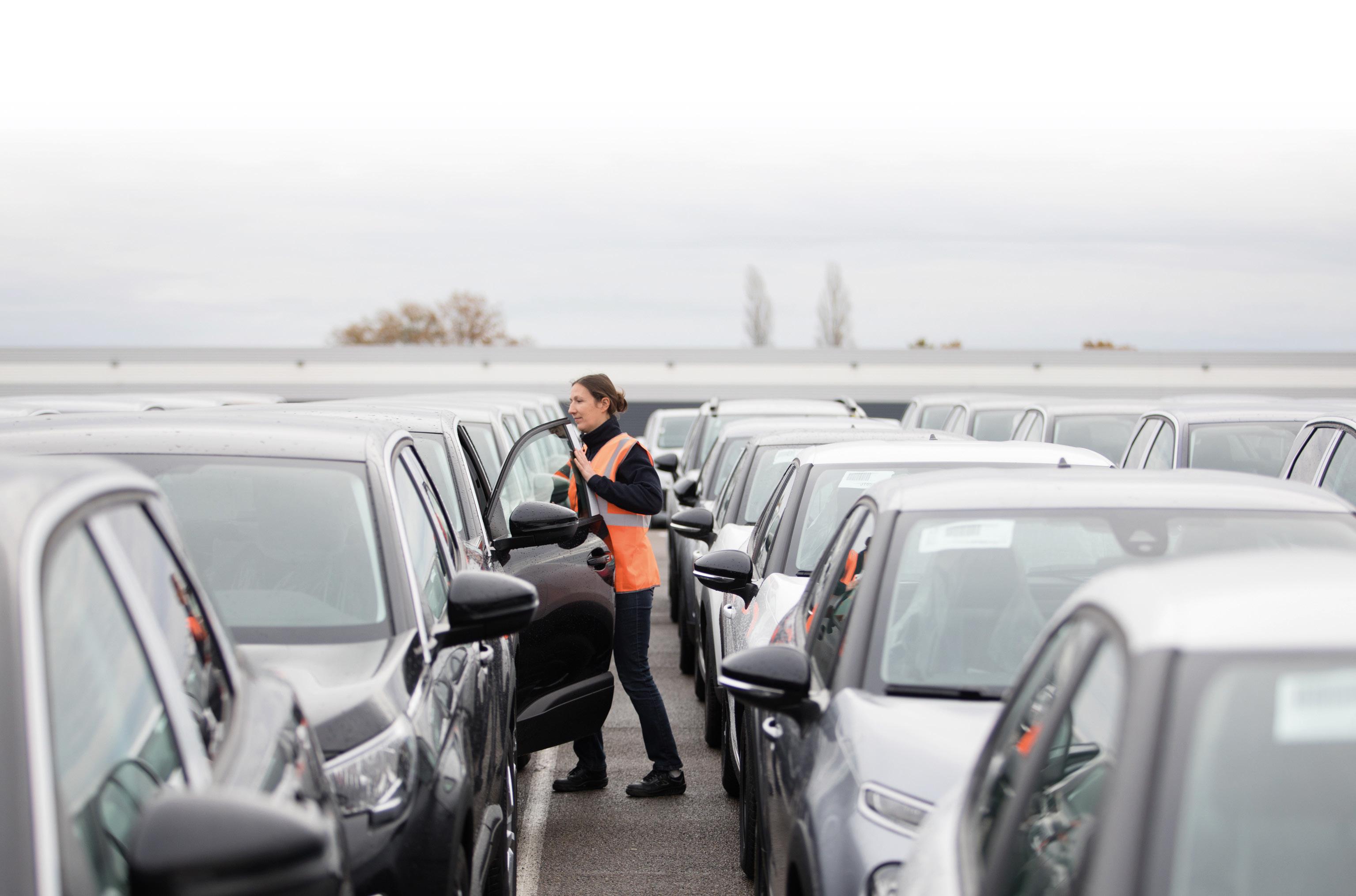
40 Breakbulk Magazine Issue 2 2024 breakbulk.com
Global
CEVA Logistics is ready to support a flat, but strong market in 2024. Credit: CEVA Logisics
the
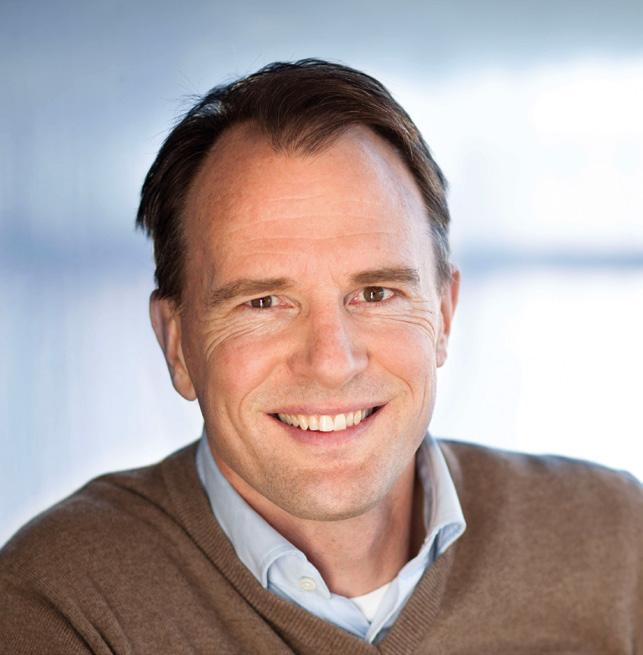
for by generally larger and heavier EVs and hybrids.” This was up 29 percent in 2023, up from 9 percent in 2019. This has further “turbocharged” vessel demand, Whittaker said.
But the extremely tight fleet is causing complications. Data published in December 2023 from Clarksons counted 80 vessels of 677,000 car equivalent units (ceu) ordered in 2023 - a new annual record. The orderbook at that point stood at circa 37 percent of fleet capacity.
But “further ahead … there is more uncertainty; fleet growth is projected to pick up to ~8 percent per annum in 2024-25, while it is unclear to what extent car trade growth might ‘cool off’ once pent-up demand is worked through, especially given consumer pressures and downside risks,” Whittaker said. Clarksons’ base case is for 5 percent growth in 2024 and 3 percent in 2025.
Hans Eivind Siewers, segment director passenger ships and ro-ro at DNV, said that even though the PCTC order peak has most probably passed, there are many signs that the market will continue to be strong in 2024/25. “We have a very high demand, in particular driven by the fast-growing Chinese EV industry, combined with a decade of low ordering,” he said to Breakbulk. This increased demand is countered by the current geopolitical issues in the Middle East, with many operators avoiding the Red Sea and taking the

longer route around Africa instead, which artificially reduces capacity.
‘Game Changer’
Speaking to Breakbulk, Dan Nash, head of container, ro-ro and ro-pax at maritime software specialist
Veson Nautical, said that net fleet growth of 6-7 percent is expected this year, followed by 11 percent supply growth in 2025 “which will be the real game changer, resulting in freight rates, charter rates, and asset values correcting to long term historical averages thereafter, assuming demand holds from China/Asia – the main source of export demand in this sector.”
He added that demand was comfortably outpacing supply by circa 10 percent before the disruption in the Red Sea, which has added 12 days of voyage time for most car carriers now diverting via Africa instead of transiting the Suez.
“The supply-demand imbalance is set to widen during the first half of this year if instability in the Red Sea continues into next quarter, from reduced ship call frequency lowering car inventories, leading to increased pent-up demand for ocean transportation, firming rates and values,” Nash said.
Sustainability data specialist
Esgian noted that the Suez Canal was empty of roll-on, roll-off ships on Jan. 23, something they described as “unique considering this strategically
important area in the East/West trading corridor.” In 2023, there were 900 Suez Canal voyages - 500 eastbound and 400 westbound – of ships moving cars and other rolling stock, according to Esgian’s data.
“We see that the ro-ro activity in the Suez Canal is down 70 percent so far in January vs. monthly average 2021-2023, whereas it’s getting crowded outside the Cape which is up 133 percent in the same period. Bad for global trade and bad for the environment, but how long will it last?” asked Esgian.
Back to the Future
Stian Omli, Esgian’s senior vice president shipping, said to Breakbulk that to gauge future impacts, one must start by looking back to the factors that have contributed to the current strong PCTC market. “It’s a complex affair,” he said. “One can argue it all started with Covid-19 and the effects of the pandemic. The automotive industry experienced significant supply chain disruptions as the shipping side had an issue with a lack of labor both on ship and on shore. This created somewhat of a vacuum in the early days of Covid.
“With interest rates plummeting and ‘most’ people still retaining their income, saving rates went significantly up as spending was restricted. As such, the demand for new cars increased a lot during the 2021-2022 period but supply was restricted.”
Omli said that the order backlog for cars peaked in the middle of 2022 in Europe but has fallen significantly since and is now back at pre-Covid levels, if not lower. “When you throw China’s EV exports into the mix (longer sailing distance), port congestion in several key areas (notably Australia and Mexico), and little new capacity coming into the market it has all pushed freight rates up.”
He sees the PCTC market heading for a soft landing, based on four assumptions: up to 40 new buildings will enter the market in 2024; the Red
41 Breakbulk Magazine Issue 2 2024 breakbulk.com
Global
Emmanuel Cheremetinski
Hans Eivind Siewers
Sea situation is resolved; Chinese EV exports do not continue to grow exponentially; and the container option continues to be a costeffective alternative to PCTCs.
Emmanuel Cheremetinski, global finished vehicle logistics leader at CEVA Logistics, added to the positive PCTC voices. “While the automotive manufacturing market
looks to remain flattish in 2024, it’s still a strong market, and car makers appear ready to continue producing and moving vehicles from global production sites to end markets for sale and for stocking,” he said to Breakbulk. While high inflation rates escalating raw material prices and the semiconductor shortage in 2022 and 2023 combined to weigh down and

of Transits
Number of Suez Canal Transits
Number of Cape of Good Hope Transits
Source: VesselsValue January 2024
delay the automotive sector’s recovery from the pandemic, manufacturers are now looking to take advantage of every opportunity in the current market conditions to transport finished vehicles to end markets, he said.
“As a result, we expect that the next two to three years will remain very challenging in the car carrier market, both in deep-sea and shortsea applications,” Cheremetinski said. “Capacity is constrained, and while there are new vessels coming online this year and next year, global demand remains strong, so capacity in the market will remain tight.”
In response to these market needs, CEVA is deploying four new 7,000-car, deep-sea vessels in 2024. “We expect to be able to transport approximately 140,000 vehicles per year thanks to the new vessels.”
Future Challenges
Esgian’s Omli counts the challenges on the horizon. Firstly, new players coming into the market, notably Chinese, will alter market dynamics. Second, containers will continue to be an alternative option for carriage. Third, customer demand may stagnate. And fourth, increasing environmental regulations will take their toll.
Omli is particularly concerned about the last point. Tightening emission regulations will have an effect, he said. “Take EU ETS for instance - it’s not only a cost (carbon credits), but since the supply of such credits will go down, shipping lines are forced to reduce their CO2 emissions as a ‘license to operate’.”
DNV’s Siewers agreed that environmental regulations will result in some capacity decrease due to speed reduction and possible early retirements. “As with the rest of the shipping industry, decarbonization is one of the main challenges,” he said. “And it is fascinating to observe that this is the first segment where almost all orders are with alternative fuels.” Most PCTC orders are for dual fuel
42 Breakbulk Magazine Issue 2 2024 breakbulk.com
Global 01/10/ 2023 15/10/ 2023 29/10/ 2023 12/11/ 2023 26/11/ 2023 10/12/ 2023 24/12/ 2023 07/01/ 2024
Number
Weekly Number of Ro-ros Travelling From Asia Through Suez vs Cape of Good Hope 0 1 2 3 4 5 6
Caption. Credit: Esgian

engines, harnessing LNG, but there are some orders for dual fuel with methanol, and ammonia-ready ships.
Siewers added another challenge to the outlook for PCTCs: re-occurring fires on ro-ro decks. “We have cases every year and even total losses. This is something that all operators have to have an extremely high focus on.”
DNV also sees an increased tendency towards larger capacity ships, capturing economies of scale. In December 2023, a series of PCTCs with a record capacity of 10,800 ceu capacity were ordered in China. “We think the drive for cost efficiency per transported unit and decarbonization drive will continue to push in this direction,” he said.
Also, energy efficiency will be an increasingly important part of the mix, due to the expected high price of low carbon fuels, Siewers said.
Electric Avenue
CEVA Logistics’ Cheremetinski sees the rapid growth of EVs as a trend to watch in finished vehicle logistics in the near term. “In general, these
vehicles are heavier, and their unique nature due to the lithium batteries requires unique handling all along their supply chain and transport.” Added to which, the size of vehicles continues to change. “This trend will likely continue, already leading many transporters, including CEVA, to move to a new pricing model that is based on cubic meters, and not a ‘per vehicle’ model.”
The changing global economic situation and related tariffs could also play a role in reshaping automotive manufacturing and the transport of finished vehicles, Cheremetinski continued. “For example, a decision is expected in 2024 related to the import of vehicles into Europe. An increase in any import taxes could create a nearshoring effect for the production of vehicles, with secondary effects on how those vehicles are then transported to end markets — more land-based than via ocean vessels.”
Protectionist threats will not be the only driving force for nearshoring. “As the transition towards EVs will be long, competition on market share and time to market will remain
fierce, while dragging on OEMs’ profitability. Nearshoring will be one answer to such a conundrum. Therefore, the PCTC market will need to adapt, all the more as smaller vessels tend to not be the most cost efficient,” Cheremetinski said.
Likewise, changes in global trade dynamics, such as shifts in manufacturing locations or trade policies, could have a significant impact on the car carrier vessel market. “Monitoring geopolitical developments and trade agreements can help identify potential trends and opportunities in this market,” Cheremetinski said.
Finally, environmental concerns and regulations are driving the adoption of greener shipping practices. This includes the use of cleaner fuels, such as liquefied natural gas or alternative fuels, in PCTC vessels. Therefore, keeping an eye on developments in sustainable shipping will be important for the industry.
Carly Fields has reported on the shipping industry for the past 24 years, covering bunkers and broking and much in between.
43 Breakbulk Magazine Issue 2 2024 breakbulk.com
Global
DNV sees an increased tendency towards larger capacity ships.
Europe exhibitor. Visit: www.europe.breakbulk.com/home
Credit: Esgian
*Breakbulk

ALLIANCES MAKE EVEN THE TRICKIEST PROJECTS RUN SMOOTHLY
Engagement Brings Construction, Engineering Teams Together
By Fayçal Boumerkhoufa
44 Breakbulk Magazine Issue 2 2024 breakbulk.com Throwback
Flight 1 of 68 ready to load the sludge catcher. Credit: Kansas International
Throwback
Moving critical parts for project work via air is not uncommon, and a fairly familiar option to project owners and their appointed contractors. It is a concept known for crisis situations.
In rare occasions it is used as the key transport conveyor of choice, especially for situations which combine both geographical, time critical and complex end destination and last mile scenarios.
When I worked for an airline, I was asked by a manufacturer if we could move two modular liquefied natural gas trains from the U.S. to the Majnoon Field in Iraq, preferably within a specific timeframe.
Going through the legal and commercial standard RFQ to become an approved direct vendor to the energy company operating the construction was standard work. However, the implementation and education required to make this a successful project was different. It required in-depth continuous coaching on both ends; for us internally and for the customer and the agent parties involved.
As a project director I took it upon myself to convince the construction manager to engage our teams in educational sessions and ensure all entities and divisions were truly familiar with the project requirements and understood the parameters of the manufacturer and energy companies, including protocols, legal content, change of standard terms, and acceptance of financial implications delivering cargo in Iraq.
Meeting with the construction team and then linking them with the airlines’ engineering division resulted in the airlines engineering team becoming an extended arm of the construction team. The effort paid off: each flight was loaded the way the trucks would take the modules onto the construction site in the Majnoon area.
One problem identified up front was the rigidness of companies to
stick to their guns, more so on the terms and conditions aspect. The construction manager and I formed an alliance, and we travelled to meet with the teams and ensured all was understood, especially the objective.
This approach ensured the customer delivered to their client, the Iraqi Ministry of Energy, within the time frame, and without any hold up. A total of 68 AN124 flights were executed. The main lanes were primarily out of Houston, Texas and East Midlands, UK.
The customer was asked by other energy companies in the area how they pulled it off, which was testimony to the concept and work performed.
Today, I still enjoy a pleasant relationship with the construction manager and have executed other ad hoc emergency services in the same realm, applying the same principle.
Fayçal Boumerkhoufa is vice president of sales, project cargo, at Ascent Global Logistics. He has worked for Panalpina in Belgium, building up a 14-year experience and expertise in the air charter and project realm, and with the Volga-Dnepr Group.


45 Breakbulk Magazine Issue 2 2024 breakbulk.com
A second flight ready for loading. Credit: Kansas International
Fayçal Boumerkhoufa
TOO MANY TURBINES, TOO
Could Lack of Heavy-lift Vessels Slow Europe’s Offshore Wind Ambitions?
By Jeremy Bowden
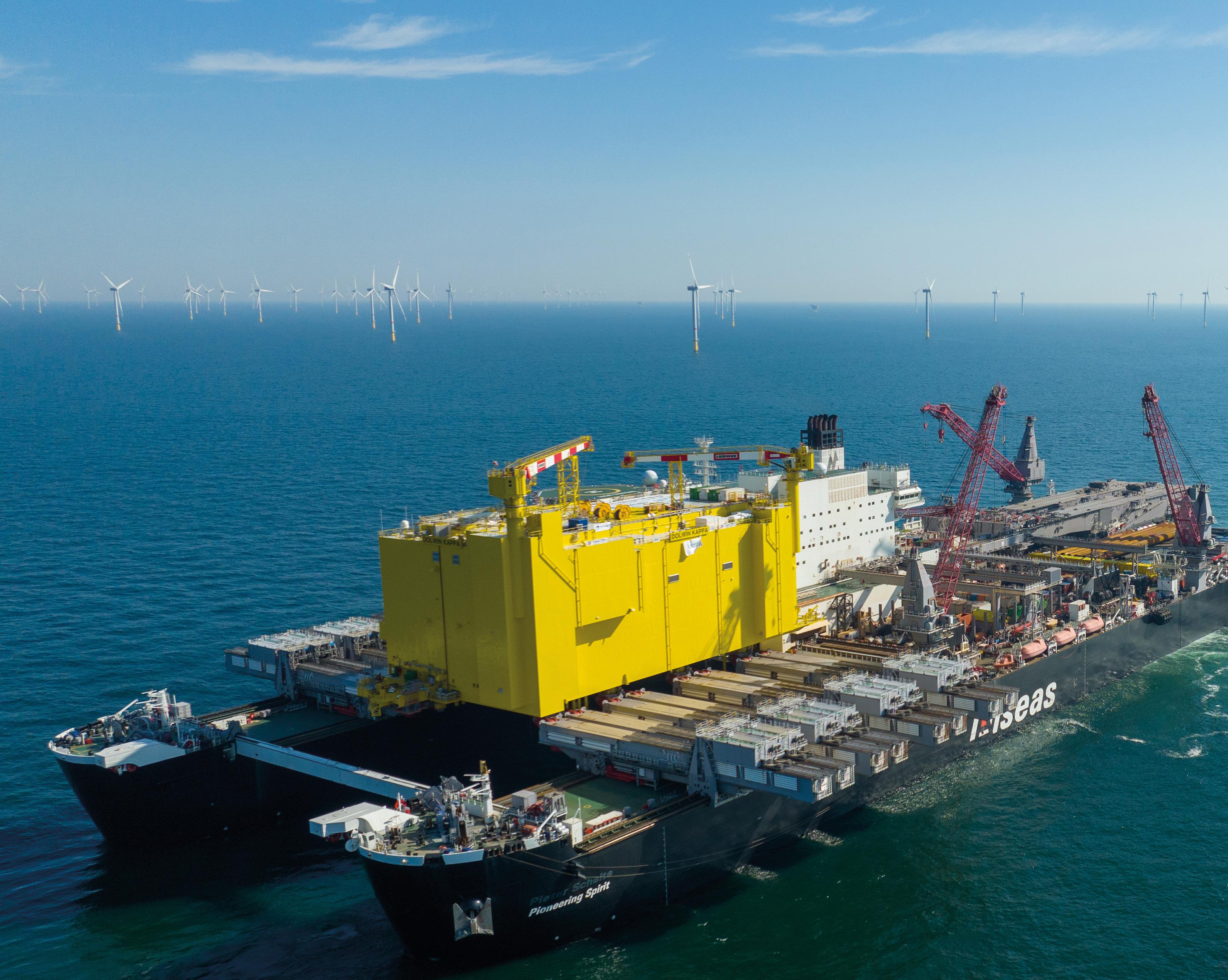
Over the next 10 to 15 years a massive roll out of offshore wind farms is planned. In Europe alone, the UK, Germany, France, Poland, Holland and Belgium have a combined offshore wind generation target of 140 gigawatts (GW) by 2030, with the UK the largest constituent at 50GW. The size of turbine is increasing as is the average depth, while some next-generation offshore
Summary:
Challenges circle the offshore wind industry due to insufficient installation vessels for wind turbines and foundations. While demand for heavy-lift vessels is surging due to the increasing size of turbines and wind farms, the supply chain has not kept up.
grid systems require 2GW converter stations, all of which need to be put in place.
While attention so far has mostly been on rising costs and bottlenecks in turbine manufacture and supply, the focus is increasingly switching to installation constraints, especially in the field of heavy-lift vessels, or HLVs.
Last August, Ørsted cancelled the
While some new vessels are on order, significant shortages are expected over the next decade as wind targets ramp up quickly. Cooperation across industries will be needed to ensure sufficient infrastructure.
major Ocean Wind 1&2 projects off the coast of New York, which, while officially blamed on “supplier delays”, was put down specifically to the inability of the operator to secure an appropriate HLV vessel within the allotted time frame, according to David Carr, joint CEO at Zero-C. The Norfolk Boreas project off the coast of East Anglia was also cancelled in 2023, due to rising costs, and the two cancellations have eased the vessel shortage situation, at least temporarily. More leeway could be gained from further delays to wind farms from contract renegotiation or rising costs elsewhere. Nevertheless, the situation does look tight. The global fleet of installation vessels was originally a blend of heavylift ships and small general-purpose jack-up rigs able to manage smaller
46 Breakbulk Magazine Issue 2 2024 breakbulk.com
Europe
In September 2022, Allseas installed the 900MW DolWin kappa converter station for TenneT’s DolWin6 offshore grid connection system. Credit: Allseas
TOO FEW VESSELS

installations, but turbines are getting bigger requiring larger foundations and installation vessels, while farm size is also growing, resulting in larger loads that require bigger vessels, as well as more cable and other work.
Analysts predict that over 100 new offshore wind turbine and foundation installation and maintenance vessels will be required for offshore projects planned over the next decade.
Complexity Dictates Vessel Demand
The complexity of installation varies by country depending on geology, water depth and weather conditions – which determine the type of vessels required. A lot of wind means more waves and a more complicated environment, according to Carr, while water depths of over 100 meters in the ScotWind areas are a significant factor. “Whereas in the Baltic it’s only 30 to 40 meters of water so there are a great many more vessels that can do that work.”
Carr said the largest 20 megawatt (MW) turbine deeper water windfarms require pyramid structure jackets rather than monopiles, 110 meters in height, weighing 3,000-4,000 tons. “Four vessels in the world can do these project foundations – Heerema Marine
Contractors Sleipnir and Thialf crane vessels, the Saipem 7000 and Les Alizés – which are all contracted to the end of the decade in North America. Les Alizés is contracted out to RWE until 2029 at US$225,000 per day, and Saipem 7000 is on a US$450,000 day-rate in oil and gas – rates much higher than for wind projects,” leaving no suitable vessels available.
Brian Boutkan, manager commerce offshore at Jumbo Offshore, agreed there was a “positive market outlook” for HLV transport, and he acknowledged that European fabrication yards may not have the capacity to keep up with the required pace of development of new vessels for offshore wind in Europe. But he suggested that the additional vessels required could come from China, South Korea and elsewhere in East Asia.
New Vessels in the Pipeline
Many new vessels are being commissioned by European companies. Ulstein has developed a new class of turbine installation vessel able to lift 8,000-tonne foundations, while offshore services company Van Oord has ordered a new offshore wind turbine installation vessel that will be able to install nextgeneration wind turbines of up to 20MW with a low carbon footprint. The vessel will be built by Yantai CIMC Raffles Shipyard in China and delivered in 2024.
Once the foundations are in place, a wind turbine installation vessel, or WTIV, puts on the turbine. Some vessels can do both. Havfram Wind ordered a second NG20000X Jack-Up vessel in late 2023, capable of installing offshore wind turbines with a rotor diameter of over 300 meters, as well as
monopiles of up to 3,000 tons in water depths of 70 meters. According to the CEO, the vessel has several wind farm commitments, including with Ørsted to install wind turbines at their Hornsea 3 project, starting in autumn of 2026. Vattenfall has appointed Havfram as preferred supplier for the Norfolk Projects, starting in the spring of 2027.
Other newbuild WTIV orders have recently been announced by several companies including Cadeler, OHT and Eneti. And in December, IWS of Norway took delivery of its second (of six) CSOV (wind farm mothership) for North Sea service from China. The vessel will start work on the Dogger Bank wind farm early this year.
Still Not Enough?
Carr said that in the past decade, a number of next-generation WTIVs had been built, “but not enough for the 2025 demand increase, and it’s a similar story for FIVs [floating installation vessels, aka HLVs], which take three years to build.” An additional challenge comes from training crews from scratch.
Carr said: “The supply chain hasn’t matched developers in the rush for wind power... Most investment is currently going to oil and gas installation vessels because returns are much higher.” He added that suggestions that Transocean might convert existing older rigs or rigs that were not completed due to the Covid slump to wind installers were unlikely to come to fruition because of those higher returns in oil and gas. “Wind rates have risen but need to rise further,” he added.
However, major marine services provider, Allseas, told Breakbulk that it had vessels available for the development of offshore wind, with its latest HLV, Pioneering Spirit, “a gamechanger.” The newly built vessel can transport and install entire platform topsides up to a weight of 48,000 tons, prefabricated and tested onshore, with plans to increase this to 60,000 tons. So far it has installed jackets and converter stations, but not turbines.
47 Breakbulk Magazine Issue 2 2024 breakbulk.com
Europe


“Our capacity for installation (and removal) of such large topsides is extremely high due to the fast and robust heave-compensated lift equipment that provides good workability for single-lift installation in North Sea conditions, even in wintertime. Pioneering Spirit can also install jackets weighing up to 20,000 tonnes in a single lift, thereby limiting subsea work and associated risks,” Allseas said.
The Swiss-based company said its main wind challenges are schedule
and logistics. “Installations will need to be staggered and planned in such a way that Allseas can continue to serve other clients outside the wind industry.” It added that the transport market was under pressure due to fast-growing demand and the growing size of the platform components.
In September 2022, Allseas installed the 900MW DolWin kappa converter station for TenneT’s DolWin6 offshore grid connection system. Comprising a 5,000-ton jacket and a 11,000-ton converter station, it was Pioneering
Spirit’s first complete platform installation for the wind industry and took only 12 days to complete in the German North Sea. Since then, Allseas has secured a number of wind installation deals. “Southern Europe, Australia, Asia and China are also potential future markets for Allseas. In the short term, however, the focus will be serving operators expanding developments in the North Sea.”
Tight UK Market
Offshore wind projects are also stimulating the commissioning of new cable-laying vessels, with vast amounts of work associated with wind farms, while the limited number of existing vessels are mostly dedicated to international subsea communications networks and oil and gas. New orders include two newbuilds from Megamas in November, with the first to be ready in 2026.
The situation is particularly tight in the UK, where plans for offshore wind are deepest and the most ambitious. Offshore Energies UK forecasts the number of turbines requiring installation will increase from over 200 in 2026 to almost 400 in 2031, provided the UK remains on course for its 50GW wind capacity target by 2030. In addition, about GBP£3 billion will go to heavy-lift/topside removal of old
48 Breakbulk Magazine Issue 2 2024 breakbulk.com
Europe
Ulstein has developed an 8,000t foundation installation vessel. Credit: Ulstein
Heerema’s Sleipner vessel is one of four currently capable of installing pyramid structure jackets for structures up to 20,000 metric tons.
Credit: Heerema Marine Contractors

oil and gas rigs over the next decade, with a series of huge platforms to be removed from 2027 onwards.
OEUK Decommissioning Manager Ricky Thompson told Breakbulk that, in terms of heavy lifting, the larger and deeper water oil and gas structures will come away from 2027 onward, while most of the decommissioning of the smaller topsides will take place over the next few years in the southern North Sea and Irish seas. Thompson said this alone was “going to need a colossal push from the heavy-lift market.”
“We’re also expecting a surge in the demand for these vessels as offshore wind scales up in deeper waters – requiring more help from the decommissioning supply chain.” Issues remain in terms of shared skills and assets for offshore wind installation and oil and gas removal works, but he said the cost of removing topsides had fallen and this was expected to continue.
Working Together in Offshore
Thompson said the system may be able to cope: “Clever scheduling and fresh contracting models may be the answer to delivering such an abundance of work. An integrated offshore sector working together is needed to ensure collaboration, innovation and potentially infrastructure investment to enable this. Activities across these industries will be sharing the heavy-lift space for the next decade, so cooperation and some new assets will be important.”
There are also moves to create a local UK provider, headed up by Carr and his colleagues. Formed last year, start-
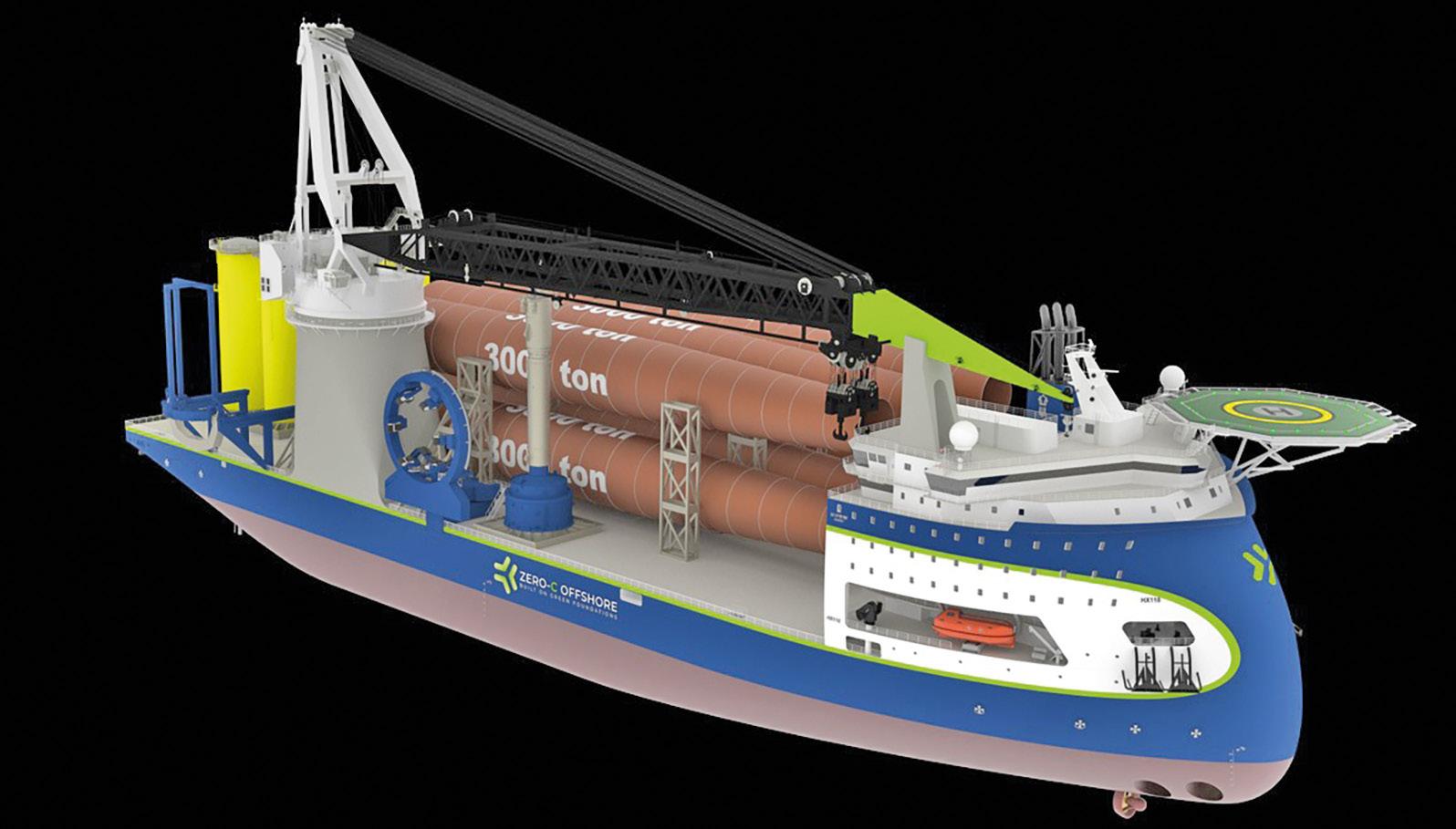
up Zero-C Offshore Construction plans to become a UK “Tier 1” for HLVs through development of a fleet (probably two) of ultra-low emissions Installer Max foundation installation vessels working from UK ports. The firm is hoping to secure a multi-year charter, against which it can finalize investment.
Carr said the UK has the highest aspirations for offshore wind, and yet there are no Tier 1 contractors in the UK to install, let alone to build these wind farms. “Scottish & Southern Electricity is bidding for a CFD for Berwick Bank [proposed wind farm] in the next few months – if they get it, they need to make progress quickly but do not have an HLV for installation of foundations yet, with start date planned for 2027. This means Berwick Bank may be delayed or sold.”
Current vessels can only install one to two of the largest type of foundations at a time, but Zero-C plans vessels that can manage three to four, improving efficiency, according to Carr. “Our new design would expand the working season and may be able to install the turbines too – which has not been done with floating vessels yet, but in calm weather we think it can be done.”
Carr said they needed stable longterm government policy to enable big companies to commit; wind support vessel orders reportedly fell sharply in 2023 when government policy appeared to waver.
He added that operators are also concerned about write-offs associated with work in the wind sector, especially when there are lucrative alternatives in oil and gas. “There’ve been hundreds
of millions of dollars of write-offs –legacy construction terms applied to wind orders, larger contractors took all the risk and things went wrong; late delivery, etc.,” Carr said.
Next Generation Installation
Allseas said it was also developing new concepts for the installation of next-generation turbines and foundations in the UK and elsewhere. The Swiss-Dutch company said it had various contracts for the installation of both gravity-based and jacket turbine foundations, which were “within the capacity of existing lift systems, and we still have installation capacity for the coming years.” It added that availability would largely depend on how successful Allseas is in securing future work for the installation of heavy pipelines and/or heavy-lift operations at remote locations.
More overseas capital is also flowing into the UK sector, which many see as at the forefront of global offshore wind. Recent deals include Singapore’s Cyan Renewables buying up Aberdeenbased Sentinal Marine, which it plans to use “to pivot and capture a slice of the fast-growing offshore wind market in the UK,” according to the CEO. Further deals and investment are expected,” Carr said, “despite a deteriorating investment climate linked to unsupportive government policy.
49 Breakbulk Magazine Issue 2 2024 breakbulk.com
Jeremy Bowden is a freelance journalist, researcher and analyst, specializing in energy matters with a focus on the energy transition.
Europe
Ricky Thompson
Start-up Zero-C Offshore plans to develop a fleet of ultra-low emissions foundation installation vessels.
Europe
www.europe.breakbulk.com/home BGSN member
Credit: Zero-C Offshore
*Breakbulk
exhibitor. Visit:

LESSONS LEARNED FROM CCS PROJECT
Heidelberg Materials’ Facility Overcomes Challenges
Towards the end of last year, the European Union agreed “unprecedented” funding for eight cross-border energy infrastructure projects, with five out of the eight being CO2 transport and storage initiatives expected to be completed by 2030. Each of the projects is at a different stage of planning, consultation or reality but what’s clear is that carbon capture, usage and
storage, or CCUS, projects are coming fast. That equates to the construction of vast developments with complex heavy-lift and project cargo transport requirements.
Leading the way is the Heidelberg Materials’ facility for capture, storage and offloading of CO2. It is part of the Norwegian government’s Longship project, along with Northern Lights –the storage part, in which partners are
By Felicity Landon
building an open access CO2 transport and storage infrastructure network for the transport of CO2 by tanker to a purpose-built receiving terminal. The Brevik facility, the first industrial-scale CCS project at a cement production plant in the world, has a target to capture 400,000 tonnes of CO2 a year. After three years of intensive construction work, the facility is due to be mechanically
50 Breakbulk Magazine Issue 2 2024 breakbulk.com
Europe
TOP: CO2 tanks in storage at the cement plant’s coal storage area. Foundations for the tanks are in the foreground. Credit: Heidelberg Materials.
Summary:
Construction of the first industrial-scale carbon capture and storage (CCS) project at a cement production plant in Brevik, Norway, faced significant challenges, including weak soil requiring extensive piling, limited space for equipment and materials, and complex coordination between many stakeholders. Creative solutions like using an underground mine and rented barge for storage, constructing a dedicated jetty, and transporting large equipment via ship were needed to overcome the constraints.
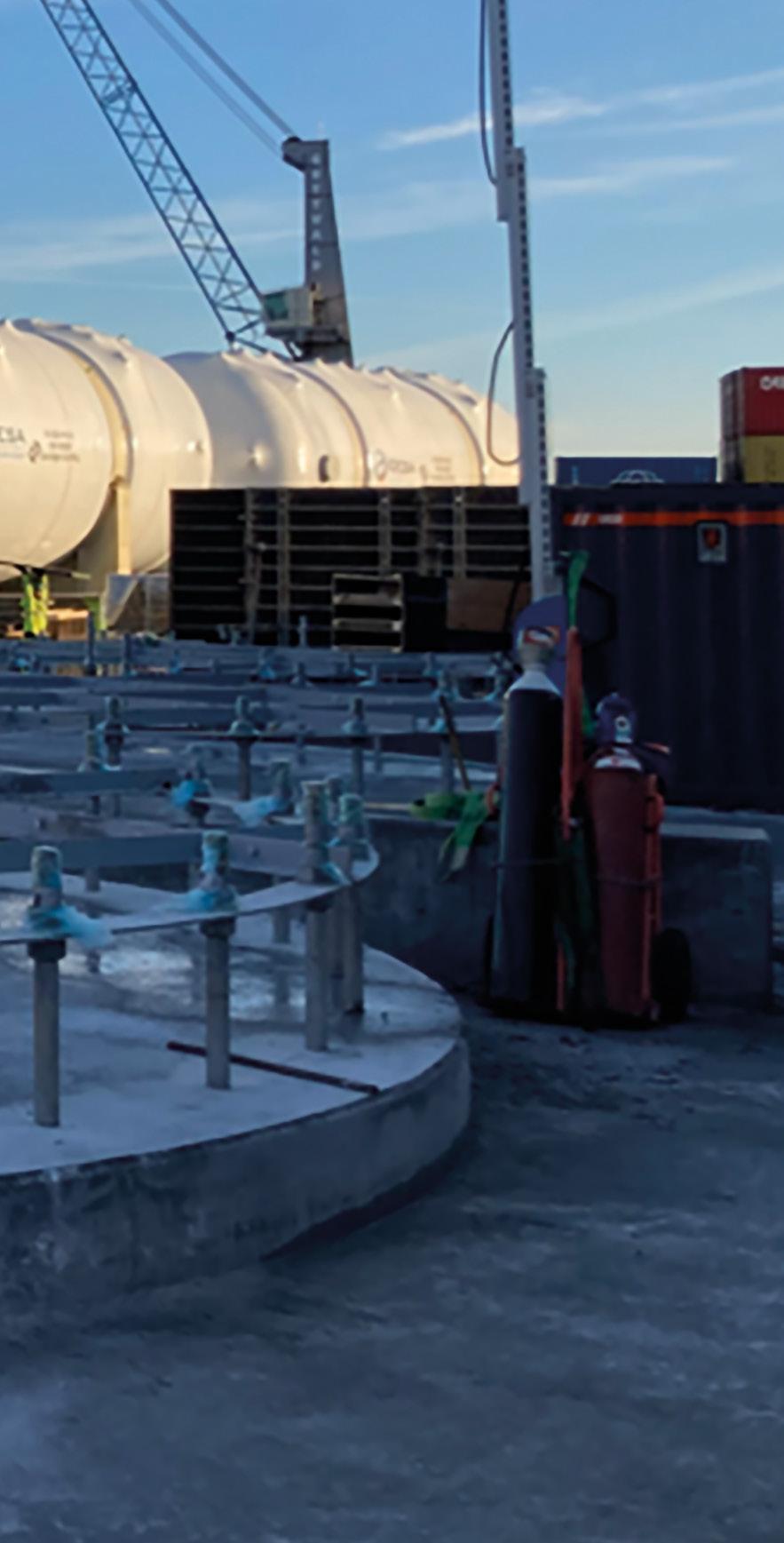
complete this year and go into operation in 2025. As about 80 percent of the funding has come from the Norwegian state, there is not only intense scrutiny plus additional reporting requirements, but also an obligation to share lessons learned, said Anders Skaerlund Petersen, project manager for decarbonization and process innovation at Heidelberg Materials. “We are open to giving advice – we are required to do so by the Norwegian state,” he said. “A lot of the focus is learning and acting on the lessons learned.”
Overcoming Space Constraints
Construction of the carbon capture plant has been particularly challenging due to space constraints and the fact that it is going ahead alongside a huge cement plant which has continued in operation throughout. “Often there
will not be enough space onsite for such installations because they will be built next to an existing plant, not on a greenfield site,” Petersen said. “Perhaps in future, there will be the construction of a cement plant and carbon capture all at once – but that’s something for the future.”
There have been a lot of challenges – “absolutely no question about it,” he said. “We are doing things that have never been done before. In one way, the construction has been pretty traditional for us but what differentiates this from a normal cement plant construction is the huge amount of piping and moving from ordinary steel to all sorts of stainless steel materials, which is new for us.”
Petersen is working with three subproject managers – one focused on civil works, one on the CO2 plant and one on the electrical areas and plant integration (with the cement plant). Aker Carbon Capture is the main contractor for engineering, procurement and construction, and Heidelberg is also supported by other expert consultants. Aker Solutions is
providing engineering, procurement and management assistance.
Components to be shipped in and installed have included the 50-meterhigh, 7 meters diameter absorber, which weighs in at 200 tonnes, and a 50-meter-high stack which sits on top of the absorber, six storage tanks weighing 250 tonnes each and measuring 24 meters high, the 200-tonne liquefaction module, and two giant bridges complete with pipework – to name but a few.
The Brevik site is in a narrow bay with little room for maneuver. “We knew from the start that space was going to be the big issue. Laydown areas have definitely been a huge challenge, perhaps one that was underestimated at the beginning of the project,” Petersen said.
Thinking Outside the Box
There have been some notably creative solutions. The cement plant’s underground mine has been used for back-up laydown space; a barge was rented to provide about 1,900 square meters of additional laydown area;
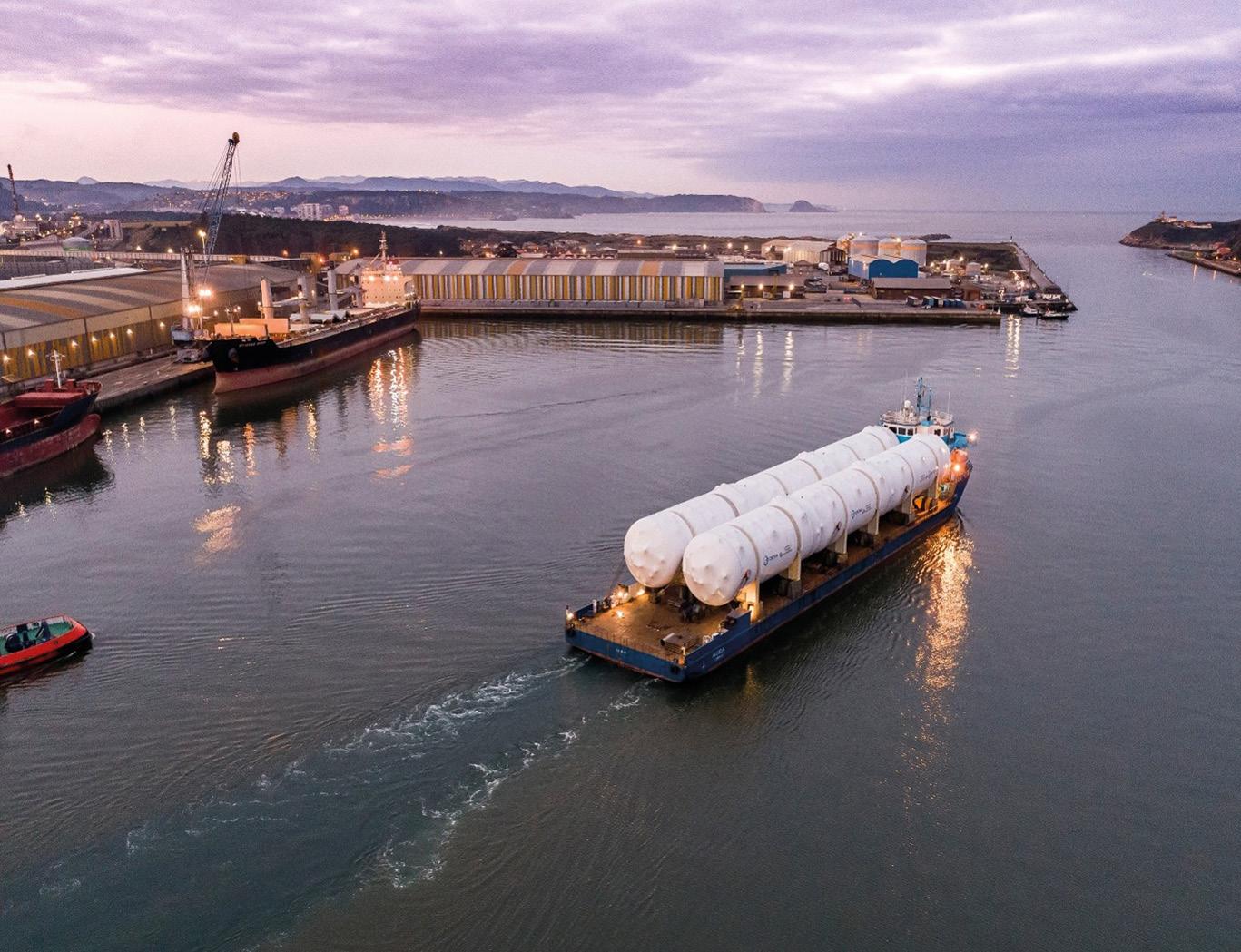
51 Breakbulk Magazine Issue 2 2024 breakbulk.com
Europe
Transportation of two CO2 tankers by barge from Spain. Credit: Heidelberg Materials.
“BIG EQUIPMENT SHOULD BE INSTALLED JUST-IN-TIME, IF POSSIBLE, WHEN YOU HAVE A VERY CONGESTED SITE.
HOWEVER, THAT IS NOT EASY BECAUSE SPECIALIST SHIPS ARE BOOKED MANY
MONTHS IN ADVANCE.”
MIHHAIL APRELSKI
a jetty was purpose-built; and the nearby Trosvik shipyard has played a key role, as has the port next door.
The Port of Grenland has facilities for lift-on, lift-off and roll-on, rolloff, and has been vital in providing port facilities, cranes and loading services. Heidelberg also constructed a 60x10 meters jetty on its own site, purely to serve the project. “Without
this jetty, I don’t know how we would have moved in the equipment,” Petersen said. The jetty has been used for landing heavy equipment on self-propelled modular transporters.
The barge was leased from Brevik Shipping – originally it was intended as portable storage for small pieces, but it ended up being pressed into service for much more.
“We had to temporarily store equipment on the barge but there were no facilities to load from ship to barge at our site,” Petersen said. “This was done in the public harbor, which has space for two ships to be docked at the same time.”
The absorber, stack and desorber all arrived for unloading at the port, where they were rolled across a loading platform from ship to barge; the barge was then moved to sit alongside the jetty at the CCS site, with the components offloaded as required. More recently, the barge has been at the shipyard 1 kilometer away, to support the fitting out of two bridge sections with a combined length of around 100 meters, including installation of pipework, in advance of installation onsite.
In March 2024, the liquefaction module, the desorber (a single piece of process machinery), the reboiler and condensate modules were due to be lifted into place.
Six 1,000 cubic meter liquefied
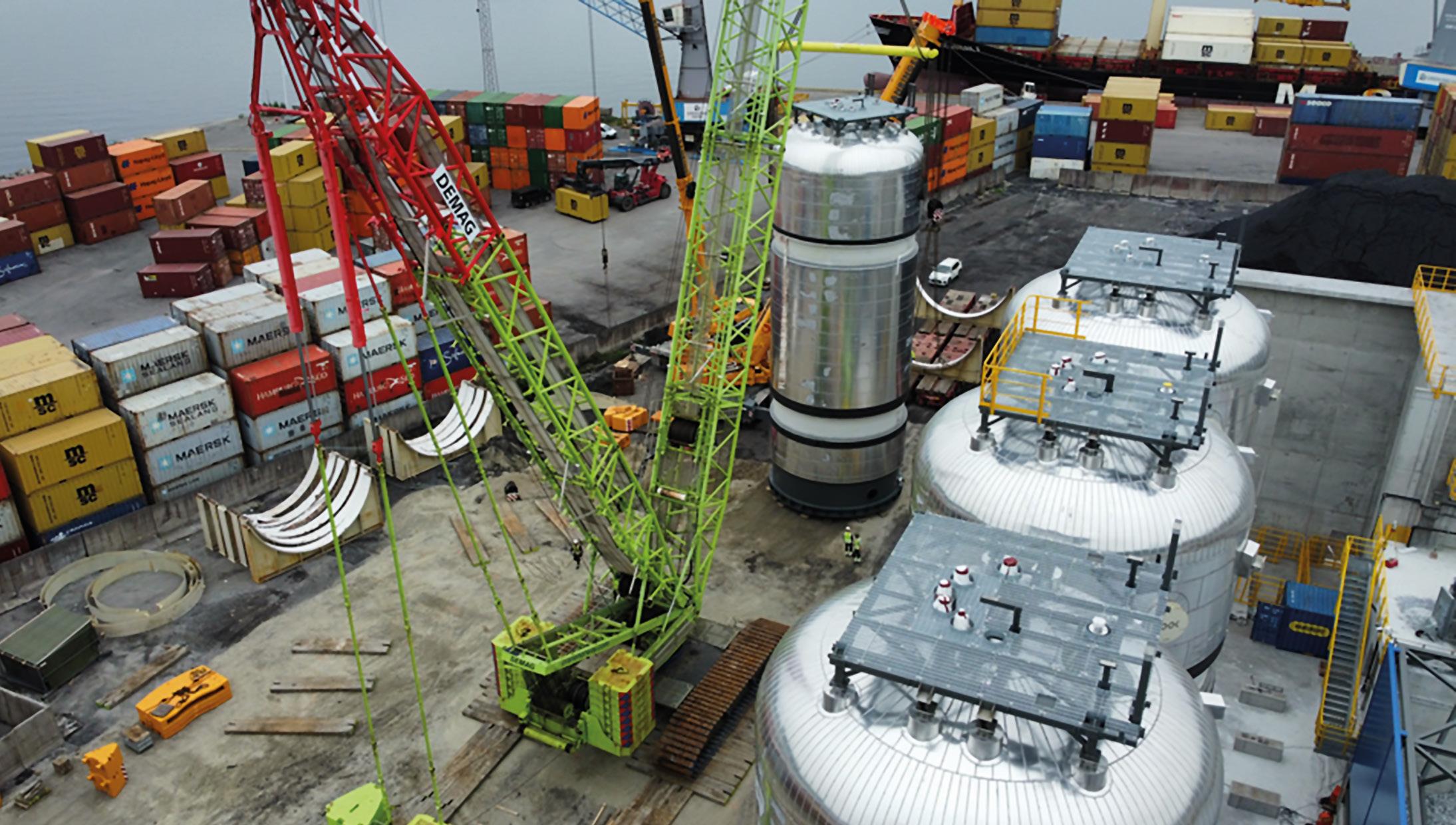
52 Breakbulk Magazine Issue 2 2024 breakbulk.com
Europe
Last CO2 tank being lifted in place by 650-tonne capacity crawler crane. Credit: Heidelberg Materials.
CO2 storage tanks, weighing 250 tonnes each and measuring 24 meters high, are already installed. When they arrived by ship from Aviles, Spain, space had to be found for them until the foundations were complete. Part of the cement plant’s coal storage area was taken over.
Supporting Infrastructure Challenges
K2 Project Forwarding delivered the six CO2 storage tanks from Aviles to Brevik, working with Finnish shipping company Meriaura. Quickport Logistics handled shipments of the absorber, desorber and cooling unit; all of these were loaded at Paldiski North Port in Estonia, and shipped via Port of Antwerp. “The largest unit was 43.7 x 4.6 x 6.65 meters, weighing 70 tonnes,” said Mihhail Aprelski, head of logistics at Quickport. “The cargo was produced in Estonia by Estanc. We tried to minimize the footprint as much as possible during transport and made the decision to use the ferry connection between Paldiski and Antwerp. It was a big challenge to make this work, with a height limitation of 7.2 meters on the ferry.”
Piling has added to the challenges. “The cement plant is basically built on sediment, so the site is not very strong. Every time we build something, we first have to do piling into the bedrock.”
Communication has been another focus area. “I speak a lot with my subproject managers. From the communication perspective, with so many stakeholders, this has been a very challenging project,” Petersen said. “It is not as if the organization has done this ten times before. A lot of the people involved had never met each other before and have been working together for the first time.”
Lessons learned
“We had the desorber taking up space on the jetty for quite some time and it would have been a benefit if we had this space available for other things than a big chunk of equipment. Quite

often, suppliers constructing this equipment would likely have big yards or industrial facilities and probably have space for this equipment – it would have been helpful to leave the equipment with the supplier for a longer time instead of transporting it as early as possible. That’s something to be taken into consideration. Big equipment should be installed justin-time, if possible, when you have a very congested site. However, that is not easy because specialist ships are booked many months in advance.”
Additionally, the low loading bearing capacity of the soil around the plant has meant that every time a heavy-lift or SPMT move has taken place, the working areas have had to be strengthened with wooden beams or even concrete foundations, which are expensive to rent/construct and take up space themselves. “We have had to do foundation strengthening using concrete. Perhaps it would have been a cheaper long-term solution to strengthen parts of the area with concrete from the start.”
The barge was “a very good idea, not cheap” and the jetty was vital in providing flexibility
to dock barges and ships and handle all kinds of equipment.
A 650-tonne crawler crane was hired in to lift the absorber – as pointed out by Petersen, this involved crane parts arriving in multi-truck loads for assembly onsite. “If it is possible to use a mobile crane instead of mobilizing a crawler crane, a lot of time and cost could be saved.”
Other projects to secure some of the EU’s €594m total Connecting Europe Facility for Energy (CEF-E) funding include the Dartagnan CO2 export hub at the Port of Dunkirk, France; two carbon capture projects in the Port of Rotterdam, Netherlands – the CO2NEXT import terminal and the ARAMIS undersea trunkline connection; the EU Carbon Capture & Storage (CCS) Interconnector at Gdansk, Poland; and the Northern Lights project, to support expansion of the CO2 import terminal at Øygarden, Norway, and the construction of a 100-kilometer offshore pipeline to the storage site.
Felicity Landon is an award-winning freelance journalist specializing in the ports, shipping, transport and logistics sectors.
53 Breakbulk Magazine Issue 2 2024 breakbulk.com
Europe
Europe exhibitor. Visit: www.europe.breakbulk.com/home
Barge loaded with an absorber (grey unit), absorber stack and desorber. Credit: Heidelberg Materials.
*Breakbulk
By Simon West
SASA’S ÇELIKOĞLU RISES TO QUAKE CHALLENGE
Uğur Çelikoğlu is a man used to working under pressure.
As new investments logistics lead for Türkiye-based SASA, one of Europe’s largest petrochemical producers, Çelikoğlu played a vital role in ensuring the trouble-free delivery of dozens of oversized components –including some of the heaviest project cargo ever carried on Türkiye’s public roads – for a new 1.5 million ton-per-year purified terephthalic acid, or PTA, plant built in the southern city of Adana.
The US$1.3 billion project, expected to start up later this year once final installation and welding work is complete, is part of an ambitious investment drive that SASA has embarked on to boost petrochemical production capacity and local logistics infrastructure.
Turkish heavy-lift specialist Caba Misnak, a division of CJ-ICM Logistics, was brought onboard to transport about 200 out-of-gauge components for the plant, a series of moves that won it an Excellence in Engineering prize at last year’s Heavy Lift Awards.
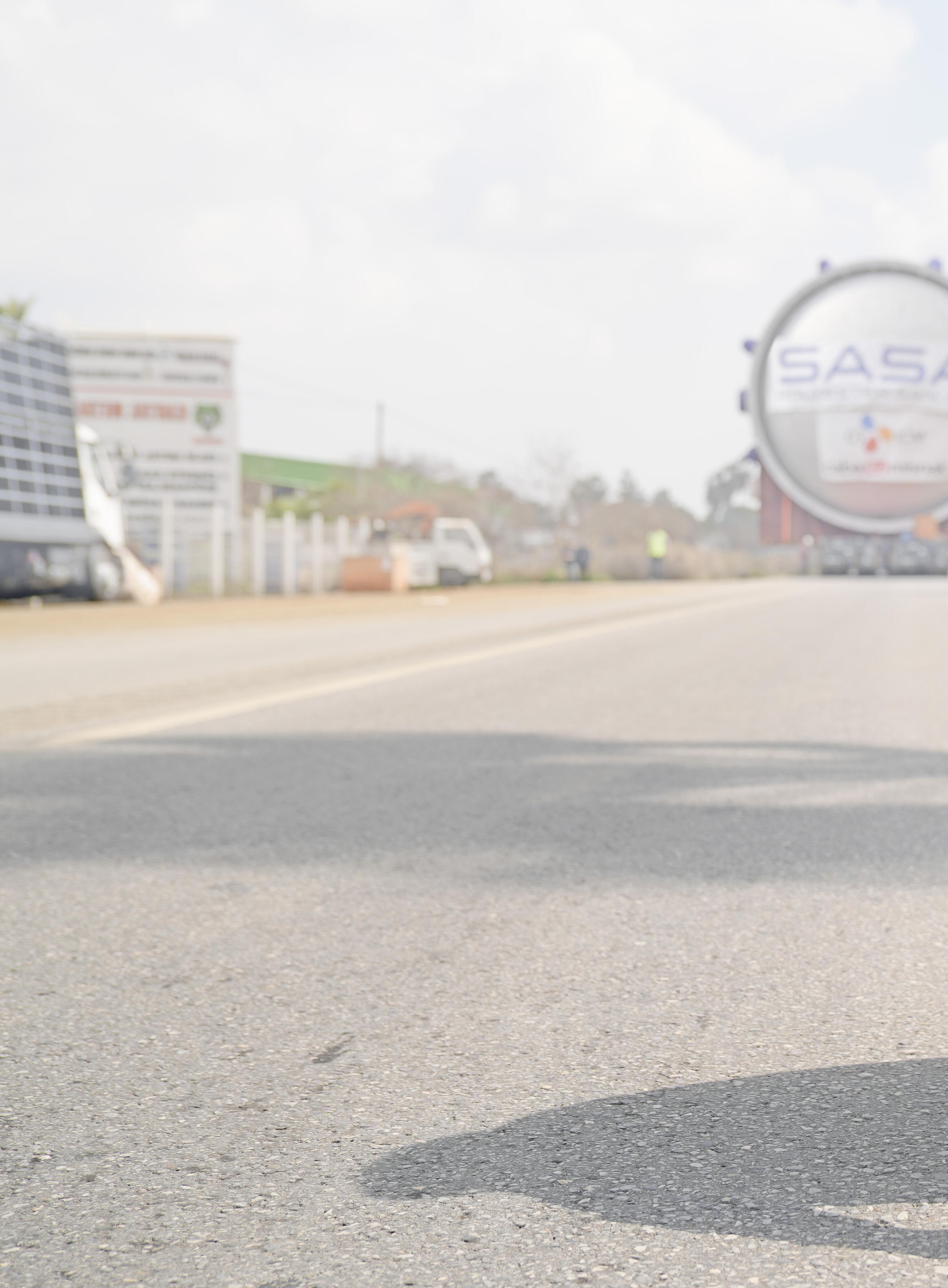
“These were extremely large units that could not be assembled on site, and which were required to be transported nearly 60 kilometers through city centers, over bridges, and under power cables,” said Çelikoğlu, who previously worked as a project engineer for Misnak in Iraq and, until 2021, heavy transport deputy manager for Türkiye-based Hareket
The demanding project called for bypass roads to be built and 120 powerlines that supply electricity to 71,000 consumers temporarily shut down. Transport operations were carried out during daylight hours to comply with local health and safety rules.
Disaster Strikes
As well as obstacles along the route, the PTA project faced some sizable external challenges, including disruption to supply chains during the Covid pandemic and “unwanted complications between neighbors,” as Çelikoğlu put it.
But while dealing with such pressure is part-and-parcel of a successful
Petrochem Producer Mobilizes Resources for Search and Rescue Support
career in logistics, very little could prepare even the most experienced project professional for the events that unfolded on February 6 last year when a devastating 7.8-magnitude earthquake struck southern Türkiye and northern Syria. The earthquake, which killed more 55,000 people, was centered close to the city of Kahramanmaras, just 200 kilometers from Çelikoğlu’s home in Adana.
Çelikoğlu’s first thoughts in the immediate aftermath of the disaster were for his family in Adana. To ensure their safety, the executive insisted they move to another city, while he and his colleagues remained in Adana sleeping in tents or in their cars, until they could return safely to their apartments. SASA’s resources were quickly mobilized to assist with the rescue efforts and provide support to emergency workers. Forklifts, trucks, and other heavy-duty equipment normally used to handle cargo were now being deployed to clear rubble and search for survivors. “It was tough, it was stressful, but everybody was helping
54 Breakbulk Magazine Issue 2 2024 breakbulk.com
Profile


each other. Because of that, we were able to deal with the situation,” he said.
Knowing his family was safe and that SASA was doing all it could to assist with rescue efforts, Çelikoğlu’s attention turned to the imminent arrival of a shipment of project cargo destined for the PTA project. Because of severe damage to Iskenderun Port, the vessel carrying the units was diverted to Mersin, Türkiye’s main gateway to the Mediterranean Sea and one of the country’s largest handlers of container cargo.
But congestion there meant the ship was unable to dock, and Çelikoğlu and his team – concerned that such costly cargo was sat waiting in open water – found themselves working day and night trying to persuade local officials to allow the vessel to berth.
After a week of tense meetings, the vessel was finally given the all clear to enter Mersin, and the cargo was unloaded safely onto waiting SPMTs. The overland transport to the construction site caused further headaches, with traffic jams, blockades and fractured roads increasing the transit time from eight to 15 days. “It was chaos and handling all those things while facing the earthquake at the same time was one of the biggest challenges for us,” Çelikoğlu said.
As victims of last year’s disaster continue to rebuild their shattered lives, the focus has shifted towards bolstering resilience and readiness should catastrophe strike again. Like
many companies in the region, SASA has since invested heavily in training programs and disaster preparedness initiatives. “We’ve made many improvements and have done exercises if we faced this again. We all now know very well what we need to do. Every day, we are learning and preparing ourselves for another emergency.”
Road to Recovery
According to Çelikoğlu, the task of rebuilding Türkiye’s heavily hit southern region is still ongoing, complicating the movement of project cargoes. Iskenderun Port is operating at just half capacity, while Mersin remains heavily congested. “Roads, railways, and some airports were damaged,” the executive said. “Repair work is still going on in some parts, so logistics are affected badly. We’re still trying to bind up the wounds.”
After such devastation, a speedy return to normalcy is crucial, and for Çelikoğlu and his colleagues, that means planning for the next phase of SASA’s US$20 billion investment drive in Adana and along Türkiye’s southern coast.
The company has already begun work on its next project – a 2.5 million TEUcapacity greenfield port at the coastal town of Yumurtalik some 50 kilometers south of Adana. The project, currently in its design stage, will comprise general cargo, container, liquid, and roll-on, roll-off terminals, with construction of a first phase slated to begin in 2025.
Parallel to that investment, the company is planning to install an
unspecified number of petrochemical plants and an oil refinery directly behind the port area.
“We expect a lot of project cargo to be shipped to the construction site via our own port in Yumurtalik during the installation stage of the petrochemical plants and oil refinery,” Çelikoğlu said. “I think that we have made significant contributions to the presence of project logistics in Türkiye with the investments we are undertaking.”
Last year’s trauma has certainly not dampened Çelikoğlu’s bright outlook for Türkiye’s breakbulk and project sector. According to the executive, Türkiye’s auspicious location is a huge advantage, with companies choosing to open branches along the country’s strategic southern coast to get closer to key markets such as Saudi Arabia and the UAE.
“It is very useful for forwarders to have this base between the Middle East and Europe, and the government is supporting new investors to open offices and to receive benefits such as credits,” he said. “15 years ago, there were maybe only two or three companies transporting project cargoes. Now, more than 20 companies are involved in heavy transport. They see the great potential we have.”
Colombia-based
* Breakbulk Europe Exhibitor
SASA is a member of the Breakbulk Global Shipper Network www.europe.breakbulk.com/page/bgsn
56 Breakbulk Magazine Issue 2 2024 breakbulk.com Profile
Simon West is senior reporter for Breakbulk.
Transporting components to SASA petchem plant. Credit: SASA
Register now for the world's largest project cargo and breakbulk event
21-23 May 2024 | Rotterdam, Ahoy

europe.breakbulk.com
By Dr Sven Hermann
CLOSING THE LOOP WITH CIRCULAR LOGISTICS
Increasing Focus in Sustainable End-to-end Logistics Solutions
It can be assumed that the major challenges and uncertainties of our time will increase rather than decrease in the coming years. Taking a look at selected current issues shows the major developments and decisions that will be made in the coming months. What will happen in the conflict in the Middle East? How long will the war in Ukraine continue? What about the Green Deal after the European elections? What will it mean for Europe if Donald Trump becomes president again in the U.S.?
And how will relations between China and the West develop?
Whatever the answers to these questions turn out to be, they will also have a major impact on the development of project logistics. These uncertain times could therefore tempt us to adopt an even more cautious approach, postponing investments in holistic improvements and paying less attention to the change necessary to shift to a more sustainable economic model.
However, there is hope that the

course toward greater sustainability – that has only just been embarked upon in many places – will remain in place for project logistics companies. It is a course that is ultimately thought through holistically, in cycles, and would bring with it a much higher degree of resilience.
The basic coordinates of this endto-end approach have long been on the table. With transparency, cooperation, technology and the continuous striving of all partners for constant and collaborative improvement, processes in project logistics could be improved far and wide.
However, despite all the wellmeaning intentions, there is usually a hitch somewhere. In addition, the traditional linear approach from engineering to the construction site has not yet done justice to the concept of sustainability.
The cycle-orientated model of the circular economy offers a promising orientation option here. Important topics such as shared logistics, more sustainable transport alternatives and opportunities to reuse and recycle packaging are coming more into focus.
Embracing Sustainability
The following industry quotes illustrate the vigor with which the shipper side is currently promoting sustainable end-to-end approaches despite all the challenges.
58 Breakbulk Magazine Issue 2 2024 breakbulk.com
Thought Leader
A fully modularized process unit for a polyol production plant.
Credit: thyssenkrupp Uhde

“Going forward, it is imperative that logistics companies integrate environmental, social and governance criteria more fully into their daily operations,” said Andreas Ulrich, global head of logistics at SMS group. “The availability of comprehensive real-time data, which remains one of the biggest barriers to complete and sustainable end-to-end logistics solutions, is a key factor in achieving this. Currently, the challenges arising from increasing regulation are overemphasized, while the transformative potential of an expanded service portfolio for upstream players is not fully exploited. The logistics sector has significant untapped potential for innovative business models and collaborative task sharing. For this reason, we are currently focusing on collaborative approaches for improvements and solutions. We are also working closely with our logistics partners to promote these developments through ongoing training and innovation initiatives.”
Meanwhile, André Starke, head of project logistics at Andritz Hydro, said: “Our logistic setup is following new approaches and concepts to meet the requirements of a modern project landscape but also to mitigate the challenges of skilled labor shortages and growing environmental needs.
“In the course of the last 10 months, we have already made substantial progress thanks to the support of our internal stakeholder, but also due to the commitment of our project logistics
provider. We can already recognize improvement during the execution of our hydropower projects in Southeast Asia and other parts of the world. The early involvement in engineering, extensive feasibility studies, HUB consolidation at strategic locations and on-site logistic support allow us to reach our goal of an integrated logistics in particular for larger projects.
“The basis for all this is the common approach together with our project forwarder, but also new IT interfaces to allow a proper deviation tracking and supplier management. Working together on a steady improvement of these processes will provide new opportunities also for our partner as we can only reach these holistic goals following the same path together.”
Reference Point
Daniel Duus, global head of logistics at thyssenkrupp Uhde, gives his observations: “thyssenkrupp Uhde has been awarded a contract by ENOWA, NEOM’s energy and water company, for engineering services and the supply, design and procurement of equipment for a new CO2-to-methanol and methanol-to-gasoline demonstration plant at ENOWA’s Hydrogen Innovation and Development Center in Saudi Arabia. This project is contributing to the reduction of global emissions and a huge milestone for climate protection.
“Together with the involved logistics partner and scientific support, our aim will be to analyze existing
processes and procedures, react proactively to changes, learn from the project and jointly develop a kind of blueprint for the holistic end-toend logistics of tomorrow. Our farreaching modularization and transport engineering expertise will certainly continue to play an important role in this as it gives us major advantages in terms of risk management and adherence to scheduling, among other things.”
Logistics companies are showing their willingness to actively help shape the change towards more sustainable project logistics and to incorporate the basic principles of a circular economy into the development of their services and future business models. Current training programs and innovation workshops – such as ProLog’s E2E Master Class Project Logistics – offer the opportunity for both sides to exchange ideas about their plans and to look for new ideas together.
The question of how the industry is currently shaping their end-to-end logistics for a more sustainable future will be the subject of a panel discussion at Breakbulk Europe in Rotterdam, featuring three ongoing energy projects in Europe, Laos and Saudi Arabia.
www.europe.breakbulk.com/home
Dr. Sven Hermann is professor of logistics and supply chain management at the NBS Northern Business School Hamburg, and founder and managing director of ProLog Innovation GmbH, a consultancy for organizational development and innovation management, particularly in logistics.
59 Breakbulk Magazine Issue 2 2024 breakbulk.com
Leader
Thought
Left to right: Andreas Ulrich, Daniel Duus, Sven Hermann, André Starke.
By Malcolm Ramsay
TRYING TERRAIN COLLETT TURBINE
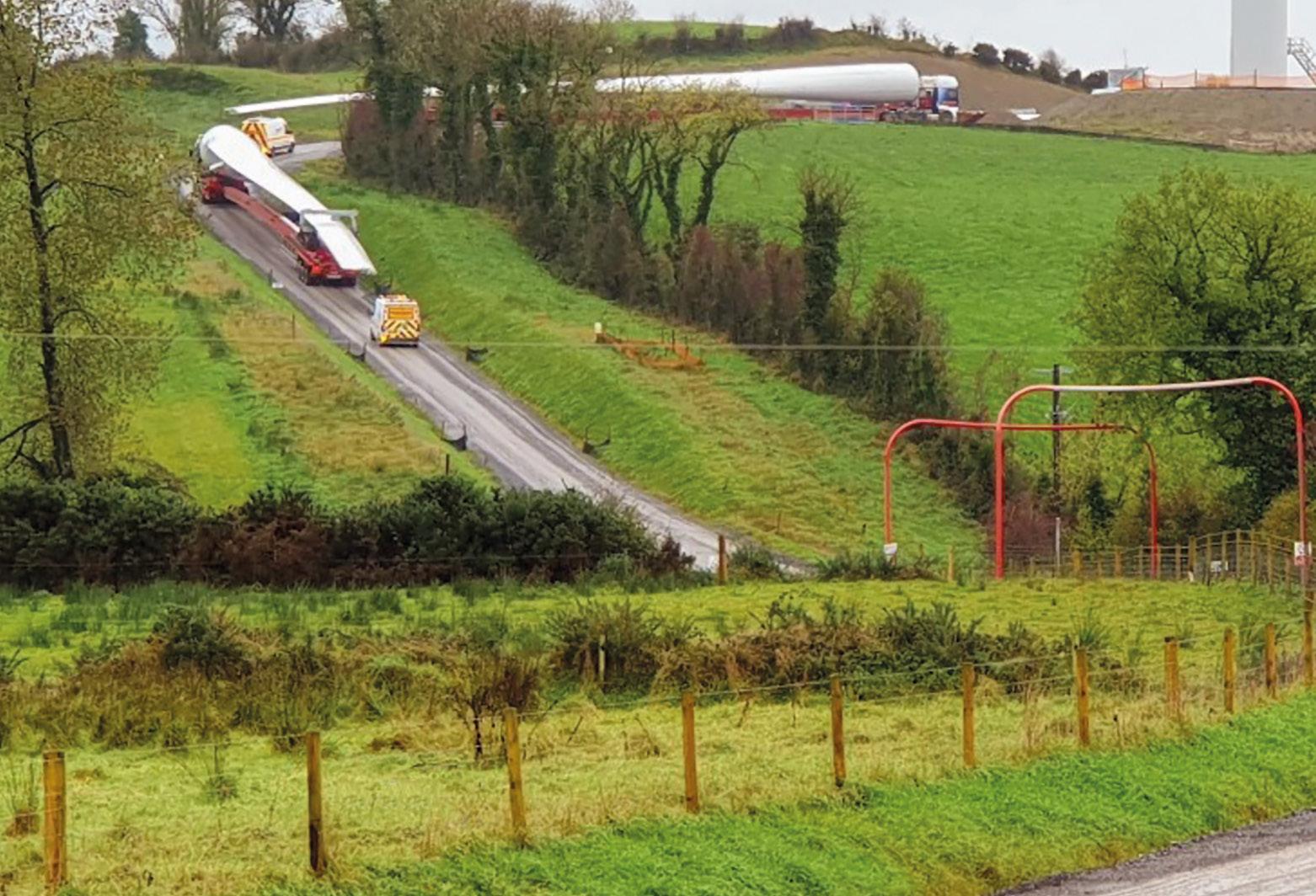
Partnerships Smooth Out ‘Sharp Corners and Pinch Points’
County Monaghan in the northeast of Ireland is known for its windswept landscapes, making it the ideal location for a wind farm, but with many narrow, winding roads it is not best suited for delivery of outsized components. This was the task faced by a group of logistics experts when turbine blades measuring over 60 meters in length and ancillary equipment was scheduled for delivery to the new Drumlins Park Wind Farm.
Located near the small village of Newbliss, around 60 kilometers from the coast, this new wind farm is under development by Irish utility Energia and will generate 49 megawatts of renewable energy, supplying enough electricity for around 34,000 Irish households.
Consisting of eight wind turbines in its first phase, the site was granted planning permission in 2020 with first construction beginning in 2022.
Summary:
Deep dive on the logistics of transporting giant turbine blades over 60 meters long and tower sections from Germany to a wind farm site in Ireland. Extreme care was taken in planning routes, securing permits, and moving the components safely along narrow rural roads with sharp turns to deliver the cargo on schedule.
By the summer of 2023, the ground was prepared for arrival of the largest components and heavy haulage firm Collett & Sons was selected to carry out the difficult logistics.
“Our Renewables Department bid for the project submitting a quote and once selected we proceeded to conduct detailed pre-planning to identify potential challenges along the transportation route,”
Roy Edmondson, project manager at Collett & Sons, told Breakbulk
This planning stage involved comprehensive route surveys and detailed analysis to identify essential modifications, such as tree pruning and adjustments to street furniture, all designed to ensure a safe delivery process. In total, the project required delivery of 88 components with each turbine unit comprised of 11 components, including three blades, three blade tips and five tower sections.
The main bulk of the cargo consisted of blade and tower section components for eight GE 158RD turbines. These giant turbines each have a span of over 60 meters once constructed, which will make them one of the longest blades of any turbine in Ireland once complete.
“This is the first time GE Renewable Energy’s 6.1-megawatt onshore wind turbine will be used in Ireland,”
60 Breakbulk Magazine Issue 2 2024 breakbulk.com
Europe
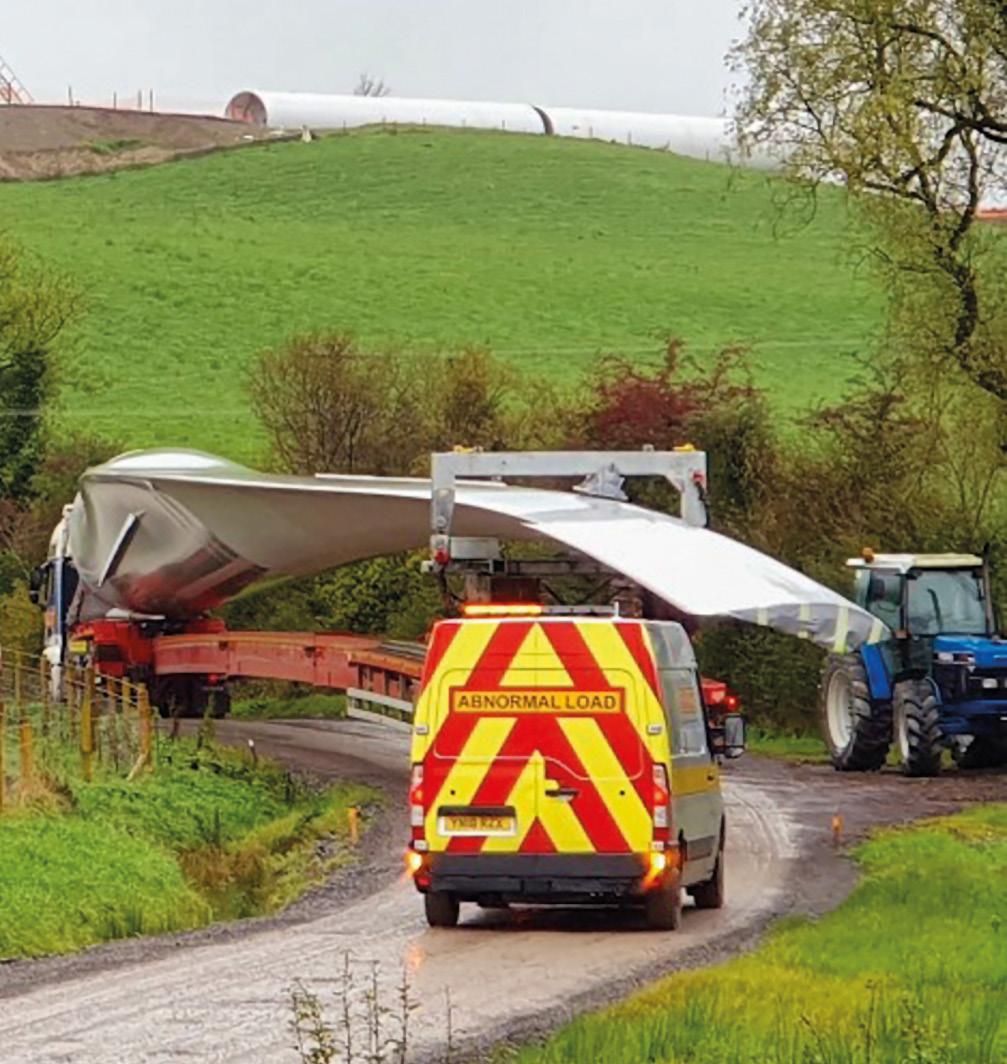
FOR
MOVE
a spokesperson for GE Renewables said. “We’re pleased to be working with Energia Group contributing to Ireland’s Climate Action Plan and help the country reach its net-zero pledge.”
The agreement between Energia and GE includes a 25-year full-service contract, and the site itself is projected to have a 30-year operational life.
Careful Preparation
Given the scale of the pieces, the project required careful coordination and Collett & Sons deployed a dedicated team of eight professionals to ensure the smooth running at all stages. This team comprised a project manager overseeing all deliveries, three truck drivers, three escort vehicle drivers, and a tow truck driver. The project manager also ensured continuous communication between all partners to make sure everyone was aligned at each step.
“A daily meeting was held containing all required partners
to keep everyone in the loop with regards to delivery dates, times and what components were being delivered,” Edmondson noted.
Having studied numerous potential paths to deliver the cargo, Collett identified a route via the Port of Waterford in the south of Ireland. Following manufacture of the components at GE’s onshore turbine fabrication facility in Salzbergen, Germany, they were scheduled for delivery to the port in two shipments in the summer of 2023.
“The tower sections and blades arrived on two vessels - the Rolldock Star in late July 2023 and Unistream in mid-August 2023,” Derek Madigan, terminal operations and business development manager at the Port of Waterford, explained. “The tower sections and blades were then discharged by two Liebherr mobile harbor port cranes, one of which had a 250-tonne capacity and the other 280-tonne.”
Ahead of discharge of the vessels and then storage and reloading of the individual items, the authorities at Port of Waterford forwarded risk assessments and method statements to the GE Wind surveyors and conducted detailed toolbox talks, preparing logs for handling equipment and lifting equipment, including spreader beams, chains, slings, and shackles.
Trailer Loading
With this work complete, the first tower sections were loaded on trailers and shunted to the Celtic Shipping Storage yard within the port environs, less than one kilometer from the quay.
“At the Celtic Shipping Storage yard, the tower sections were discharged by two 35-tonne Linde reachstackers from the trailers and placed in the allocated storage area for each of the five individual tower sections,” Madigan said. “The tower sections remained in the storage area until 48-64 hours prior to transport when the lifting frames and feet were removed to allow the trucks and trailers to clamp the tower section for delivery to the wind farm site.”
Upon arrival of the blades, they were transported from the vessels to the allocated storage area at the container terminal, less than 200 meters from where the ships were berthed and discharged. At the terminal, the blades were then stacked three high using two 35-tonne reachstackers and, when required, two 40-tonne long span gantry cranes.
“The blades were fitted with sensors while they were stored on quay,” Madigan said. “A set of three blades were made ready 24-48 hours in advance of collection by Collett, as frames had to be removed from the blades to allow transport to the wind farm site at Drumlins. The loading of the blades was done by the long-span gantry cranes on occasion, and at other times, if the gantry cranes were busy, both reachstackers were used.”
61 Breakbulk Magazine Issue 2 2024 breakbulk.com
TURBINE
Europe
Exceptional Load Services secured permits and liaised with local authorities.
Credit: Collett & Sons
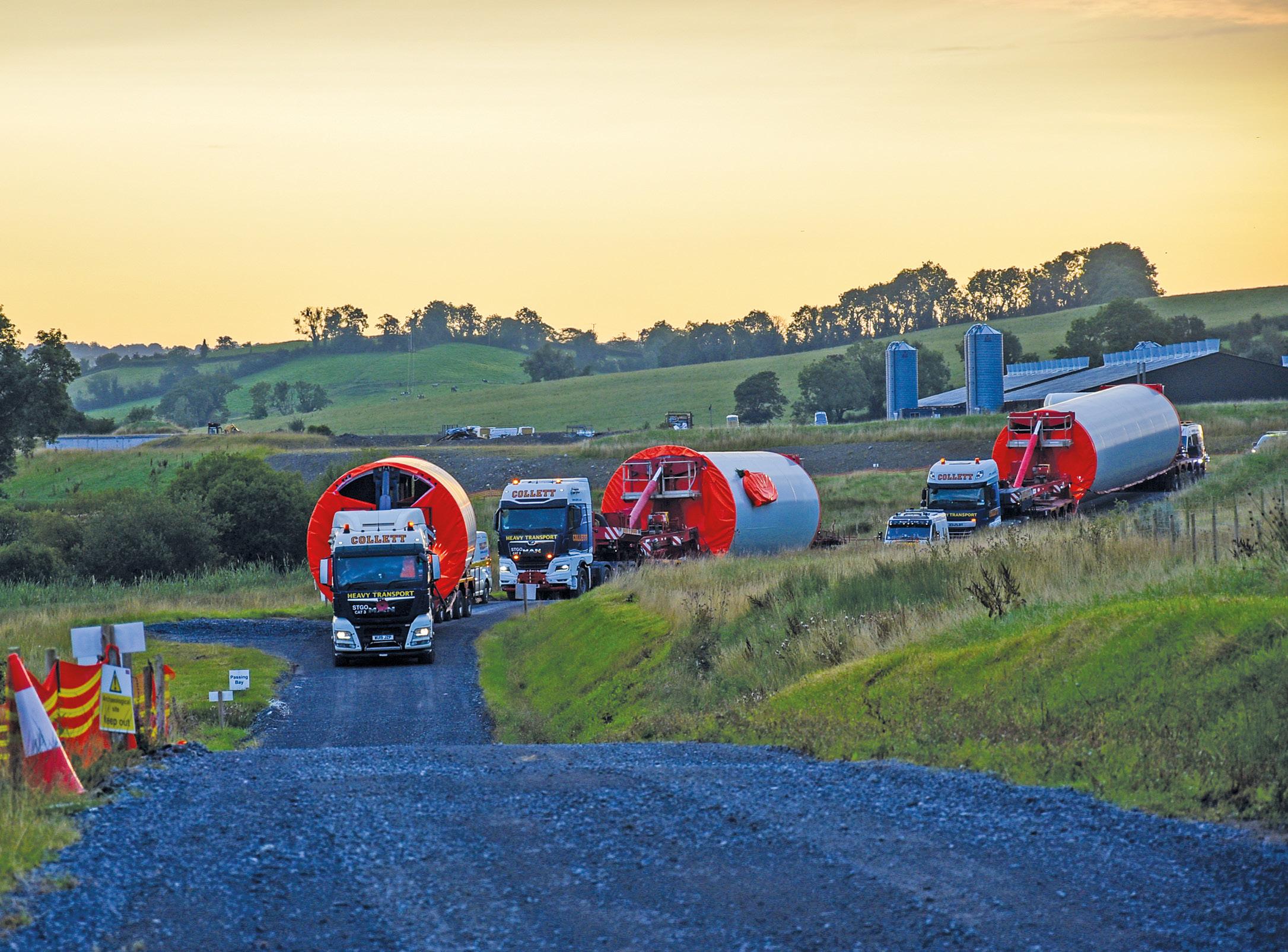
The blades then departed the port in the evening for overnight delivery with any obstacles between the container storage and the main road cleared in advance. This included comprehensive traffic management measures to facilitate the smooth exit of trucks and trailers from the port.
“The key to the success of the whole project from our point of view was the clear communication between the port stevedores and Collett Transport of what was required, when it was required and any changes to plans being quickly communicated,” Madigan said.
200-mile Journey
“THE KEY TO THE SUCCESS OF THE WHOLE PROJECT FROM OUR POINT OF VIEW WAS THE CLEAR COMMUNICATIONNS...” DEREK MADIGAN, PORT OF WATERFORD
a critical role in this stage, securing necessary permits and liaising with local authorities, including arranging and coordinating with Garda (Irish police) escorts.
Given the scope for delay or disruption in crossing Ireland’s road network, Collett & Sons ensured the three drivers were highly skilled and well prepared, and a high level of communication was sustained between all team members throughout the night’s transport.
For the remaining tower sections components, we used Scheuerle and Nooteboom trailers as they are specialist equipment specifically used for tower section components.”
The team used flattop trailers for the additional 15-meter-long blade tip and tower clamp trailers for the various tower sections.
‘Sharp Corners and Pinch Points’
For the next phase of the project, Collett had to transport the components nearly 200 miles to the project site on the other side of Ireland. To ensure success, the team partnered with local heavy-lift specialists Exceptional Load Services, or ELS.
Edwin Sunderland, senior logistics consultant at ELS, played
With the longest tower sections measuring 28 meters in length and the heaviest weighing 62 tonnes, Collett quickly recognized the importance of selecting the correct combination of trailers, opting for the well-tested Super Wing Carrier trailer for the tricky blade transport.
“We chose Super Wing Carriers due to their maneuverability,” Collett’s Edmondson said. “We have used them multiple times before and they are the only trailer that would get round the corners with the blades loaded.
Having set off from the Port of Waterford, the initial section was quick going, traveling along the major M1 and N2 routes to Monaghan Town, around 17 kilometers from the Drumlins Wind Farm Park. From there, the route became more arduous, however, as it switched along the R188, R183 and R189 via Swans Cross and Newbliss to the site entrance, traversing increasingly difficult terrain.
“The route from Monaghan onwards was specifically tricky with multiple sharp corners and pinch points along the route,” Edmondson
62 Breakbulk Magazine Issue 2 2024 breakbulk.com
Europe
Collett had to transport the components nearly 200 miles to the project site.
Credit: Collett & Sons

said. “To tackle these challenges, the vehicles frequently had to slow to a walking pace and a mixture of experience, skill, communication and dedication was required to ensure the blades navigated each obstacle safely and in a timely manner.”
The first sections arrived at the site in September 2023 and construction quickly commenced on the first turbine with the successful installation of T6 completed in October - including tower, nacelle and blades. By the end of the year, a further three turbines were installed with four remaining to be finished in early 2024.
Hailing the successful arrival of the blades onsite, Energia Renewables Head of Construction Patrick Tierney said: “This was a significant milestone for the Drumlins Park Wind Farm construction team, bringing energization and the start of renewable electricity generation one step closer. In particular, I would like to thank our specialist haulier, Collett & Sons, together with everyone involved in

the strategic and logistical planning of this project. It takes a lot of hard work, coordination, partnership working and meticulous detail to get these components to the site, while ensuring that disruption for road users and residents is kept to a minimum.”
The Drumlins Wind Park is scheduled to become commercially operational in 2024 with a Community Benefit Fund set to be established after one year,
providing funding for initiatives in the local community and administered by an independent charitable foundation.
Based in the UK, Malcolm Ramsay has a background in business analysis and technology writing, with an emphasis on transportation and ports.
*Breakbulk Europe exhibitor.
Visit: www.europe.breakbulk.com/home
*BGSN member
63 Breakbulk Magazine Issue 2 2024 breakbulk.com Europe
Collett selected the Super Wing Carrier trailer for the blade transportation.
Credit: Collett & Sons
Traversing Ireland’s road network required skilled drivers.
Credit: Collett & Sons

CHILE SEEKS TO SPEED UP PROJECT APPROVALS
By Simon West
Forwarders Welcome Plans to End “Nightmare” Permitting Process
Chile’s plans to overhaul the sluggish pace at which approvals are granted for investment projects have been welcomed by project forwarders.
The South American country boasts one of the region’s most dynamic project markets, with energy, infrastructure, mining, desalination, and cement production steadfast sources of project work. But slow and cumbersome permitting rules are a constant concern, stifling the timely execution of industrial projects, hurting investor confidence, and curbing opportunities for logistics and shipping.
“The permitting process in Chile has become a nightmare for companies in the mining and energy sectors,” said Alberto Oltra, CEO for South
America and country manager for Chile at DHL Global Forwarding.
Draft legislation, put forward in January by President Gabriel Boric, aims to tackle what critics have dubbed “permitology,” and comprises two new bills: A first to simplify and speed up sectoral permits and a second to fasttrack environmental assessment.
If approved by Congress, the first bill would create a so-called Intelligent Permit System covering hundreds of investment projects across the board, from large-scale copper mines to new warehouses.
The system would include a new public entity charged with ensuring compliance with processing standards and a digital single point of contact,
dubbed the SUPER platform, which would allow project owners to track the status of their permit applications. The bill would reduce permit processing times by about a third, the government said.
The second bill would see an overhaul of Chile’s environmental impact assessment system (SEIA) aimed at reducing approval processing times. The new law would do away with two ministerial committees that currently oversee the appeals process, replacing it with an environmental assessment service (SEA) that would handle all petitions. The SEA would have final say on whether a project is approved or rejected.
The bill also attempts to resolve the
64 Breakbulk Magazine Issue 2 2024 breakbulk.com
Americas
Dusk at BHP’s Spence copper mine in northern Chile. Credit: BHP
socio-environmental conflicts that plague so many industrial projects in Latin America by clarifying the rules governing the relationship between investors and local communities.
Carlos Cruz, a former transport minister and current executive director of Chile’s Infrastructure Policy Council, said the draft bills “clearly” address the challenges that investors currently face. If approved, the role of institutions would be more clearly defined to prevent one entity from “invading” the space of another, Cruz said, while public bodies would be sanctioned if they failed to meet specific deadlines during the permitting process.
Project forwarders speaking to Breakbulk applauded the proposals.
A spokesperson for UTC Overseas, which launched a base in Chile in 2003, said the acceleration of sectoral permits was necessary to “reduce bureaucracy,” while Rodrigo Izquierdo, deputy general manager at Santiagobased Integral Chile, said the overhaul was “deeply needed,” adding that dealing with current red tape to get projects off the ground was “no small feat.”
“As a freight forwarder that manages project cargo, Integral Chile will definitely support this improvement and will be very attentive to it when it comes out,” Izquierdo said. “From our perspective, when you learn about a coming project – or possible coming project – you start investigating and trying to gather as much information as possible. But then you continue checking again and again about the project’s status, and you see no updates. With shorter evaluation times, a more efficient process and a better deal of information, Chile will attract more investment and there will be more projects (being executed).”
A Green Energy Hotspot
Chile has emerged in recent years as one of the world’s green energy hotspots. The government wants 70 percent of the nation’s power to come from renewables by 2030, a target

generating plenty of opportunities for breakbulk. Boric, who took office in March 2022, has pledged to toughen regulations governing fossil fuels and mining and install 500 megawatts (MW) of power generated from wind, solar and other clean sources.
The country boasts an abundance of natural resources that include the Atacama Desert, a sunbaked plateau in northern Chile ideal for large-scale photovoltaic (PV) development.
Projects such as the 480-MW CEME1, billed as the largest solar PV park in Latin America, has cemented Chile’s status as a global renewable energy powerhouse. Slated to enter commercial operations in 2025, CEME1 is calling for the installation of 860,000 solar panels across more than 400 acres of Atacama wilderness.
Chile is also looking to become a significant player in green hydrogen production, targeting 25 gigawatts (GW) of capacity by 2030.
Notable projects include French renewable power company Total Eren’s H2 Magallanes Project, a mega-scale green hydrogen plant located on the windy Strait of Magellan. The project calls for the development of 10 GW of onshore wind power capacity to power an 8 GW electrolyzer plant, a desalination plant to make clean water to feed the electrolyzers, and an ammonia plant to turn the hydrogen product into green ammonia.
With such potential for buildout, project forwarders in Chile will be banking on Congress to scrap the administrative barriers that hinder development.
“The elimination of unnecessary processes is always very welcome,” said DHL’s Oltra. “If this is the case, in Chile we will see an increase in economic activity and of course, there will be more opportunities for our Industrial Projects department.”
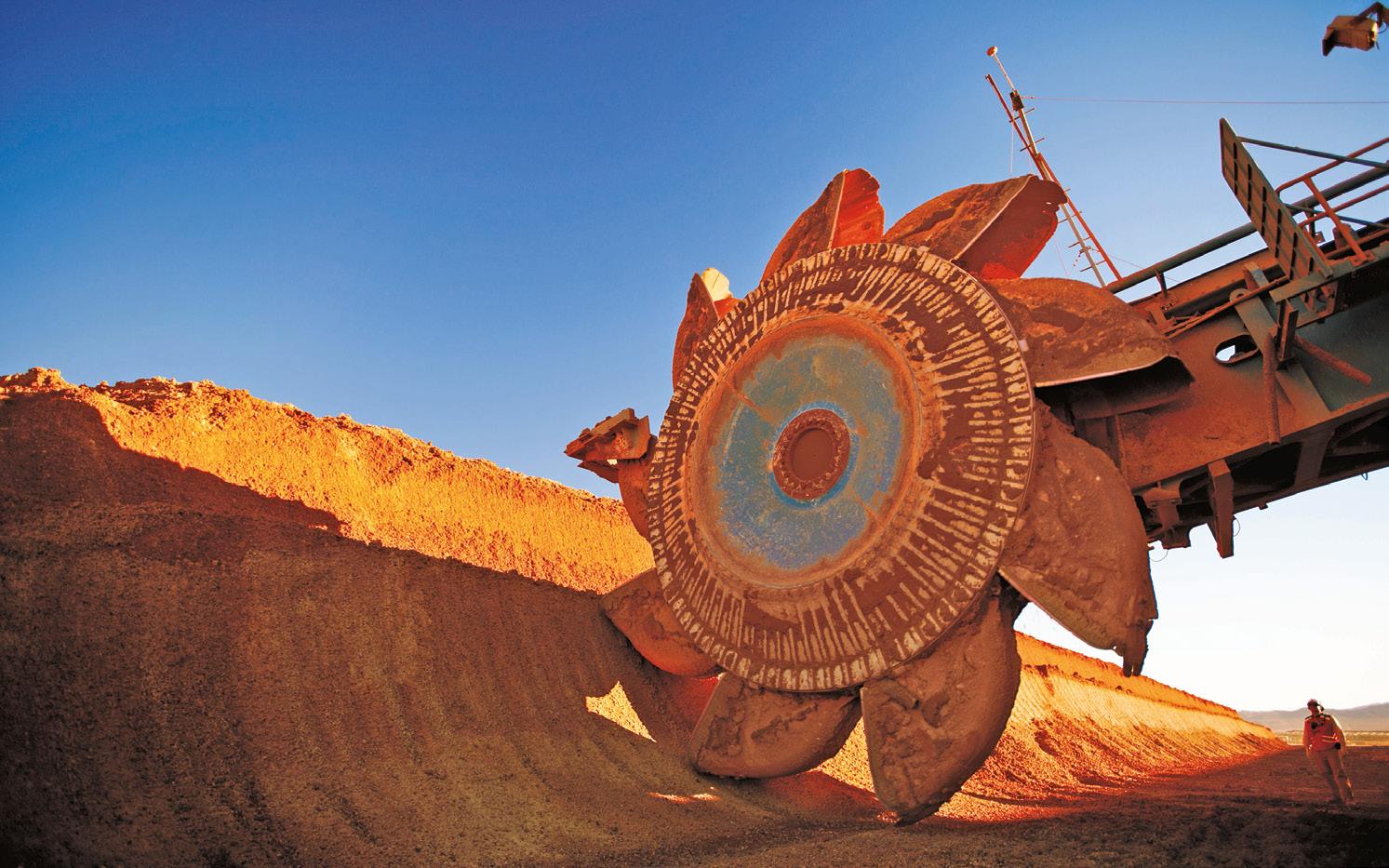
65 Breakbulk Magazine Issue 2 2024 breakbulk.com
Americas
Colombia-based Simon West is senior reporter for Breakbulk
Rodrigo Izquierdo
Excavator in operation at BHP’s Spence copper mine in northern Chile.
Credit: BHP
Breakbulk Europe Exhibitor Visit: www.europe.breakbulk.com/home
 By Carly Fields and Simon West
By Carly Fields and Simon West
US WIND PROJECTS SET BACK, NOT STALLED
Supply Chain Issues, Escalating Costs Are Surmountable
Several U.S. offshore wind ventures face uncertainty as escalating costs compel developers to terminate agreements and incur substantial losses. The combination of rampant inflation, high interest rates, and supply chain disruptions has driven up installation expenses for expansive arrays along the U.S. Eastern seaboard. Despite pleas from developers, state regulators have so far rebuffed requests for adjustments to contracted electricity rates, constraining profit margins.
Project cargo movers are closely watching the situation in the U.S. –
which is mirrored in the UK – to see if government will heed the cries of renewables engineering, procurement and construction companies on the perils of rising project-crippling costs.
Late last year, Ørsted, a global leader in offshore wind, halted progress on its Ocean Wind 1 and 2 projects in New Jersey, totaling 2.2 gigawatts (GW). The Danish firm said it anticipated impairments up to US$5.6 billion due to heightened expenses and logistical setbacks. In an announcement, Ørsted specifically referred to “vessel delay” on Ocean Wind 1 that “considerably impacted project timing.”
Summary:
Several large offshore wind projects in the U.S. have been delayed or canceled as developers are unable to negotiate higher power purchase rates from state regulators to account for inflated installation expenses. Rising interest rates and supply chain disruptions have also significantly driven up project costs. Yet, demand for renewable power remains strong and projects are expected to continue once pricing disagreements have been resolved.
66 Breakbulk Magazine Issue 2 2024 breakbulk.com
Americas
The first turbine is installed on South Fork Wind. Credit: Ørsted
In the media, Ørsted’s CEO, Mads Nipper, expressed regret over early-stage investments in Ocean Wind 1, advocating for a reassessment of offshore wind pricing to align with escalating costs.
Meanwhile, oil and gas giants BP and Equinor have tinkered with their ownership of the Beacon and Empire offshore wind initiatives in New York. Both projects were previously being jointly pursued. But in January, an agreement to restructure resulted in bp taking ownership of Equinor’s 50 percent stake in the Beacon Wind 1 and 2 projects and Equinor taking ownership of bp’s 50 percent stake in the Empire Wind 1 and 2 projects. In addition, bp agreed to take ownership of Equinor’s 50 percent interest in the Astoria Gateway for Renewable Energy site and, subject to certain future conditions, Equinor has agreed to take ownership of bp’s 50 percent interest in the South Brooklyn Marine Terminal. Under the agreement, the companies will work independently to develop their wholly owned projects.
Beacon Wind 1 and 2 comprise a combined area of 128,000 acres in federal waters between Cape Cod, Massachusetts, and Long Island, New York. The combined potential generative capacity of the projects is more than 2.5 GW which has the potential to deliver renewable energy to over 2 million consumers in the northeastern U.S.
In total, a minimum of ten U.S. East Coast projects have sought to renegotiate offtake prices, according to press reports, and the consequent contract terminations and broader project uncertainties could pose an early setback to U.S. offshore wind aspirations.
Impact of Cost Increases
Thomas Wylie, head of global strategic projects and accounts at deugro, said: “The situation for both the UK and the U.S. wind sectors is problematic. Governments need to acknowledge that costs for these long-term

offshore wind commitments have increased since the pandemic.”
That said, the global offshore wind industry is still poised for substantial growth, he said. “From a client perspective, there is anticipation of a proliferation of projects worldwide over the next 2-3 years. The UK and the U.S. are expected to play prominent roles.”
However, a crucial factor in realizing these projects is having the supply chain in place, along with pricing stability and investment incentives. “Governments must make long-term commitments to support these offshore wind projects and provide assurances regarding pricing stability to incentivize investment. Nevertheless, both in the UK and the U.S., there are obstacles hindering progress. This uncertainty affects the supply chain, leading to hesitancy in investment in assets,” Wylie said.
Marco Poisler, chief operating officer, global energy and capital projects at UTC Overseas, also saw the supply chain as a key challenge to offshore wind ambitions in the U.S. “There is a challenge with having the availability of competitive U.S. maritime assets. The Jones Act is a challenge, but I think that can be overcome as well – there are some newbuilds and a lot of local shipyards are busy with work. At the end of the day, from an investment strategy, we have to see if these will be backed and financed by governments.”
If projects are either delayed or canceled, decision-making regarding supply chain resource investment
becomes challenging, Wylie added. “Yet, it’s imperative to invest now to facilitate execution in the coming years. While this presents a short-term setback, the demand for offshore wind projects remains strong, indicating that this is merely a temporary blip with long-term ramifications.”
deugro is dedicated to supporting offshore wind projects and has operated two vessels between mainland Europe and the UK for an OEM partner for the past decade. Recently, deugro modified those vessels to accommodate larger wind turbine components. “Additionally, for the U.S. market, we are currently constructing two larger vessels capable of handling bigger components. We are committed to serving the offshore wind sector in the future.”
Government Support Needed
UTC’s Poisler led a panel discussion in Houston to address the challenges facing the maritime and logistics industries as more offshore wind projects are announced in the U.S.
An expert panel of speakers discussed a variety of topics including the availability of vessels and vehicles needed to transport equipment, permitting, marshalling, skilled labor training, as well as federal funding for infrastructure initiatives supporting the industry and how the Jones Act comes into play with governmentfunded decarbonization projects.
While UTC does deem the U.S. offshore wind sector a “key” market for project logistics, Poisler said to Breakbulk that there are “some apparent setbacks with some of the government support in the northeastern states. But it’s going strong in so many ways – we have new investors coming in and tremendous gigawatt potential there in the region.”
He said that the issues may well necessitate a reassessment of the U.S. government’s target of 30 GW of installed capacity by 2030. “We’re probably lucky if we get half that.
67 Breakbulk Magazine Issue 2 2024 breakbulk.com
Americas
Marco Poisler

That’s due to high supply chain costs that have gone up since the original financing, and interest rates are higher. And I think the reality is that for many of those projects, what it costs today has set it back. But saying that, it’s still very interesting for project cargo.”
Despite its setbacks in the U.S., Ørsted agrees. Speaking in an Ørsted release, David Hardy, group executive vice president and CEO Americas, said: “We remain committed to the U.S. renewable energy market, building clean power that will create jobs across technologies and states from the Northeast to Texas. Offshore wind energy remains an integral solution to helping the U.S. meet its clean energy ambitions, including job creation, a domestic supply chain and a reinvigorated maritime industry.”
Projects Taking Shape
Hardy is right to say that it is not all doom and gloom in the U.S. wind sector. Some U.S. offshore wind projects have experienced relatively minimal impacts from escalating costs and interest rates, with timing playing a crucial role in this resilience. In October, Ørsted and Eversource took the final investment decision for their 704 MW Revolution Wind endeavor situated off the coasts of Rhode Island and Connecticut. While onshore construction is already underway, offshore construction is slated to commence in 2024, with project completion anticipated in 2025. Notwithstanding the impairment of DKK 3.3 billion that Ørsted is recording in its Q3 results, Revolution Wind has an “attractive forward-looking value creation with a forward-looking
spread to WACC above Ørsted’s guided range,” the wind specialist said.
And prioritized construction schedules for the 800 MW Vineyard Wind 1 and the 132 MW South Fork Wind projects have mitigated the impact of inflation, enabling ongoing progress.
Vineyard Wind 1, a collaboration between Avangrid and Copenhagen Infrastructure Partners (CIP), reached financial closure in September 2021, while Ørsted and U.S. utility Eversource sealed financial closure for their South Fork project in February 2022.
Concurrently, U.S. utility Dominion Energy is advancing its 2.6 GW Coastal Virginia Offshore Wind initiative, leveraging regulated utility price mechanisms instead of power purchase agreements with state authorities. Recent regulatory approval for project construction sets the stage for power generation to commence in 2026. This venture marks the fifth and most extensive offshore wind project authorized by the Biden administration, with Dominion spearheading the construction of the first U.S. wind turbine installation vessel (WTIV).
But neither has this project been immune to cost increases: In 2021, Dominion Energy revised its cost estimate for the project upwards by US$2 billion to US$9.8 billion, citing escalations in commodity costs and revisions to onshore transmission designs.
However, while there is a dance in motion between EPCs and officials, the demand for renewable power in the U.S. has not abated and once a pricing agreement is reached, the U.S. is expected to reclaim its crown for future wind project dominance.
Carly Fields has reported on the shipping industry for the past 23 years, covering bunkers and broking and much in between. Colombia-based Simon West is senior reporter for Breakbulk
Breakbulk Europe Exhibitor
Visit: www.europe.breakbulk.com/home
BGSN member
68 Breakbulk Magazine Issue 2 2024 breakbulk.com
Americas
The final blade is installed on the first GE Haliade-X Turbine for the Vineyard Wind 1 Project. Credit: Vineyard Wind
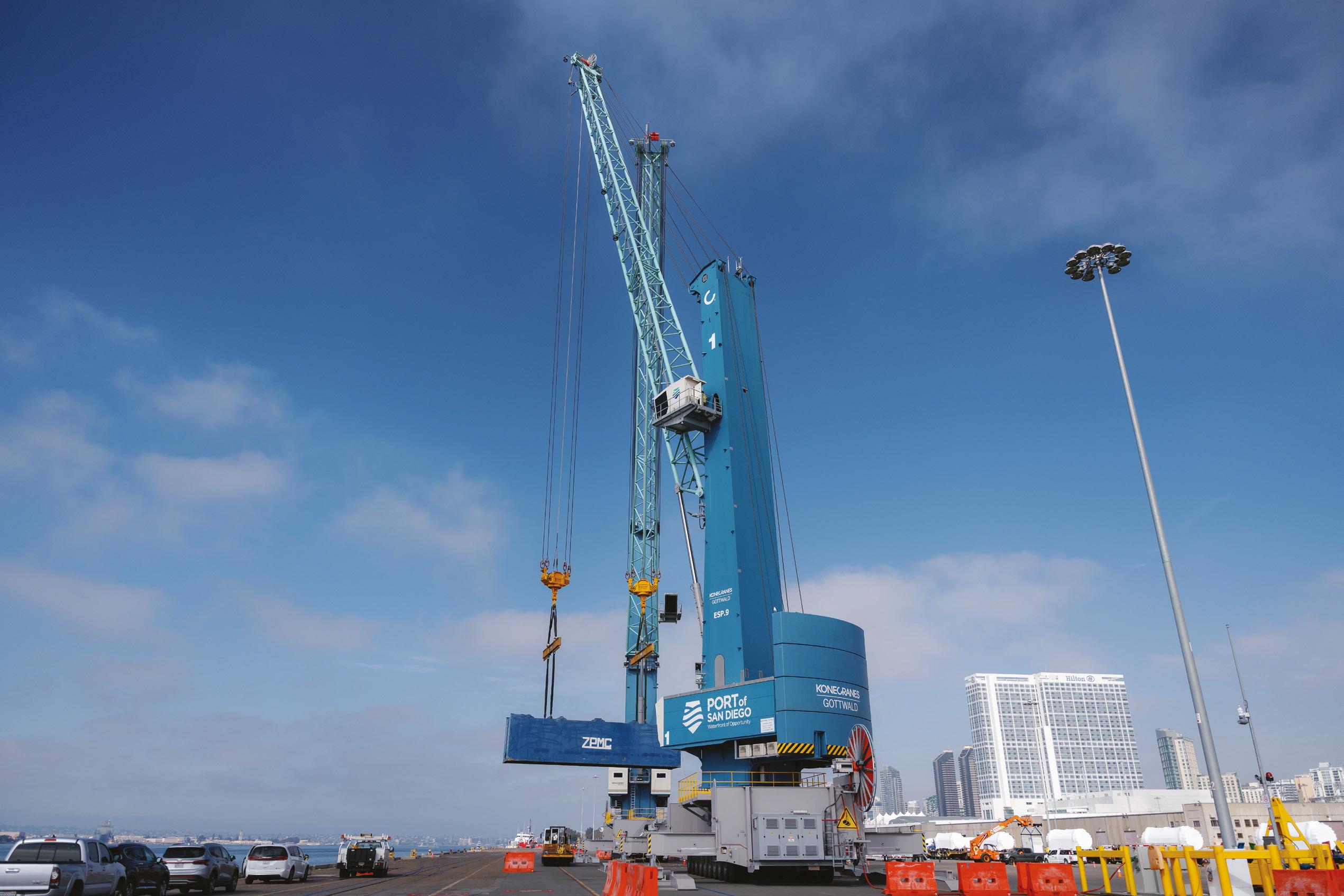

MARGARET A. KIDD: CHAMPION FOR BREAKBULK’S NEXTGEN

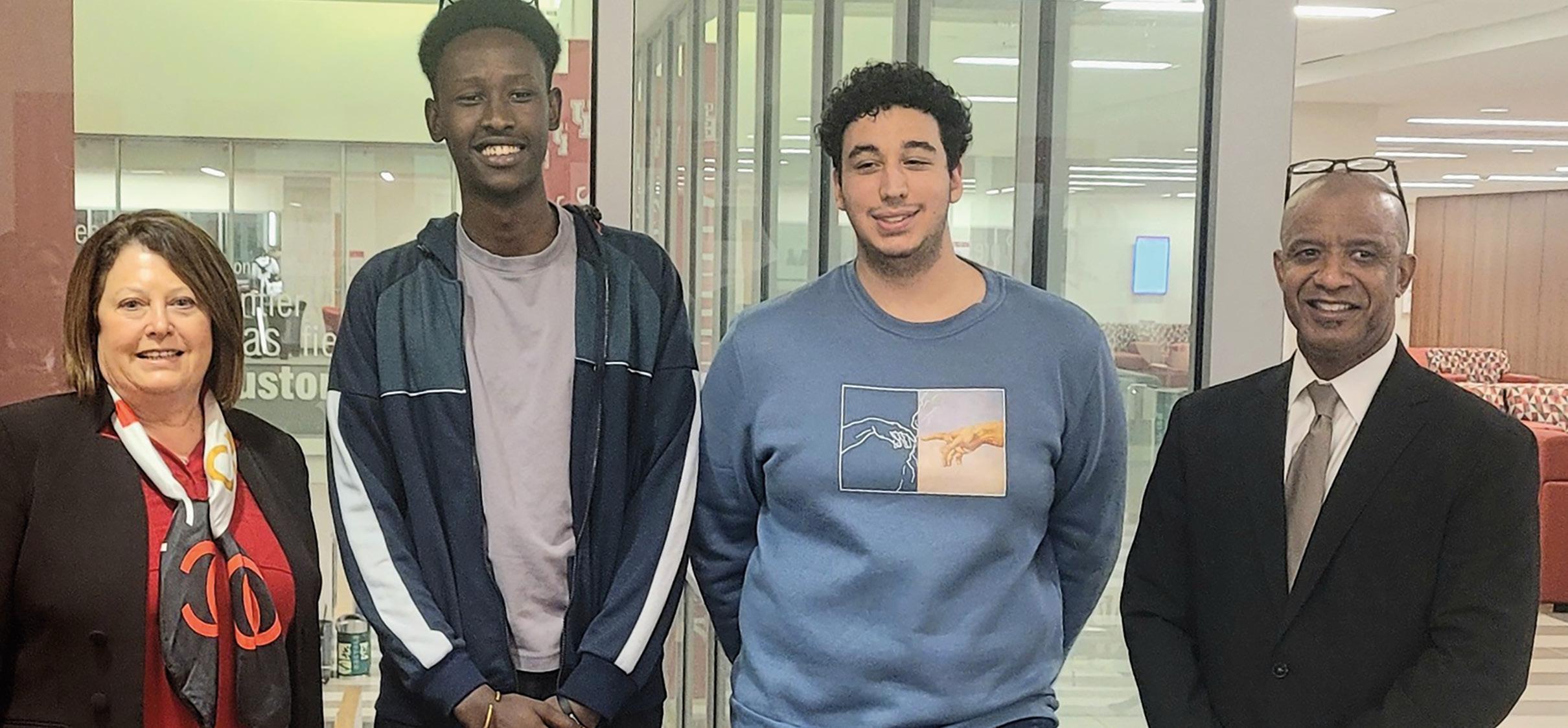
Houston Stalwart Forges Academia, Industry Bonds
Behind every industry are those who pioneer, innovate, lead and push.
Across the global supply chain sector, many of the individuals who become well known for effecting change are the captains of commercial and industrial enterprises. However, governments, think tanks, NGOs, public service organizations, and academia also play a critical role is producing supply chain thought leaders. Margaret A. Kidd is one.
Chain & Logistics Technology program as well as an instructional associate professor within the Technology Division of the Cullen College of Engineering. She has emerged on the global breakbulk and project cargo stage as a career pathing advocate extraordinaire, bringing together academia and industry to help develop the supply
By Lori Musser
including a CMILT (as a chartered member of the Chartered Institute of Logistics and Transport). She is passionate about creating learning opportunities for supply chain students, and an ardent ambassador of student research competitions.
Kidd’s trademark in academia is her hyper-connectivity with industry, which
70 Breakbulk Magazine Issue 2 2024 breakbulk.com
Americas
parlays into internships and co-ops and other partnerships, preparing students for the real world of logistics.
With her service-oriented persona, Kidd keeps a foot in numerous industrycommunity-university development organizations such as the Houston Maritime Centre Board of Trustees, Energy Industries Council, North & Central America Regional Advisory Board, University of Houston Community Relation Alliance, and Port Houston Partners in Maritime Education alliance. She doesn’t stop there.
The Face of Supply Chains
During the Covid era, Kidd became a de facto media darling, a well-spoken proponent of changes sorely needed during a time of global supply chain chaos. She was able to interpret the world’s transportation and logistics struggles for audiences in Texas, the U.S., and internationally, in a manner that made sense to the masses. She continues to help media outlets get to the heart of headlines ranging from Amazon earnings to the Red Sea situation to nearshoring.
“The lessons learned during Covid in terms of over dependence on manufacturing in one geography, a lack of diversification of suppliers, just-intime versus just-in-case inventories, the need for real-time visibility of cargo, the need for expanded standards for digitization and automation of processes, and an emerging new geopolitical world alignment” all impact supply chains, Kidd said to Breakbulk. “This will be reflected subtly through onshoring, nearshoring and friend shoring,” but not, Kidd added, a full-scale decoupling from Asia.
Kidd is called upon internationally to shed light on these types of current and pending supply chain issues. Whenever and wherever she speaks, she advocates for supply chain workforce development and to that end, she posits a need for structured pathways including formal management training programs, mentorships, and personal
development plans. “If you look at law, banking, oil and gas, there are structured pathways for career development,” said Kidd, noting that the tradition in the sphere of breakbulk and project cargo has been to learn on the job. While that may have worked in the past, the sheer size and weight and complexity of project shipments nowadays requires new skill sets. “I think industry has got to do it,” she said.

71 Breakbulk Magazine Issue 2 2024 breakbulk.com Americas
Kidd is passionate about linking industry and academia.
Credit: Margaret A. Kidd
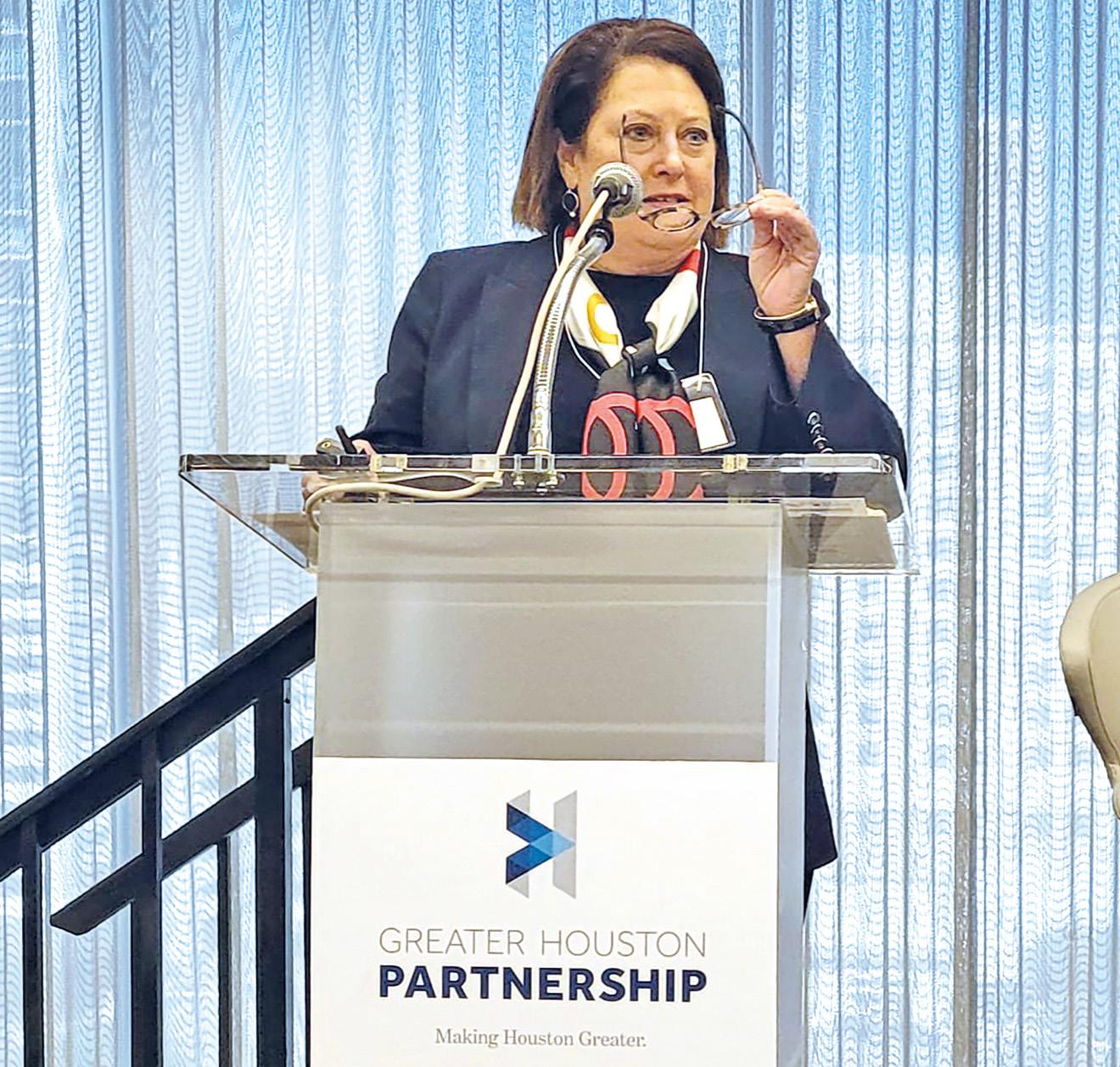
Structuring Career Pathways
Educational institutions can provide training and manage expectations and leverage diversity – by nurturing language skills, for example – but, some of the private enterprises that make up supply chains lag in providing more structured career development and need to take action.
“While academia theoretically levels the playing field by providing quality training regardless of gender, sexual orientation, culture group or socioeconomic status, through equitable access to university career centers and services that link to employers, we still see some industries that are behind the curve but working to play catch up. They will need to work purposely to define strategies that create equitable, inclusive and accessible opportunities for the next generation workforce. If not, they will miss the target of achieving the triple bottom line,” Kidd said. Corporate career pathing needs to embrace a diverse workforce. It also needs to focus on Environmental, Social, Governance, or ESG.
“ESG is a good example. There is pressure from shareholders for accountability. We have the opportunity to do the right thing,” Kidd said. Just as climate change, decarbonization and carbon tracking have gained traction in government, NGO and investor mindsets, Kidd anticipates they will play an oversized role in the transportation, shipping, and port sectors.
“In the U.S., the current Biden/ Harris Administration has made what is shaping up to be both a generational investment in infrastructure upgrades and the most significant climate legislation in U.S. history, offering funding, programs, and incentives to accelerate the transition to a clean energy economy through the Inflation Reduction Act of 2022,” Kidd said.
Her eye is currently on the pending Notice of Funding Opportunity from the Environmental Protection Agency for the Clean Ports Program which will be focused on grant funding opportunities for ports in non-attainment zones such as Los Angeles/Long Beach,
Houston, and New York/New Jersey along with inland ports in North Texas, Utah, Colorado, and Illinois.
“Energy transition is certainly driving the nature of current and future capital projects along with the viability of the breakbulk/project cargo market to service those projects,” Kidd said. Next up, she is looking to Saudi Arabia and its wholesale transformation through the MBS Vision 2030, rampant nearshoring opportunities in Mexico, and the expanding economies of India and Southeast Asia as prime opportunity zones for capital projects.
A Circuitous Path
Kidd’s rare talent of seeing the forest through the trees may stem in part from her atypical career path. She didn’t come up through the ranks of supply chains or via an academic track. She didn’t choose either. She likes to say her career chose her.
After a successful early career with Wall St. firms, Kidd felt she had hit a glass ceiling, regrouped, and found herself studying economic development, sustainability and the port-city interface. She quickly landed her first instructional position, at Texas Southern University, and two years later was recruited as a project director for a large U.S. Department of Labor grant related to supply chain credentialing at San Jacinto College. In 2016, she joined the SCLT program at University of Houston as an instructional assistant professor and in 2018 became the program director for the SCLT.
Kidd said that the very “Darwinian” environment she faced working on Wall St., where failure was not an option, “not only defined me but assisted in the journey to becoming a globally recognized supply chain thought leader.” Skills sets developed early in her career – including an entrenched Wall Street work ethic, industry connectivity, expansive networking, the ability to adjust and adapt, a sense of resiliency, communication skills, and the ability to lead and get the most challenging
72 Breakbulk Magazine Issue 2 2024 breakbulk.com
Americas
jobs done – have continued to be the hallmarks of Kidd’s initiatives ever since.
Those initiatives are diverse. “I pivot all day, from engaging in academic activities focused on student success to administrative tasks necessary to keep a large academic unit running to industry engagement and community and professional service,” Kidd said.
From an academic perspective, Kidd captures the attention and creativity of students coming and going, teaching both introductory classes in logistics and capstone practicums. Lighting a fire for students in supply chain studies is a passion. “I love the impact I have been able to make on the next generation. It is very meaningful to me,” Kidd said.
Building Opportunities
Kidd wears her UH colors proudly, as an educator, but just as importantly, she has woven her research and other academic interests around her Texas base. Known to many as the energy capital of the world, the Houston area is arguably in the midst of remaking itself into the energy transition capital of the world. “While my focus is workforce and economic development in the maritime logistics space, I continue to engage in opportunities around energy transition. Climate change is real, and it is critical that we all contribute to scalable solutions for the global commons,” Kidd said.
Some of Kidd’s recent efforts include work with the UH supply chain research team on circular plastics and leading a multidisciplinary team addressing workforce development and related educational programs for zero emission heavy-duty vehicles and cargo handling equipment, which is potentially part of a workforce development component of a large-scale EPA proposal related to energy transition.
On the energy transition project, Kidd is primary investigator for a multidisciplinary team from the University of Houston. “Notably, global level change management does not happen at a community

college, it respectfully occurs via executive education and research at Tier One research universities such as University of Houston.”
She is also working on an MOU with International University-Vietnam National University in Ho Chi Minh City, Vietnam. “Under this arrangement, students would complete two years in their home country and then come to the University of Houston to complete their degree in SCLT,” Kidd said.
Her interest in the Vietnam link stems partly from UH’s strong multi-cultural bent – it has one of America’s most diverse, multicultural student populations.
But Vietnam has also played an evergrowing role in global manufacturing as western countries decouple from China. And there is the Texas consumption base that has taken Vietnamese imports through the Port of Houston from 32,788 twenty-equivalent-units in 2018 to 114,684 twenty-equivalent-units in 2022.
To Kidd, the confluence of these developments spells out a need for workforce development in maritime logistics in Vietnam and the University of Houston is in a position to help.
In another project, Kidd champions global connections for student
research, engaging students in the capital projects/breakbulk sector with industry stakeholders leading up to and during Education Day at Breakbulk conferences in Dubai, Rotterdam, and Houston. “This provides a safe space for students and industry to get to know each other and network,” Kidd said. It allows industry the opportunity to identify early talent already exposed to the sector. “These young people are tackling best practices and identifying solutions for challenges to industry and students get tangible/applied chances to learn about industry while completing a project for their degree plan,” Kidd said.
Higher education trains minds and is a steppingstone for the workforce of the future. Universities continue to contribute to the development of effective global supply chains and have created a pipeline of new industry entrants. Individuals like Kidd who champion the university-industry interface, lasting partnerships, research, and continuing workforce development are helping the supply chain industry secure a progressive, stronger, and more resilient future.
Based in the U.S., Lori Musser is a veteran shipping industry writer.
73 Breakbulk Magazine Issue 2 2024 breakbulk.com Americas
Kidd takes time out from her busy schedule to enjoy hiking in Crete’s Samaria Gorge.
Credit: Margaret A. Kidd
SAUDI’S HORIZON OF PROJECT OPPORTUNITIES
Look Beyond NEOM for More Mega Developments
From the west coast, where mega developments like The Red Sea are taking shape, to the capital Riyadh, where sprawling cities like Qiddiya and Diriyah Gate are emerging, to massive industrial facilities and railway schemes, these are exciting times to be involved in Saudi Arabia’s project logistics market.
According to UAE-based intelligence provider BNC Network, there are 4,695 active construction projects in Saudi Arabia worth an estimated US$6.18 trillion. Real estate and infrastructure projects alone crossed US$1.25 trillion in value in 2023, property consultancy Knight Frank stated in its Saudi Giga Projects report.
The surge in construction projects has been driven by Saudi Arabia’s successful bids for hosting global events such as the World Expo 2030, FIFA World Cup 2034, Asian Winter Games 2029, and the Asian Cup in 2027 – all areas to watch for project cargo specialists.
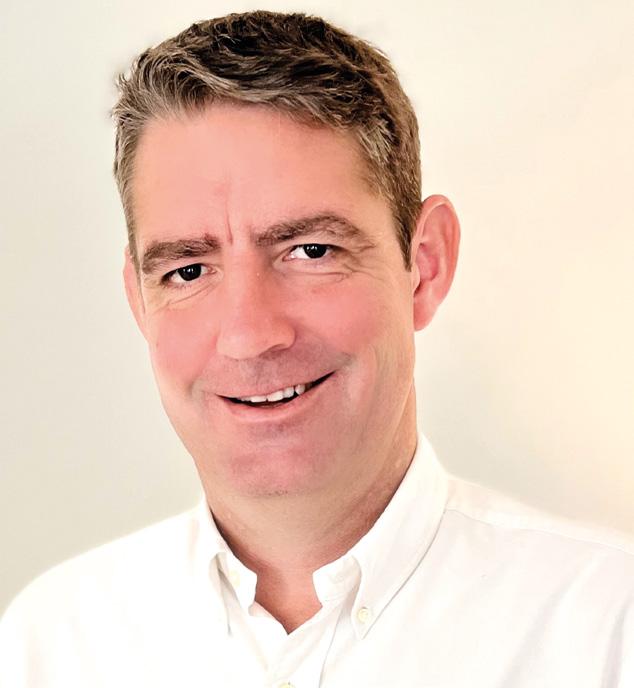
“The Public Investment Fundrelated project budget approvals stand at US$1.07 trillion. Looking at the wider projects market, we can establish that the pipeline for under-construction projects equates to approximately US$1.5 trillion,” David Clifton, director at Canadaheadquartered global engineering and project management consultancy AtkinsRéalis, told Breakbulk
Key giga projects make up the lion’s share of the portfolio, with NEOM, a high-tech and sustainable gigacity; The Red Sea, a luxury tourism development; Qiddiya, an entertainment and tourism destination; Diriyah Gate, a heritage tourism project; New Murabba, a new downtown area for Riyadh, and a cluster of other schemes placing huge pressure on the supply chain industry, he said.
AtkinsRéalis, which expanded to Saudi Arabia in early 2023, has conducted numerous supply chain reports and continues to provide market analysis and forward forecasts to support clients in project planning and delivery.
“We’ve seen contracting awards grow to above 2012 level - the highest in recent records - at over US$78 billion in 2023,” Clifton said. In terms of asset delivery, The Red Sea in the Western Province and Diriyah Gate in Riyadh are the programs delivering operational projects for revenue generation, he said.
“This is partially a misnomer, however, as schemes are of such
Summary:
By Heba Hashem
Saudi Arabia is undertaking many large construction projects as part of its Vision 2030 plan to diversify its economy away from oil with billions being invested in megaprojects throughout the western and central regions. This surge in construction is putting pressure on Saudi Arabia’s logistics industry to support the efficient and timely transportation and delivery of supplies and equipment.
varying scale, that we’re seeing a variety of different capital burn rates which indicate that all projects are moving, some with greater infrastructure requirements than others.”
Manufacturing Pace Picks Up
The industrial sector, too, saw significant developments last year, including the opening of the kingdom’s first car manufacturing facility by American electric vehicle maker Lucid Group, and the launch of the first-ever Saudi electric vehicle brand, Ceer.
With a vision to transform itself into a competitive hub for manufacturing and production, and as part of its efforts to diversify the economy, Saudi Arabia plans to increase the number of factories from over 11,000 today to 36,000 by 2035, including 4,000 which will be fully automated.
A rising star in this landscape is the industrial city of Ras Al Khair
Middle East
David Clifton
74 Breakbulk Magazine Issue 2 2024 breakbulk.com
Located on the country’s east coast, the economic zone represents the backbone of the domestic mining industry and will see the development of factories for iron, zinc, phosphate, aluminum, and metal smelting and forming. It is also planned to house a collection of low-carbon investments and a new export terminal.
In May 2023, oil giant Saudi Aramco contracted French engineering group Technip Energies to develop the master plan for Ras Al Khair. In the same month, China’s Baoshan Iron and Steel Co., one of the world’s largest steelmakers, announced plans to establish a US$4 billion steel plate manufacturing complex in the economic zone.
In early 2024, Saudi Arabian Mining Company, or Ma’aden, and U.S.-based industrial solar steam company GlassPoint unveiled plans to develop the first phase of the world’s largest industrial solar thermal project in Ras al Khair, with the goal of decarbonizing Ma’aden’s aluminum supply chain.
But this is just the beginning as Saudi Arabia plans to offer 814 industrial projects with a combined value of nearly US$262 billion to the private sector gradually until 2035, Bandar AlKhorayef, Saudi Minister of Industry and Mineral Resources, said in 2023.
Activity Centers
Looking at real estate and infrastructure giga developments, the Western Province is where most of the action is happening today, with a total of US$687 billion of projects expected to be completed by 2030. These include NEOM, The Red Sea, the King Abdullah Economic City, and AlUla, an ancient city being transformed into an international tourism destination.
“Saudi Arabia’s focus is primarily on the Western region, which accounts for about 60 percent of projects, while Riyadh accounts for about 30 percent,” Kris Brusselmans, CEO of Bahrainbased Kanoo Logistics, told Breakbulk
“The Integrated Logistics Bonded Zone, an economic zone in the north of Riyadh, will come with a lot of project cargo. There’s also some activity in the Eastern Province on the back of oil and gas projects, such as those in the industrial city of Ras Al Khair,” said Brusselmans, who was previously COO at Saudi Arabia-based Almajdouie Logistics and has lived in the Middle East for the last 18 years.
The US$500 billion NEOM, one of the world’s most active construction projects, has awarded more than US$237 billion of contracts since its launch in 2017, according
to the Knight Frank report. While most turn-key projects have gone to international logistics players, local firms have a crucial role to play.
“The big players don’t do the actual work on the ground. Their contracts are usually based on 4PL, or fourth-party logistics, which means they manage the entire supply chain, but they don’t do work on the ground,” Brusselmans explained.
“In the end, because of the Saudization policy, companies will have to go preferably with local players, like us. This is also because they don’t own their own trucks, and they don’t want to either,” he said.
Part of the family-owned business conglomerate Yusuf Bin Ahmed Kanoo Group, Kanoo Logistics operates across Saudi Arabia, where it has a network of warehouses and yards, including a large logistics facility near the King Abdul Aziz Port in Dammam.
Through its events logistics department, the company supports major events such as the Saudi Arabian Grand Prix in Jeddah, and others launched by the General Entertainment Authority, such as Riyadh Season. It is also providing logistical support for projects in AlUla, as well as for the expansion of ports and airports and establishment of industrial zones and logistics parks.

75 Breakbulk Magazine Issue 2 2024 breakbulk.com Middle East
Kanoo Logistics delivers 800 tonnes of cargo to Italian oilfield services provider Saipem in Saudi Arabia. Credit: Kanoo Logistics

Saudi Arabia plans to establish 59 logistics zones by 2030, of which 22 have materialized, according to Brusselmans. “Many of these zones include project cargo and out-ofgauge commodities—so heavy cargo to set them up—and our company is also involved. This is primarily in the Western Province and also in Riyadh.
“These industrial zones are going to be clusters for certain industries, such as pharma and telecom. They are all projects that from a construction point of view, as well as from running them later on, will demand project cargo logistics providers. So ultimately, these will provide opportunities to some local players who have the financial capabilities and assets, such as trucks, warehouses, and terminals.”
Meanwhile, Saudi Ports Authority continues to heavily invest in the maritime transport and logistics sector, with several large-scale projects to upgrade existing ports and terminals as well as to develop new ports underway or in the pipeline.
“Saudi Arabia’s ports want to have better and more automated facilities and logistics parks to be able to handle more exports and imports, and to become one of the top 10 twenty-equivalent-unit size ports. All of these are mega projects where both international and local players are participating,” Brusselmans said.
“The ports are already growing, and this will create a lot of rail
connections and intermodal models. Because the vision on the back of the green ambitions is to move goods increasingly by road,” he said.
Saudi Arabia plans to more than triple the size of its rail network with 8,000 kilometers of new track, investment minister Khalid al-Falih said in 2022. The government also approved in October 2023 the construction of a significant railway connection that will stretch from Riyadh to Kuwait.
Mounting Pressure
While most projects are ramping up, it is important to acknowledge that not all schemes may realistically be delivered, and that some could be delayed, slowed or re-prioritized for the Vision 2030 objectives, especially when considering the major events recently secured for delivery in the country, Clifton said.
“The major logistical considerations are the locations of the mega projects being developed in the kingdom. Over 65 percent of the forecast spend on schemes is located outside of city limits, and in most instances may be hours’ travel from key logistics hubs or points of distribution,” he said.
As a result, logistics in Saudi Arabia is one of the top three risks that need to be addressed and, in many instances, this realization has only recently been grappled with.
“With over 4,000 projects spread at pre- and post-contract delivery and
with contracting awards increasing at a compound annual growth rate of about 60 percent, the situation is likely to compress the logistics industry’s ability to effectively service the demand side,” Clifton said.
Local logistics companies have been strengthening their capabilities to handle the anticipated project cargo needs. For example, Almajdouie Logistics invested in 30 Hyundai heavy-duty vehicles in 2023 to support its efforts to implement large-scale projects. Similarly, heavy haulage company Rezayat Sparrow Arabian Crane Hire Co. invested in 16 new cranes in 2022 to support the performance of its fleet.
Clifton believes that Saudi Arabia’s drop-deadline projects are going to need very sophisticated and detailed logistical input to achieve the milestones that the government has signed up to. However, with the kingdom’s supply chain being some 70 percent the size of pre-pandemic, there is significant pressure on being able to ramp up to meet these requirements, he said.
In all cases, Saudi Arabia’s project landscape is so futuristic and thought through that it is likely to leave a lasting mark and serve as an example for the next 30 or 40 years, suggested Brusselmans.
“If you’re part of that success, it will be something very tangible for your business. Some of the projects are unmatched in the world in their size and timeframe. So, I believe both for the logistics providers and companies involved, it’s an opportunity to be part of this success and use it as a future reference for projects anywhere in the world.”
Heba Hashem is an Arabic- and Englishspeaking freelance journalist based between Dubai, UAE and Niagara Falls, Canada.
Breakbulk Europe Exhibitor
Visit: www.europe.breakbulk.com/home
Breakbulk Middle East Exhibitor
Visit: www. middleeast.breakbulk.com/home
BGSN member
76 Breakbulk Magazine Issue 2 2024 breakbulk.com
East
Middle
The establishment of industrial zones such as Ras Al Khair (pictured) will provide opportunities for smaller logistics players. Credit: Saudi Press Agency
Register now for the region’s largest trade event for the project cargo and breakbulk industry
15-17 October 2024 | George R. Brown Convention Center
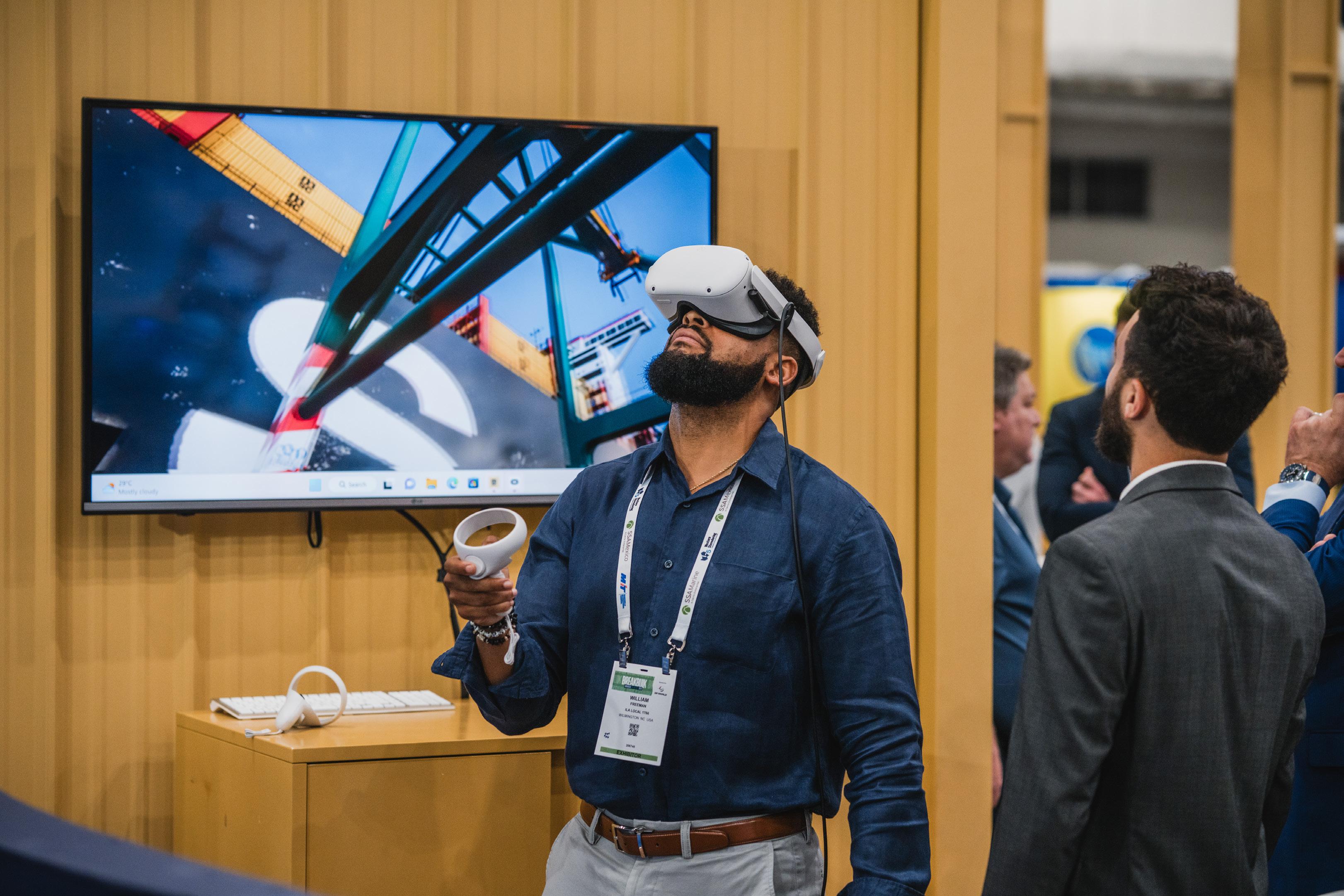
americas.breakbulk.com
MINING FOR GLORY IN
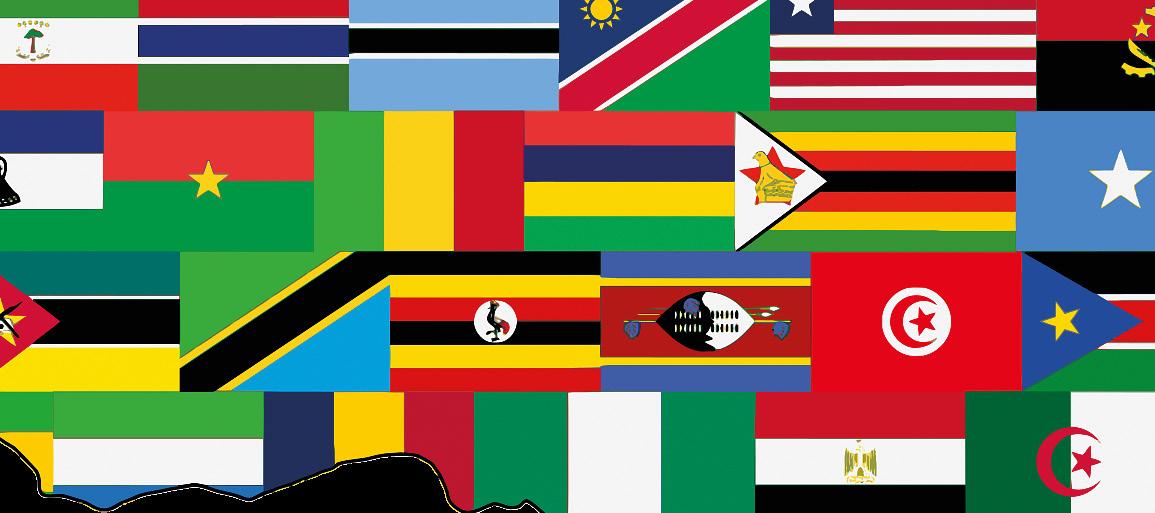
Continent on Brink of Minerals, Metals Explosion
The resource wealth of Africa has been acknowledged for many years. There have been many decades of paper trading of mining licences without actual work, exploration prolonged by socio-political aspects for each of the countries and a gradual learning curve of administrations that led to potential not being fully realised. Africa, though we talk of it collectively, is the combination of 56 countries, each with their own potential and kinetic forces.
It is safe to say now that Africa is finally on the brink of ‘the great unleashing.’ There are several new projects in mining of various bulk, essential and critical minerals and precious metals that are coming up. The diversification of China with iron ore reliance has led to at least a dozen iron ore projects mainly in West Africa. The disciplined ramping up of bauxite volumes from Africa has led to many new junior mines entering the fray in West Africa. The dignified exit of major players from coal in several geographies led to new players entering and flourishing with coal from south and east Africa. The essential and critical minerals listing by several governments, especially the U.S. and China as they race towards EV supremacy, has led to a rush for mining
projects that involve lithium, graphite and cobalt all over the continent.
Breakbulk shipping can expect to benefit from this growth in mining with new imports of equipment for mining, transport and infrastructure into Africa. The major impact on breakbulk shipping will, however, not just be with equipment for new and reviving mining projects of Africa. There are many more African countries that have aligned in recent times to processing raw ore before exports. The investments into infrastructure that are required for these initiatives will mean a lot more imports than previously expected.
The processing of many smaller ores will not need much effort. Namibia and Zimbabwe already have rules on processing critical minerals like lithium which will need some effort, but not a huge amount of machinery for the volumes that are available. But for iron ore or bauxite volumes the processing will take a lot more effort. The processing will also need to be powered and there is a great deal of industrial electricity shortfall in almost all of Africa, either in terms of production or distribution.
Unless the actual ore processing is diminished by beneficiation with lesser regulations around exports, this
By Capt Pappu Sastry
growth in mining is expected to bring about a huge import market for general cargo, breakbulk and containers before the processed ore is eventually exported. There will be a need for more generators, new or refurbished power plants, refineries, smelters, and thus a push for movement of steel structures, fabricated parts, large machinery, and all associated transformational parts.
But while the potential is there, the fundamentals surrounding African infrastructure related to mining will need change. There is no great rush from financial institutions to fund infrastructure development in Africa and there is a lack of knowledge on infrastructure requirement for processing mined ores. There is also insufficient know-how from mining companies on how to set up infrastructure. Additionally, the stability of most elected governments in Africa is unclear and even military regimes seem to have a high centre of gravity. The narrative that Africa and challenges are synonymous is not accurate for the people who know Africa. Africa is synonymous with opportunity; and every opportunity carries its share of challenges.
Capt. Pappu Sastry is CEO of Adhira Shipping and Logistics.
Thought Leader
78 Breakbulk Magazine Issue 2 2024 breakbulk.com
IRAQ’S MEGA-PROJECT SPARKS INFRASTRUCTURE BOOM
Country’s US$17 Billion Road and Rail Plan to Create Opportunities
By Heba Hashem
Iraq is experiencing its most stable period in the past two decades and amidst this change, a renewed sense of confidence and optimism has sparked bold projects.
With a vision to transform itself into a regional transit hub, the country has embarked on a significant project that will connect the Grand Faw Port in Southern Iraq to the border with Turkey, and then to European transit networks. Such a route would not only link the Middle East to Europe via Turkey, but also connect Turkey to the Middle East Gulf states.
The US$17 billion project, dubbed Development Road, involves the
construction of a 1,200-kilometer two-way high-speed rail network capable of transporting goods and passengers at 300 kilometers per hour. Announced in May 2023, the plan also entails the construction of 15 train stations along the route, as well as highways and tunnels.
The project is of such strategic importance that it is directly supervised by Iraq’s Prime Minister Muhammad Al-Sudani and the Minister of Transport Razzaq Al-Saadawi.
“The Development Road will be beneficial for Iraqi people because it will be used for everything, helping the economy to grow. Iraq imports 99 percent of its goods. It exports its oil and gas, but it imports the
Summary:
Iraq’s ambitious US$17 billion Development Road project will connect the southern Grand Faw Port to the Turkish border via a 1,200 km high-speed rail network and supporting infrastructure. The scheme will help transform Iraq into a regional logistics hub by providing an alternative trade route between Asia and Europe. With some projects at an early stage and others reaching construction there is plenty of scope for project work.

majority of its goods,” Captain Cem Ercan, CEO at Turkey-based CETA Logistics & Projects, told Breakbulk.
He said the proposed project is inspired by the Silk Road, the ancient trade route that linked Baghdad with western and eastern regions such as Syria, Europe, China and Japan. Credit: CETA Logistics
Middle East

Passing through 12 governorates, the new route is expected to pave the way for the development of vast areas of the country. For instance, new industrial zones are envisaged along the route, and a cargo airport will be built to maximize the project’s impact.
The mega project will primarily involve Turkey and Iraq, with Turkey hosting nearly a tenth of the infrastructure, Turkey’s foreign minister Hakan Fidan recently said. Ultimately, it is expected to reduce travel time between Asia and Europe when completed by 2029.
Project Outlook
Operating from the city of Mersin, home to Turkey’s largest port, CETA Logistics & Projects has been active in Iraq for over 15 years and has a subsidiary in Erbil, the capital of Iraqi Kurdistan. About 80 percent of the company’s cargo is transit based, destined to Iraq and CIS countries.
“We’re already doing shipments on behalf of Iraq’s Hemn Group, a big contractor for bridges and roads in the northern region. It uses its own resources, such as bitumen, for the roads, but it imports the steel and other material. For the road and rail project, Iraq will likely source about 40 percent of the raw material domestically and import 60 percent,” Ercan said.
“This will benefit all sectors in Turkey, including logistics, supply
chain, machinery, and factories. We’re still waiting for the project to start. I heard about it five or six times when I was in Iraq recently.”
Meanwhile, Mhmmod Tayeb, general manager of Basra-based freight forwarder Naseem Umm Qasr LLC, expects the initial phase of the Development Road to focus on the construction of the main roads and bridges and on bringing supplies to Iraq. He said that typically, logistics services are needed when 60 percent of a project is completed.
“The Development Road project could be successful as it would offer an alternative to the Suez Canal and other options for transit transportation. Iraq is already linked to Turkey, Jordan and the Gulf region, but many of these routes are not active,” Tayeb told Breakbulk
Furthermore, the recent blockade of the Red Sea is accelerating Iraq’s ambition to become a regional transportation hub. “There are discussions for a new transit line through Saudi Arabia’s Arar land port to Iraq as a result of the Red Sea blockade. For the same reason, there are talks for the establishment of a transit through the Umm Qasr port, heading overland to Northern Iraq, and then to Turkey through Ibrahim Khalil, the crossing point between Turkey and Iraq,” Tayeb said.
Construction Upswing
A focal point in the Development Road is the Grand Faw Port, one of the world’s largest container terminals, set to undergo expansion to accommodate the increased cargo volume associated with the mega-transport project.
South Korea’s Daewoo Engineering & Construction is carrying out the first phase of the port’s construction under a US$2.6 billion contract awarded by the transport ministry in 2020. The port is expected to receive its first freighter in 2025 and operate at full capacity in 2038, a report by the Turkey-based Center for Middle Eastern Studies stated.
With 99 berths, the long-planned Grand Faw Port will be West Asia’s largest, and since it is deeper than the Suez Canal, it will be able to accommodate larger cargo ships. When operational, it will offer an alternative to traditional transit routes, while enabling Iraq to link to China’s Belt and Road Initiative. Notably, the port will reduce China-Europe transportation time by 20-25 days.
According to Iraqi port authorities, construction on the port’s infrastructure and the five main berths is 80 percent complete. Similarly, construction on the Silk Tunnel, the Middle East’s largest underwater tunnel, has reached advanced stages. The tunnel is being built under the Khor Al Zubair Channel and forms part of a new highway that will link the Grand Faw Port to Umm Qasr Port and the existing transport network. The final part of the plan is the 1,200-kilometer-long road and railway network, which will connect the Grand Faw Port with Turkey. According to Iraq’s Ministry of Transport, four governorates are nearing completion of the surveys for the rail and road placements and alignments.
Soil investigation has also been completed for 1,000 kilometers, while initial designs have been carried out for 600 kilometers of the railway and 300 kilometers of the highway.
Logistics Challenges
While the Development Road is making rapid progress, several issues need to be ironed out to enable its success, according to Ercan.
“The south side is managed by the armed forces, while the north side is managed by the Kurdish people. If you’re delivering goods to the south side of Iraq, you have to change the trailer and the prime mover. You cannot go with a Turkish registration plate to the south side; it’s compulsory to use an Arabic plate,” Ercan said.
The requirement poses a challenge for companies transporting cargo from one region to the other. “Iraq needs
80 Breakbulk Magazine Issue 2 2024 breakbulk.com
East
Middle
Captain Cem Ercan
Credit: CETA Logistics
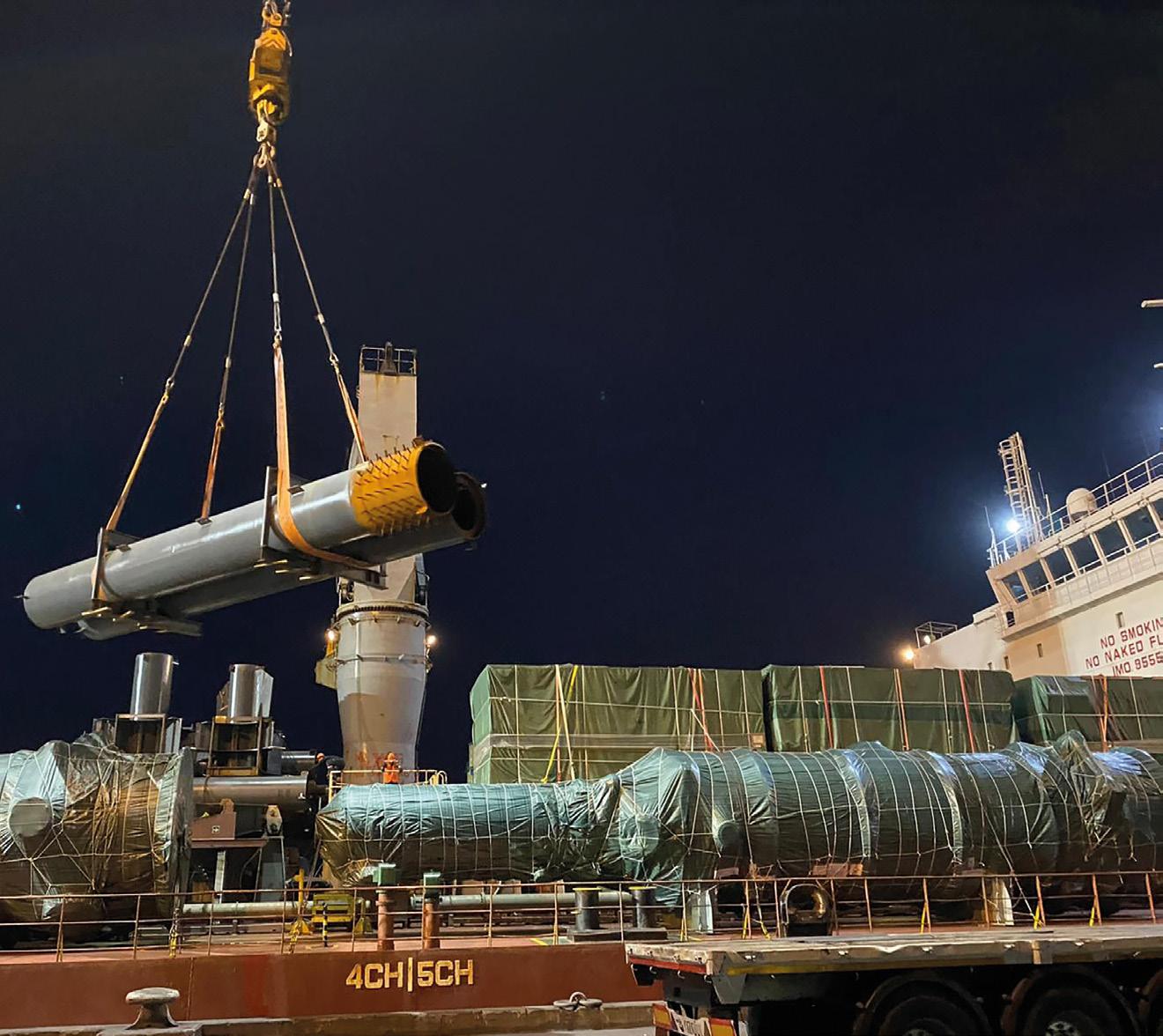
to clear these obstacles if it wants to fully benefit from the Development Road project. They also need to improve the customs points. If you’re going to the south side, you often have to pay under-the-table money to the checkpoints, each time about US$1,000 or US$750. They need to tackle this problem as well,” Ercan said.
Another challenge freight forwarders face in Iraq stems from the automatic expiry of Customs duty exemption certificates, according to Tayeb. “Large projects, such as New Bismayah City, are exempt from Customs duties and taxes under the contracts. This exemption certificate automatically expires after one year,” he explained.
“We always tell the government that this document should remain active as long as the project is running. It makes no sense for the cargo to arrive and then you discover the exemption certificate has expired. Renewing it takes about a month, and during this time, we pay storage fees and fines, which is ultimately incurred by the foreign investor.”
Wave of New Projects
Despite these challenges, the Development Road project is making steady progress and has sparked a wave of new residential cities along its route. These have been the focus of local freight and logistics companies.
“As freight forwarders, we’re more focused today on investment and residential projects such as the US$10.1 billion New Bismayah City southeast of Baghdad. Hanwha Engineering & Construction is building the city, which will house more than 600,000 people. Residential cities require large shipments of goods, and all the material is exempt from custom duties,” Tayeb said.
“We’re especially excited about the projects awarded by the National Investment Commission, not only residential but also industrial projects and the raw materials they require. This type of logistics work never ends; as soon as an order is finished, another is placed,” he said.
Naseem Umm Qasr has been working with companies such as South
Korea’s Hyundai Engineering and Construction and Japan’s engineering firm JGC, supporting their logistics requirements for refinery construction and upgrading projects in Iraq.
CETA Logistics is also benefitting from the infrastructure boom. The company is supporting an expanding oil and gas project in Sulaymaniyah, and a 6,000-ton-perday cement plant that PowerChina is building for a dam project. Both are in the Iraqi Kurdistan Region.
Additionally, the Turkish logistics specialist is gearing up to transport components for a new solar power plant near Baghdad. The first phase will have a capacity of 250 megawatts, or MW, and the second will have 500 MW.
“We will use the Umm Qasr Port in Basra for this project, and we expect to start by mid-February. The first phase will take about eight months, and once that’s completed, we will start on the second batch. It will all be breakbulk and project cargo.”
While the Iraqi market is not mature yet, companies that have had the courage to do business there have learned how to navigate it, Tayeb said. “Take Hyundai, for example. The company came to Iraq and took on dozens of projects, including the Karbala oil refinery. In the process, it developed a local base, learned about the port procedures, and some of its employees even speak Arabic.”
For Ercan, the fact that Iraq is heavily dependent on imports means there’s constant demand for logistics and freight services. “Iraq imports most of their goods, so it’s always a lucrative market and you can make decent profits if you deliver good work.”
Heba Hashem is an Arabic- and Englishspeaking freelance journalist based between Dubai, UAE and Niagara Falls, Canada.
*Breakbulk Europe and Middle East Exhibitor Visit: www.europe.breakbulk.com/home www.middleeast.breakbulk.com/home
81 Breakbulk Magazine Issue 2 2024 breakbulk.com Middle East
CETA Logistics supports a cement plant project in Erbil, Iraq.

AFRICA’S OIL AND GAS SECTOR SURGES
Africa’s demand for electricity, coupled with its steadfast commitment to enhancing economic growth, continues to propel the oil and gas sector forward at an accelerating pace.
According to Ian Thom, upstream research director at Wood Mackenzie, the African upstream oil and gas sector is in the middle of an US$800 billion capital expenditure program that will see liquefied natural gas, or LNG, emerge as a significant investment theme alongside traditional deepwater oil.
US$800 Billion Investment Drive Accelerates Amid Rising Demand
By Liesl Venter
Speaking to Breakbulk, Thom said there was no slowing down in the continent’s oil and gas demand. “Depending on your view for demand, the ongoing need for investment is estimated to be US$500 billion per year for the next few years, if not decades.”
This steadfast momentum in the sector promises growth and a flourishing trajectory that will reverberate across the continent’s project landscape for years.
Thom said the current 20-year investment cycle started in 2010 and would culminate at the end of the
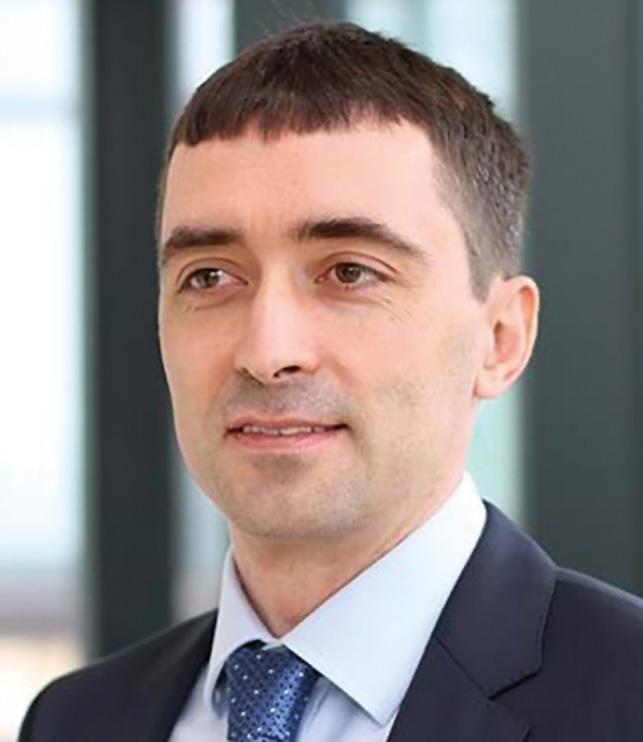
82 Breakbulk Magazine Issue 2 2024 breakbulk.com
Middle East & Africa
Ian Thom
Credit: Patrick King for GAC
Summary:
Significant investments totaling US$800 billion are being made in major oil & gas projects across the African continent. While projects face issues like infrastructure barriers, high costs, delays and global energy transition pressures, the continent has considerable untapped resources and the sector is poised for further expansion led by LNG and FLNG developments. Key players emphasize the need for private investments, ease of operations, adaptable logistics solutions and downstream developments to sustain the momentum.
decade with world-scale LNG projects in Mozambique and floating LNG (FLNG) across at least five countries. Africa is already a leader in FLNG, with over 50 percent of global capacity.
“The potential for the emergence of more projects is exceptionally high,” Thom said, indicating while Africa was nowhere in the league of the U.S. or the Middle East or even close to the deepwater resources off the coast of Brazil, the continent still had a phenomenal resource base with established industries in the west, east, north and south.
“Africa already possesses a solid foundation ripe for further development and expansion, particularly evident in the established industries of West Africa, which have demonstrated the continent’s oil prowess. The increasing emergence and success of FLNG projects further amplify the overall optimism surrounding Africa’s oil and gas sector. With appropriate technologies and the requisite investments, projects are poised to advance by at least a decade compared to their feasibility in previous times.”
Unlocking Potential
John Pittalis, head of marketing and communications at AAL Shipping, shares the optimism around the African oil and gas sector. “Africa is an exciting
market,” he said, indicating that the shipping line was actively looking for opportunities on the continent.
The Panama Canal Authority’s implementation of an extreme passage reduction measure due to a prolonged dry season had already led to AAL re-routing sailings from Asia, the Middle East, and Europe into the Americas and back via the Cape of Good Hope, South Africa.
“While this does mean an inevitable cost implication, it also allows us to call on African ports on both the West and East coasts regularly for backhaul cargoes into Europe, the Middle East, and Asia,” Pittalis said. These cargoes are typically primarily dry bulk, like iron ore, bauxite, and other commodities like rubber.
However, there is a growing potential for an increase in oil and gas-related cargo, especially as more countries across the continent intensify their efforts in this sector.
Gopalakrishnan Srinivasan, general manager for special projects – energy at GAC Group, said there had been a definite uptick in African oil and gas projects. “It is a rapidly developing region with many huge energy projects in comparatively unexplored markets gaining traction and causing flurries of activity. Service providers are clamoring to secure a local presence where they might not have one currently, much the same as they did

in Guyana,” he told Breakbulk. “Project cargo volumes will certainly increase markedly. However, in these early stages of development, we are yet to see significant volume increases.”
The overall outlook, he said, is very positive. “Post Covid, no cold or warm stacked rigs exist. They are all operational. Oil prices continually increase and buoy the sector, leading to increasing drilling opportunities. However, there are not enough rigs to enable the drilling companies to make them available. Consequently, the price of rigs is going up. It is a chain reaction with a knock-on effect causing reverberations throughout the sector.”
Srinivasan said GAC was seeing more refurbishment and reactivation of rigs due to the increasing drilling opportunities and the abovementioned shortages
But, in the harsh African landscape, there was a growing emphasis on cost efficiency. “More than ever, customers are looking to drive down costs,” he said. “This imperative, along with the need to maintain operational excellence, has created a highly competitive environment where service providers continually strive to offer cost-effective solutions without compromising safety or quality standards.”
Navigating Complex Terrains
Operating in Africa’s project sector, irrespective of the industry involved, presents formidable challenges. Logistics service providers must constantly adapt and innovate, as errors can be prohibitively expensive— the vast expanses of remote terrain and deficient infrastructure demand unconventional solutions, often necessitating trial and error.
“The oil and gas sector in Africa faces significant challenges due to inadequate infrastructure, lack of investment and global pressures to abandon hydrocarbons,” said
83 Breakbulk Magazine Issue 2 2024 breakbulk.com
Middle East & Africa
Gopalakrishnan Srinivasan

NJ Ayuk, executive chairman of the African Energy Chamber, or AEC. “A reliance on foreign personnel for projects often leads to high costs while delays in getting projects from discovery to development impact revenues. Additionally, global energy transition policies impact oil and gas investments worldwide.”
According to Ayuk, African governments have made strides in improving regulations, making for easier operation on the continent, often cited as one of the biggest hurdles. “There is a need for limited government intervention and a greater emphasis on fostering free markets to attract direct investments and encourage increased private sector participation.”
AEC figures note that Africa is home to around 125.3 billion barrels of crude oil and 620 trillion cubic feet of gas. “Oil and gas – and the projects they bring – will remain an integral part of Africa’s future for years to come,” Ayuk said. “It is one of the final
frontiers for oil and gas exploration, and we can see that in the number of projects on the continent.”
In Every Corner
That is evident in every region on the continent. The massive gas finds and ongoing projects in Mozambique have been extensively documented, with two significant LNG projects steadily developing. Additionally, the BP Tortue Ahmeyim project on the maritime border between Mauritania and Senegal has garnered considerable media coverage. Notably, Tanzania, Uganda, and Morocco are also advancing projects in the sector. Moreover, countries like Namibia, Angola, and Nigeria actively pursue various oil and gas initiatives, further contributing to the region’s energy landscape.
According to Ayuk, Namibia is a fascinating frontier, having made six hydrocarbon discoveries in just two years. Zimbabwe’s potential onshore gas market also represents an exciting play, while upstream investments
in Angola, Libya and Uganda are poised to unlock significant finds. Downstream projects include the East African Crude Oil Pipeline, the Dangote Refinery in Nigeria, the Central African Pipeline System, and Equatorial Guinea’s Gas Mega Hub.
“LNG seems to have found its niche in Africa,” Wood Mackenzie’s Thom said. “In Mozambique, expansion plans for the FLNG projects already exist, and several operators are looking at developments in Nigeria. The Tortue projects recently saw the first vessels arrive on site. These indicate the oil and gas project sector continuing its upward trajectory.”
Thom highlighted that the necessary upfront investments are one of the most significant hurdles in the oil and gas sector. These projects often entail lengthy lead times spanning several years, demanding partners with substantial financial resources for investment. “Only a select few companies with deep pockets possess the capability to undertake such
84 Breakbulk Magazine Issue 2 2024 breakbulk.com
Middle East & Africa
Upfront investments are one of the most significant hurdles in Africa’s oil and gas sector.
Credit: Patrick King for GAC
ventures. Consequently, we expect to see the less financially viable projects postponed or put on hold for now.”
External Pressures
According to Srinivasan, offshore projects face global inflationary and supply chain pressures, which raise uncertainties in long-term commercial and investment decisions. “Further, their financial viability is coming under scrutiny amid rising energy prices and costs of raw materials used in the construction and servicing of offshore installations. The upturn brings significant supply chain challenges for our customers.
“Without the necessary infrastructure and expertise, there is a risk that transportation bottlenecks could develop, and compliance with increasingly strict regulations can add further obstacles. Further, every project brings with it a requirement for accessible, secure warehousing, yard storage, associated facilities and equipment.”
Tackling these supply chain challenges will be critical for success, Ayuk said, emphasizing that significant
“OIL
infrastructure investment will be required across the continent. “Infrastructure is the foundation for a successful oil and gas industry. Initiatives to bolster infrastructure will be required, including investments by the government alongside the private sector, regional collaborations, the upgrading and construction of pipelines, terminals, and crossborder infrastructure, local content development and technology adoption.”
Carl Webb from Project Logistics Management highlighted the importance of engaging breakbulk and project cargo specialists right from a project’s inception. Landside operations, he noted, are contingent upon factors such as site location and proximity to ports. However, accessibility, especially for oversized or heavy cargoes, can be challenging in Africa. Therefore, consulting with project cargo experts is advisable and essential for navigating these complexities effectively.
But, according to Ayuk, while challenges will always prevail, the flow of capital remains steady, mainly as more African governments aim to increase production and global
demand grows. “International majors such as Eni, totalEnergies, BP and ExxonMobil are directing investments in exploration initiatives across the continent. Simultaneously, governments are doing their part to attract new investors,” he said.
Africa’s substantial investments in seismic data acquisition reflect a commitment to comprehensively understanding its untapped resource potential, he said. “Proactive regulatory enhancements, exemplified by initiatives such as Nigeria’s Petroleum Industry Act and Ghana’s Gas Master Plan, aim to create favorable investor conditions.”
For the project sector, this is excellent news. It’s crucial, however, for companies aiming to seize opportunities to stay informed about developments and maintain a regional presence as it is an environment that requires local knowledge and expertise for success.
Liesl Venter is a transportation journalist based in South Africa.

85 Breakbulk Magazine Issue 2 2024 breakbulk.com Middle East & Africa
AND
- AND
THEY BRING -
PART OF AFRICA’S
TO COME” NJ AYUK, AEC
African project brings with it a requirement for accessible, secure warehousing, yard storage, associated facilities and equipment. Credit: Patrick King for GAC
Event partner / Breakbulk Europe Exhibitor Visit: www.europe.breakbulk.com/home
GAS
THE PROJECTS
WILL REMAIN AN INTEGRAL
FUTURE FOR YEARS
Every
*Global

A recap of the stories that broke at Breakbulk Middle East
CARRIERS, SHIPPERS, FORWARDERS NEED TO BE UNITED
“If the breakbulk industry is serious about decarbonization, multipurpose carriers need to invest, and customers need to support and contribute to green moves.
Speaking at Breakbulk Middle East in Dubai, Carsten Wendt, head of sales for high and heavy and breakbulk at Wallenius Wilhelmsen, said that while everybody wants green breakbulk shipping, nobody wants to pay for it.
“We have to agree that if we are serious about this it will cost money,” he said. “There is a change of mindset needed to get there.”
He also cautioned against falling into the trap of greenwashing and stressed the importance of taking a step-by-step approach to decarbonization. “Decarbonization is not a topic that goes away tomorrow.”
Wendt said that companies that are investing now will have the competitive advantage going forward, while others that have their “head in the sand” need to wake up to the reality. “As soon as you start investing in this, the better.”
Panelist Vilasini Krishnan, vice president of 4D Supply Chain Consulting, added that decarbonization in the industry is an “opportunity for all of us to come together and to work towards this goal.” Synergies will reduce the overall cost at the end of the day, she added.
Moderator Stian Omli, senior vice president of shipping at Esgian, noted that the whole concept of decarbonization had changed over the past 10 years. “The issue has moved from the engine room into the board room,” he said.
Denis Bandura, managing director of BBC Chartering UAE, added that it is a change for everyone.
By Carly Fields
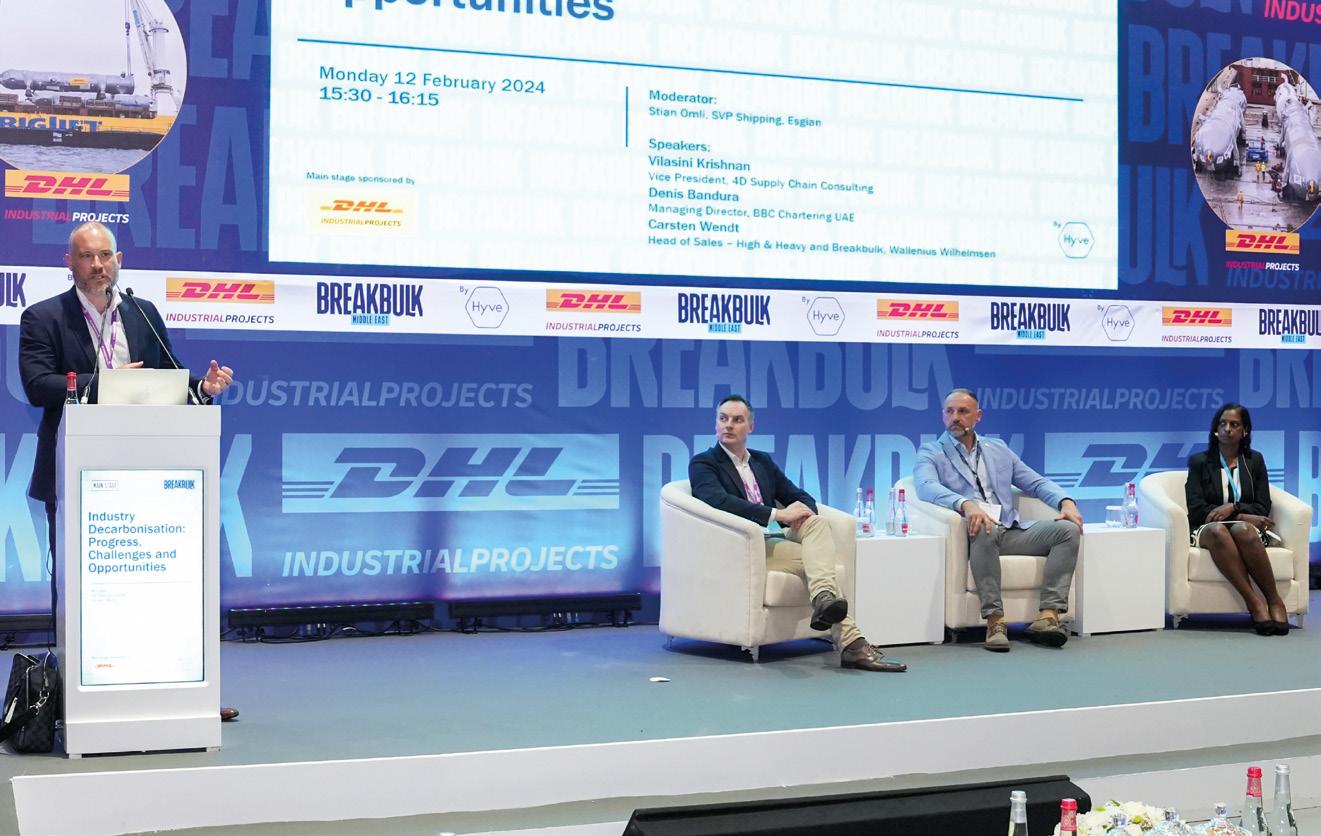
“It’s increasing the standards. It’s increasing the costs. It’s moving us toward a new competitiveness.”
Wallenius Wilhelmsen puts decarbonization at the core of its company strategy, Wendt said.
“We believe it is our social responsibility to decarbonize transportation. We do not want to wait for regulators to force something on to us. We would like to be the forerunner for decarbonization.”
Also, the way that major EPCs are shipping project cargo has already changed. While that shift might not have trickled down to the small to medium enterprises, “it is coming,” Krishnan said.
Bandura added that in his experience clients know and understand the need to decarbonize, “as they are moving towards the same goal. They may question the techniques – how to invoice, how to deal with it and so on, but all in all, they are quite understanding.”
However, one thing that is missing
is transparency, Krishnan said. Without that, “clients then struggle to understand what they are paying for.”
Another issue is that a carrier can offset the carbon on a voyage, but there is no independent verification of that offsetting. “Unless you have a third party coming in and verifying, you can’t take it at face value,” she said.
Bandura added that meeting the requirements of the European Union’s Emission Trading System is challenging for MPV operators as the actual ship is not assigned at the time of booking, and some parcels may end up being combined which could alter the ship’s emissions profile.
Another emissions-related challenge is how to spread the costs around the clients. “Do we charge by freight, by units, by destination?” Bandura asked. “For us, we’ve just gone to the simplest way, establishing a way to calculate the approximate amount for the voyage.”
86 Breakbulk Magazine Issue 2 2024 breakbulk.com
*Breakbulk Europe Exhibitor Visit: www.europe.breakbulk.com/home
CALL FOR SUPPLY CHAIN AGILITY, RESILIENCE
By Carly Fields
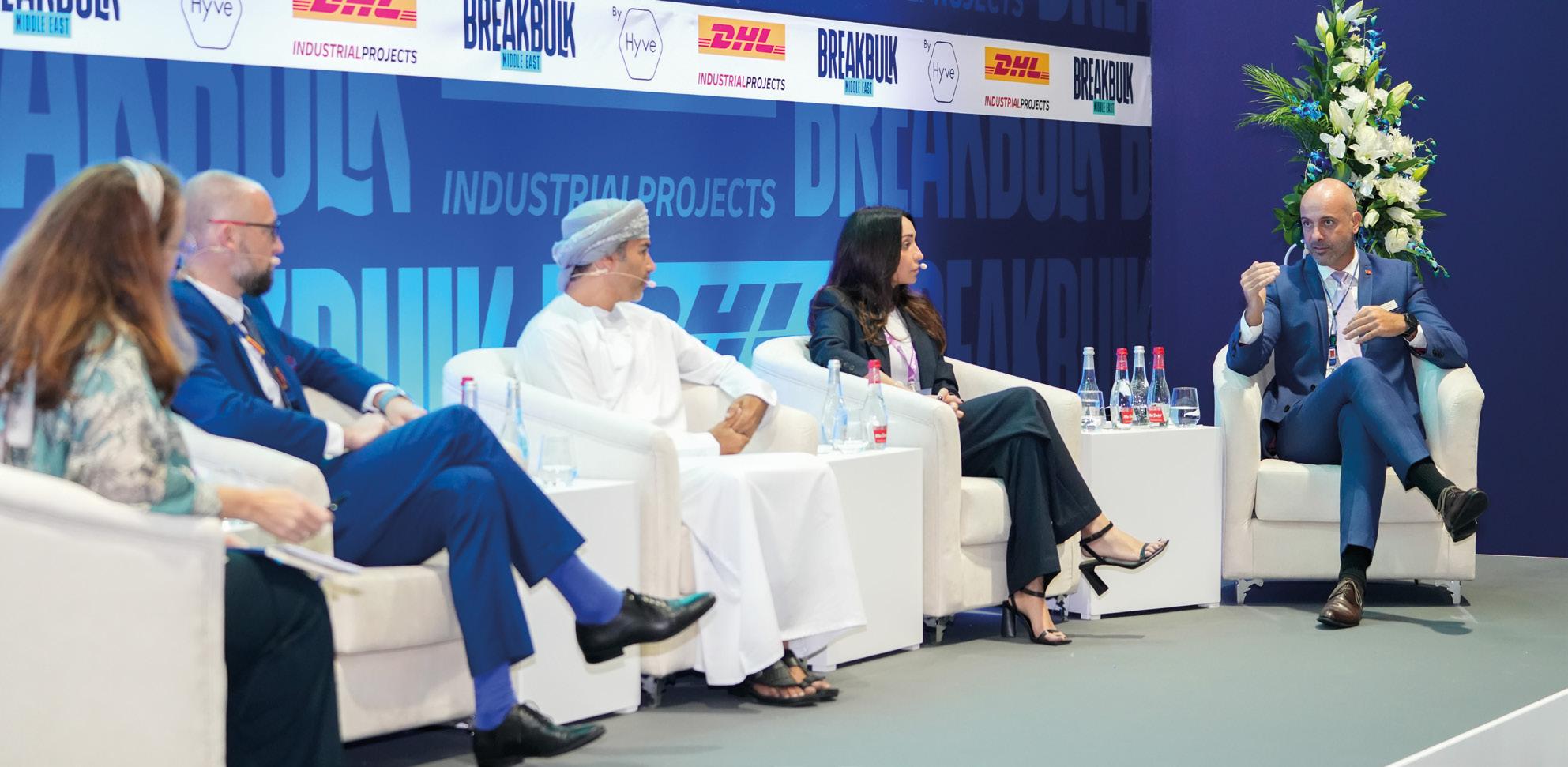
What do shippers want from their project cargo supply chains? More agility and resilience – that was the message that was delivered to an audience at The Balancing Act: Demand, Supply and Economy session at Breakbulk Middle East 2024.
Speaking as part of a panel discussion at the event in Dubai, Jamilya Garajayeva, logistics manager at Petrofac, said: “Resilience nowadays is becoming more and more important.” Petrofac has pulled back from longterm logistics contracts and some projects have switched to an ad hoc approach. “That’s where we have really changed our mindset,” she said.
Peter Dudas, head of global commercial and tendering strategy at DHL Industrial Projects, called for stability in the industry: “The direction is set, but we are hugely exposed to geopolitical issues. We have been talking about the ageing fleet for a number of years. The fundamental difference this year is the extra time ships are spending on the water. What we need as an industry is stability.”
Christopher Grammare, managing director at AAL Shipping, added
sustainability to the industry wish-list, specifically on the ship supply side. “Freight rates have to be sustainable and predictable for everyone. We have to make sure there is sufficient tonnage and the right tonnage and focus on matching supply with demand.” The other side is taking on risk, he added.
“Reputable carriers try to contract nice and early, at least one year in advance. This is how far we plan, and this is where we can help to take some of the risk. We want to work more closely with EPCs and forwarders to create long term visibility.”
Regarding risk, DHL’s Dudas said he saw two distinct trends: the exodus from the traditional turnkey and lumpsum contracting, coupled with project owners wanting to take more control and visibility. “The key word is ‘control’,” he said. “We see some actors in the market wanting to control their own destiny and wanting to control and manage risks themselves.”
Meanwhile, the ongoing Red Sea issues are of particular concern for carrier AAL Shipping. Grammare described it as the main issue that everyone is talking about. “It is
affecting carriers a lot,” he said. Rerouting to avoid the risk of attack is adding an extra 20 days to Middle East to Mediterranean routes.
“On supply chains that has a big impact and is effectively reducing the fleet.” As a result, the fleet is really tight now which has led to a freight rate increase directly linked to transiting issues.
Panelist Ahmed Al Abri, CEO of Asyad Port, noted that while the GCC region is not immune to major incidents – including the Ukraine war, the conflict in Gaza, and the Red Sea attacks on ships – there has been major expenditure across the region coupled with a drive for sustainable energy.
Garajayeva acknowledged that the supply chain has come face-to-face with many challenges over the past few years which created pressure on freight rates and added to supply chain bottlenecks. “For us as an EPC, we try to observe when freight rates will return to pre-pandemic levels. We do hope it will happen soon,” she said.
87 Breakbulk Magazine Issue 2 2024 breakbulk.com Breakbulk Middle East
*Global Event partner / Breakbulk Europe Exhibitor Visit: www.europe.breakbulk.com/home *BGSN member

WOMEN LEADERS INSPIRE NEXT GENERATION
By Simon West
new ways to develop her influence.
But when her brother passed away suddenly in 2015, Abir, who had been serving as the company’s chief strategy officer, was asked to take over the helm. She soon realized she was missing some of the skills she needed to be an effective leader, so she hired an executive coach and found

“Not for one second had I planned or thought of the possibility of becoming CEO,” she said. “When my brother died, it was a shock. A lot of people began questioning whether the company could continue at the same level, especially as my brother was really recognized as an industry leader. At the beginning I did not want to do it, it felt like too big of a challenge.
“It took me a long time, and for a while I just wanted to appear very strong and capable. Then I realized that success would come through reaching out to others, asking questions, and building a strong team.”
Abir was one of four female professionals at different stages in their careers speaking on the main stage at Breakbulk Middle East 2024 during a “Women in Breakbulk: Becoming a More Influential Leader” panel session.
The session, hosted by Breakbulk’s media director Leslie Meredith, featured some inspiring stories about how the speakers shattered glass ceilings, overcame challenges, and stirred countless others with their leadership journeys.
Returning to the workforce after an extended period of leave, Dalia Farahat secured a challenging
role at DHL Global Forwarding. Her first client, who worked for a major oil and gas firm, made no effort to hide his lack of confidence in Dalia. Undeterred, the executive’s professionalism paid off and the project was deemed a resounding success.
Dalia, now DHL Global Forwarding’s regional control tower manager O&G – MEA IP, said she initially felt “lost” and “incapable sometimes of doing the job”. She told listeners: “I felt like quitting. But with patience and resilience and hard work, I made it.”
According to the executive, “life is not what happens to us. Life is how we see it, how we define it. Having the courage to face challenges and even turning them into our favor. I was able to do this by using the competencies I have, setting goals, assessing my options, and changing the negative attitudes that comes on the surface of this journey.
“But I consider myself a lucky person. These challenges would have been much harder if I didn’t have friends next to me, a supportive team, and a company ensuring that their values of respect are always being followed and investing time and effort in women empowerment and development.”
Also on the panel, Simona Peter, business development at Fleet
Breakbulk Middle East 88 Breakbulk Magazine Issue 2 2024 breakbulk.com
Abir Leheta admits she had no pretensions of leading Egyptbased project logistics specialist Egytrans when she began her career at the family-owned business nearly two decades ago.
The sudden CEO, Abir Leheta. Credit: HYVE
Line Shipping, spoke of how hard work and dedication have enabled her to carve out her own path to success after joining her father’s business from university in 2020.
Simona has made rapid progress. But her family connection has brought both big benefits and big challenges as she strives to become an influential leader in her own right.
“(My father) was insistent that I did my journey from the ground up, just the way he did,” Simona said, who began her career at Fleet Line Shipping working in operations and pricing before joining the company’s project department in 2022, getting to grips with the different methods of loading, lifting, and lashing breakbulk cargo.
For Simona, leadership is a “journey, not a destination”. She pointed to the “personal bonds” with colleagues and clients that are crucial for success and how respect is not something that can be demanded or imposed; rather, it is earned through actions, integrity, and knowledge.
“There is so much more learning to do,” she said. “With the support I’m getting from my teammates, who are looking after me and guiding me, and vice versa – we all rely on each other. At Fleet Line Shipping, there has always been a culture of collaboration and a mindset of working together to achieve the common goal. That has gone hand-in-hand with my development over the last four years.”
The session’s final speaker was Alia Janahi, vice president of HSE at DP World in the GCC and the first female Emirati to join the company’s HSE department. Alia recalled her “tough” first interview and being asked if she was ready to work in a “male-dominated environment”.
Working in the office and out in the field, Alia quickly realized her abaya – the long, loose-fitting, robelike garment worn by some women in parts of the Muslim world – was an unsuitable attire for her job. That prompted her to design a new work


uniform that met the specifications of the job, which was then reproduced for other females in the company.
“Being the first Emirati in this position was not only new to me but the environment in which I was in,” said the 33-year-old, who now leads a 60-strong team responsible for workplace safety and environmental compliance across DP World’s entire Middle East operations. “But I was lucky as I was supported by my colleagues – even my male colleagues!”
Assessing the challenges for female professionals in the sector, Alia pointed to the “many hats” that she and her colleagues have to wear. “We have to be true to ourselves –we are not only female employees, but we are also mothers, we are daughters, we are employees. We have so many roles day-to-day that
require a lot of energy, dedication, commitment, and adaptation as well.
“In my experience, having ladies in the department makes a difference. And you should be really proud!” Our Women in Breakbulk platform brings together women from across the supply chain to share their experiences and talk about the challenges they have faced while building a successful career in the breakbulk, project cargo and maritime industries.
Our program of Women in Breakbulk events and discussions will return to Breakbulk Europe 2024 on May 21-23 at Rotterdam Ahoy. Visit: www.europe.breakbulk.com/home
89 Breakbulk Magazine Issue 2 2024 breakbulk.com Breakbulk Middle East
More than her father’s daughter – Simona Peter. Credit: HYVE
*Global Event partner / Breakbulk Europe Exhibitor Visit: www.europe.breakbulk.com/home *Global Port Partner
Patience and persistence pay off – Dalia Farahat. Credit: HYVE

ASIA SET TO DOMINATE WIND POWER SCENE
Offshore Projects Ready for Liftoff in Region
The offshore wind market in Asia is set for rapid growth in the coming years, with the region expected to account for more than half of global offshore wind capacity by 2050.
In its Emerging Asia powering ahead with decarbonization agenda report, international law firm Allen & Overy LLP found that Asia is at the forefront of the
Summary:
Asia is expected to account for over half of global offshore wind capacity by 2050 as countries look to transition away from fossil fuels, with Taiwan, South Korea, Japan, China and Australia all highlighted as having strong potential markets. But challenges to growth include cost inflation, supply chain issues, local content policies, and environmental concerns from stakeholders.
global challenge to balance economic development, climate adaptation and mitigation, and energy security, exploring multiple opportunities from coal to renewables, from batteries to hydrogen, and from offshore wind to nuclear to meet its growing energy needs and reduce its emissions.
The report pointed out that while “there have been significant increases in renewable energy capacity in recent years driven by commitments to Net Zero, there is still a long road ahead in emerging markets in Asia, where coal and natural gas still account for a significant proportion of the total energy mix. Recognizing this, ambitious goals for the increase of renewable energy have made their way into national power development plans for many countries and it is clear offshore wind has a key role to play in the energy transition agenda in emerging Asia.”
By Thomas Timlen
Speaking with Breakbulk, industry experts gave their views on the Allen & Overy report findings, examining the degree to which offshore wind will have a key role to play in the energy transition agenda in Asia, and also the potential for rapid growth.
“In our opinion a distinction needs to be made between emerging Asia and Asia more widely and of course also between nations that have meaningful seabed access and those that don’t,” said Matthew Taylor, managing director at Green Giraffe Advisory, a financial advisor for energy transition projects and investors that offers bespoke financial advice, market intelligence and development services in all renewable and energy transition technologies.
“It is correct that offshore wind has a key role to play in developed Asia, being Australia and New Zealand, Japan, Korea and Taiwan but excluding
90 Breakbulk Magazine Issue 2 2024 breakbulk.com
Asia
A Mammoet-Giant JV lifts a 563-ton wind turbine jacket for an offshore project in Taiwan. Credit: Mammoet

Singapore and Hong Kong. With the exception of Australia and New Zealand, these nations are energydependent and land-constrained but are blessed with large areas of sea with reasonable wind conditions.
“While China is a market in and of itself that is charging ahead with the deployment of renewables including offshore wind - China contributed more than 50 percent of global new build capacity in 2023 - the prospects for offshore wind in other emerging markets are more mixed.”
Asia’s Market Impact
The International Renewable Energy Agency recently predicted that Asia is set to account for more than half of global offshore wind capacity by 2050. However, Taylor is unconvinced: “Given the ambition in Europe and the U.S., that instinctively seems an unlikely prospect from our perspective. That is no to say, though, that it cannot be very impactful. With the emissions intensity of many Asian energy markets, given heavy dependence on coal in particular, the addition of clean power will have a greater positive impact on global carbon emissions than equivalent newbuild capacity in Europe or the U.S.”
Meanwhile, some Asian countries such as Vietnam already have a mix of onshore and offshore wind power facilities, while others have neither.
“Specific countries [that are] expanding offshore wind and have the most potential include Taiwan,

Japan and South Korea,” said Ruth Chen, a senior analyst at Westwood Global Energy Group, a global advisor to companies in the energy sector. “Conducive to offshore wind development are government policies such as Taiwan’s Industrial Relevance Program, South Korea’s Renewable Energy Certificate (REC) competitive auction and Japan’s Green Innovation Fund for floating wind. These countries have the most potential as government-led policies and subsidies have initiated the development of offshore wind as well as local industry. Ambitious operational offshore wind capacity targets have been set in these three nations, which is acting as a further motivator for the respective governments to ensure that projects develop at a high pace.
“According to our forecasts,” Chen continued, “Taiwan will see at least 6 gigawatts (GW) of capacity coming online before 2030 as it has an operational target of 21GW by 2035. A total of 2.8GW of lease capacity was awarded in 2023 via the Round 3.1 auction. Further capacity is due to be awarded in future leasing rounds, starting with round 3.2 which is scheduled to take place in 2024.”
Chen pointed out that Japan has also been increasing leasing activity to try and meet its target of 5.7GW by 2030. “In December 2023, 1.4GW of capacity was awarded in the Round 2 lease auction and the 1GW Round 3 tender has just been launched. South Korea is aiming
to have 14.3GW online by 2030. Offshore wind developments in the country have been relatively slow due to the complex system that is in place, but things are now starting to pick up. The award of wind power fixed price contracts for five projects with a total capacity of 1.43GW in December 2023 highlights the progress that is starting to be made.”
Gauging Wind Potential
In Taylor’s view, there are many markets with potential for offshore wind in Asia. “The tier 1 countries are the large OECD nations: Japan, Korea, Australia and New Zealand together with Taiwan and China, all of whom have strong wind resources combined with large power demand. The offshore wind market within each of these jurisdictions is at various degrees of maturity but all have strong fundamentals that appeal to a broad base of developers and investors. Taiwan is leading, but Korea, Australia and potentially Japan are now accelerating.
“Tier 2 markets are primarily Philippines, Vietnam and India with Bangladesh and Sri Lanka representing a third tier. These tier 2 markets have at least some of the core fundamentals needed but are currently lacking in some way, primarily with respect to regulations/policy.”
Allen & Overy identified several challenges that could hinder offshore wind development, including cost inflation, supply chain tightening, declining subsidies, vessel availability and jurisdiction-specific challenges.
Taylor said it is impossible to isolate just one challenge as being the most impactful in Asia. “Green Giraffe sees 2024 as being a year of transition for offshore wind with momentum hopefully coming back strongly, particularly towards the end of the year. The key reasons for this are easing of inflationary pressures and associated interest rates and of supply chain constraints, particularly on the turbines. Further, no market in Asia is without its own imposed headwinds,
91 Breakbulk Magazine Issue 2 2024 breakbulk.com
Asia
Matthew Taylor
Ruth Chen
Asia
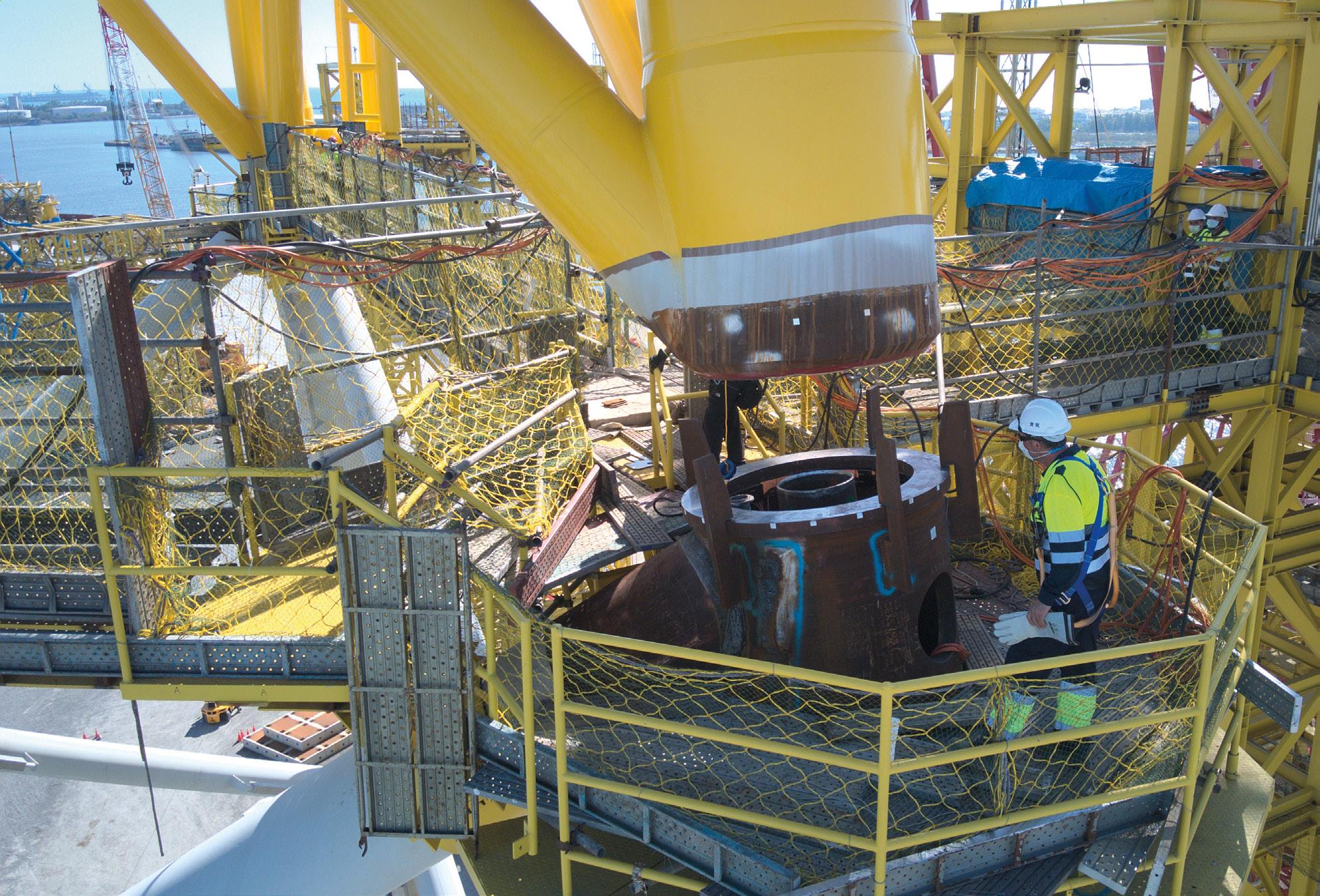
Taiwan being the most notable example with local supply constraints imposing further punitive costs on projects.”
Chen feels that cost inflation is a global issue which also has the most impact in Asia as well, alongside jurisdiction-specific challenges. “European turbine manufacturers have struggled with cost inflation in far advanced European and U.S. projects and have in turn hiked their prices to Asian customers,” she said. “This led to the trend of Asian customers, excluding China, considering the use of Chinese turbines as the price differentials are as much as 20-25 percent.
“Jurisdiction-specific challenges such as local content policies have become a sticking point for developers, but in countries such as Taiwan, there is a robust negotiation process between government and developers, resulting in a mostly mutually beneficial situation,” Chen added. “The other jurisdiction-specific challenges
include environmental concerns against offshore wind development from stakeholders such as fisheries who have been very vocal in countries such as South Korea, Japan and Taiwan. These have had an impact on the development of offshore wind projects from a very early stage.”
Learning Lessons
Allen & Overy’s report points out that a handful of smaller floating offshore wind projects around the world have provided valuable learning for the development of larger scale projects, starting in China “where the PFS-1 Southeast Wanning project will be among the, if not the, largest floating offshore wind project globally. However, higher costs and technical and logistical challenges as compared to its fixed-bottom counterpart, as well as supply chain issues, likely mean that widespread installation of large floating offshore wind is still some way off,” Chen said.
Not everyone shares that view, however. “We do not agree that deployment of large floating assets in Asia is a long way off,” Taylor said. “In fact, we see quite some activity. Most notably we expect assets to mature in Korea and Taiwan, driven by upcoming auctions. It is correct that floating offshore wind is not price competitive with its fixed bottom cousin, so floating is dependent on higher levels of support for now. For this reason, and the relative maturity of fixed bottom, floating will remain a smaller portion of new build capacity for some years to come.”
While it remains to be seen where the most projects will be launched and how fast the pace will be, all indicators point to considerable growth in Asia’s offshore wind energy sector.
Thomas Timlen is a Singapore-based analyst, researcher, writer and spokesperson with 31 years of experience addressing the regulatory and operational issues that impact all sectors of the maritime industry.
92 Breakbulk Magazine Issue 2 2024 breakbulk.com
A worker supervises the handling of a turbine jacket for an offshore wind project in Taiwan. Credit: Mammoet
Breakbulk Events & Media’s biweekly BreakbulkONE newsletter keeps the industry connected between Breakbulk events in Dubai, Rotterdam and Houston. Here’s a selection of recent subscriber favorites. Subscribe at https://breakbulk.com/page/one
CORPUS CHRISTI TO HANDLE MORE PROJECT CARGO
The buildout of wind energy projects in the U.S. and a major liquified natural gas (LNG) expansion project in Texas is driving project cargo volumes at the Port of Corpus Christi, the largest U.S. port in revenue tonnage.
LNG exporting giant Cheniere is building a new 10 million tons per annum (mtpa) plant adjacent to its Corpus Christi Liquefaction facility, a project calling for significant project logistics support.
Cheniere and Bechtel started construction work on the project in 2022.
“Later this year, and moving into the following two years, we anticipate an increase in wind cargoes as the market catches up with demand,” Omar Garcia, chief external affairs officer at Corpus Christi, told Breakbulk. “We also expect to see increased throughput in project cargo as a result of the expansion Cheniere is constructing.”
Record Volumes
Last year, the port’s customers set a new high mark in annual tonnage, moving more than 200 million tons of goods through the Corpus Christi Ship Channel for the first time in its history.
Some 203 million tons were transported through the strategic gateway, up by 8.1 percent compared with 2022. The port attributed the rise primarily to a 12.5 percent jump in crude oil exports to 126.1 million tons, a 13.5 percent rise in agricultural commodities to 2.2 million tons, and a slight increase in petroleum products to 42.5 million tons.

A record high volume of LNG – some 16.3 million tons – was also moved through the channel last year. Garcia told Breakbulk that market trends pointed to a “marginal increase” in crude oil exports in 2024.
The port, whose slogan is “moving America’s energy,” announced in September that the US$682 million Corpus Christi Ship Channel Improvement Project, or CIP, had entered into its last phase.
The U.S. Army Corps of Engineers (USACE) had awarded the CIP’s fourth and final contract to Callan Marine, the port said, with completion of this phase slated for early 2025.
The CIP, which the port said would render the ship channel the “most improved waterway along the U.S. Gulf Coast from Texas to Florida,” is increasing the depth of the channel from 47 feet to 54 feet Mean Lower Low Water and widening it to 530 feet.
The project is also calling for an additional 400 feet of barge shelves to be built, allowing for two-way traffic of both vessels and barges in tandem.
Other projects in development or under construction at Corpus Christi include upgrades at the port’s Bulk Terminal docks and a 35-acre expansion of laydown storage on the Northside of the breakbulk-handling Cargo Dock 9.
According to Garcia, the Cargo Dock 9 project aims to provide direct rail access to the dock as well as the capability to load a full unit-train in Rincon West, an open storage area designed to house general, project, wind, and roll-on, roll-off cargoes.
The Port of Corpus Christi will be exhibiting at Breakbulk Americas 2024 on October 15-17 at the George R. Brown Convention Center in Houston, Texas. Visit: www.americas.breakbulk.com/home
93 Breakbulk Magazine Issue 2 2024 breakbulk.com
Port of Corpus Christi handling steel coils. Credit: Port of Corpus Christi
AAL RESPONDS TO PERILS OF RED SEA ROUTES
Project cargo carriers, caught in the literal cross hairs of geopolitics, are having to make difficult trade routing decisions today.
The Red Sea routes are increasingly difficult to justify due to the risk of attack from Houthi-led rebels, threatening the safety of ships and crews. Yet, schedule slippage is never an easy conversation to have with shippers.
Christophe Grammare, CEO of AAL Shipping, explained that avoidance of the Suez Canal – compounded by the drought restrictions in the Panama Canal - have compelled vessels to take longer routes, significantly affecting voyage durations and supply chain schedules.
For instance, a voyage from Asia to Europe (or vice versa) requires an additional 10 days via the Cape of Good Hope compared with a voyage via the Suez Canal. It is 14 additional days for a cargo movement from Jebel Ali to Antwerp and 22 days for Porto Maghera in the Adriatic Sea to Jebel Ali.
“This will create issues for servicing the Mediterranean and Black Sea ports and potentially also for the Middle East region,” Grammare said. AAL is still offering customers sailings through the Red Sea but warned that this comes with heavy insurance premiums and security protocols.
“This ongoing situation is affecting not only voyage costs, but also global tonnage supply which, considering the increase in longer voyages re-routing around Africa, is limiting supply. This is harming supply chain schedules and pushing up freight rates.”
AAL said it is in constant contact with its technical managers, underwriters, and other security advisers to evaluate every voyage on a ‘case by case’ basis, prioritizing the safety of its crews, vessels, and customer cargoes.
Supply/Demand Outlook
Speaking to Breakbulk, Grammare turned to multipurpose vessel supply
and demand, acknowledging that while both are generally balanced, the Red Sea situation and reduced Panama transits have introduced a temporary supply/demand imbalance.
He highlighted the evolving dynamics of MPV ship capacity. Unlike the container market-driven capacity squeeze witnessed in previous years, the MPV market is now primarily influenced by noncontainerizable cargo demand.
“On the MPV and project vessel front, we have seen investments driven solely by carriers, that is to say no speculative investment due to the unpredictable nature of the project and heavy-lift market demand – unlike the container world.” Added to which, it is exponentially more difficult to secure finance or find suitable yards for new buildings today.
“Newbuilding orders are being more carefully considered and mostly placed by the owner/operators themselves and only when they see a real market gap or need,” he said. “Another hurdle is the future proofing of new vessel design in view of the expected fuel and propulsion revolution that is bound to occur within the next 10 years.”
For its part, AAL takes delivery in May of the first in a series of six new 32,000 dwt Super B-Class with 3 x 350 ton lifting gear. Three more will be delivered this year and two in 2025. While other heavy-lift operators have also taken deliveries in the past few years and added new orders, the general feeling around orders is caution.
“Project carriers are very cautious about market demand and vessel supply after a decade of losses from 2009 to 2020 and mindful that freight rates and charter rates need to be at levels that are sustainable for everyone in the supply chain,” Grammare said.
Sustainable Moves
In the pursuit of sustainability, Grammare underscored the pivotal role
Christophe Grammare

of carriers in addressing ecological concerns and aligning tonnage availability with market changes. As project cargoes continue to grow in size and complexity, there is a notable shift towards specialized, project-oriented vessels equipped with heavy lifting capabilities.
“AAL with our focus on large project vessels with heavy lifting gear is right at the center of this continuous transformation. Our Super B-Class are focused on the ability to take larger cargoes,” Grammare said. However, he stressed the importance of striking a balance between sustainability initiatives and ensuring the viability of freight rates, emphasizing the need for partnerships and long-term contracts to mitigate supply chain risks.
“The huge variations in freight rates we have seen have been disruptive not only for cargo interests but for carriers with many years of extremely low levels. Every breakbulk project carrier will be careful not to create an oversupply scenario,” Grammare said.
“The Covid pandemic reminded cargo interests that supply is not unlimited, and therefore key cargoes, especially very large or very heavy, or high-volume, need to think about forward cover. Long term contracts and partnerships have been few and far between, but since the pandemic we have seen a change in this area.”
AAL will be exhibiting at Breakbulk Europe on 21-23 May at Rotterdam Ahoy. Visit: www.europe.breakbulk.com/home
*Global Event partner
94 Breakbulk Magazine Issue 2 2024 breakbulk.com BBOne

Swire Project’s vessel Pacific Hero. Credit: Swire Shipping
SWIRE PROJECTS LAUNCHES ASIA-AMERICA SERVICE
Swire Projects has launched a new dedicated semi-liner service connecting Asia with the West Coast of North America, a move that supports rising demand for transpacific breakbulk services while avoiding the increasingly congested Panama Canal.
In recent months, the Central American waterway has faced historic droughts that have restricted daily transits and caused serious delays for breakbulk and project cargo handlers, who have been forced to plan further out to secure slots or seek alternative routes.
Rufus Frere-Smith, regional head of Americas at Swire Projects, told Breakbulk the new service was driven by the need for a quality breakbulk solution catering to the project cargo and associated markets which has been “lacking in recent years,” a situation compounded by the current tightness in the roll-on, roll-off market.
“But there is no doubt that there is increased uncertainty with shipping via the Panama Canal for the
foreseeable future. The West Coast provides a reliable gateway for cargo which can be transported to the interior of the continent by rail and over the road which is time sensitive.”
Previously offered on an ad-hoc basis, Swire Projects’ new semi-liner service connects the base ports of Qingdao and Taicang in China and ports en route, with Everett in the U.S. state of Washington, and Vancouver in British Columbia.
The service will also offer inducement calls at various ports in Southeast Asia, the U.S. West Coast, and Mexico.
Swire Projects has selected its H-Class, 28,500-dwt MPVs to service the route, backed up by its I Type, 19,000-dwt MPVs. The open-hatched, tweendeckers have a lifting capacity of 160 to 480 tons and can ship a wide range of cargo including project cargo, breakbulk, dangerous goods, steel, forest products, and dry bulk.
According to Frere-Smith, Swire Projects already boasts existing infrastructure in the region and
strong local relationships with key terminals and service providers.
“Sailings have commenced, and the type of cargo ranges from steel products, oil and gas equipment, wind and power project components, plant and machinery, cranes, ESS (energy storage systems) for solar and EV plants, yachts and SOCs (shipperowned containers),” Frere-Smith said.
“On westbound legs we are typically focusing on bulk or bagged commodities, but we are also open to taking specialized cargoes such as IMDG, oil rigs, mining equipment and forestry products. We will continue to evolve the service to meet the needs of the market, and this could include broadening geographical scope where demand exists, which includes Southeast Asia, the Indian Sub-Continent and Australasia. We can also link our transpacific service with our recently launched monthly Western Australia service which connects North and Southeast Asia.”
*Breakbulk Europe Exhibitor Visit: www.europe.breakbulk.com/home BBOne 95 Breakbulk Magazine Issue 2 2024 breakbulk.com
PROJECTS IN THIS ISSUE
Project: Net-zero Hydrogen Energy Complex
Story: Prepping for a Hydrogen Heyday
Country: Canada
Sector: Energy Transition
Developer(s): Air Products
Project: NEOM Green Hydrogen
Story: Prepping for a Hydrogen Heyday
Country: Saudi Arabia
Sector: Energy Transition
Developer(s): NEOM Green Hydrogen Company (NEOM, Air Products, ACWA Power)
Project: Kolosori Nickel Project
Story: Nickel Needs Set to Drive Mining Projects
Country: Solomon Islands
Sector: Mining
Developer(s): Pacific Nickel Mines
Project: Araguaia Nickel Project
Story: Nickel Needs Set to Drive Mining Projects
Country: Brazil
Sector: Mining
Developer(s): Horizonte Minerals
Project: Hornsea 3 Offshore Wind
Story: Too Many Turbines, Too Few Vessels
Country: UK
Sector: Renewables
Developer(s): Ørsted
Project: Norfolk Projects Offshore Wind
Story: Too Many Turbines, Too Few Vessels
Country: UK
Sector: Renewables
Developer(s): Vattenfall
Project: Dodger Bank Offshore Wind
Story: Too Many Turbines, Too Few Vessels
Country: UK
Sector: Renewables
Developer(s): SSE Renewables, Equinor, Vargronn
Project: Berwick Bank Offshore Wind
Story: Too Many Turbines, Too Few Vessels
Country: UK
Sector: Renewables
Developer(s): SSE Renewables
Project: Heidelberg Materials Carbon Capture and Storage
Story: Lessons Learned from CCS Project
Country: Norway
Sector: CCS
Developer(s): Heidelberg Materials
Project: Dartagnan CO2 Export Hub
Story: Lessons Learned from CCS Project
Country: France
Sector: Industrial Gases
Developer(s): Air Liquide
Project: Northern Lights CCS
Story: Lessons Learned from CCS Project
Country: Norway
Sector: Carbon Capture and Storage
Developer(s): Equinor, Shell, Total
Project: Yumurtalik Port
Story: SASA’s Uğur Çelikoğlu Helps Steady Ship
Country: Turkey
Sector: Ports and Terminals
Developer(s): SASA Polyester
Project: Drumlins Park Onshore Wind
Story: Trying Terrain for Collett Turbine Move
Country: Ireland
Sector: Renewables
Developer(s): Energia Group
Project: Ocean Wind 1 & 2
Story: US Wind Projects Setback, Not Stalled
Country: U.S.
Sector: Renewables
Developer(s): Ørsted
Project: Beacon Wind 1 & 2
Story: US Wind Projects Setback, Not Stalled
Country: U.S.
Sector: Renewables
Developer(s): Equinor, BP
Project: Baoshan Steel Plate Manufacturing Complex
Story: Saudi’s Horizon of Project Opportunities
Country: Saudi Arabia
Sector: Steel
Developer(s): Baoshan Iron and Steel Co.
Project: Ras al Khair Solar Thermal Project
Story: Saudi’s Horizon of Project Opportunities
Country: Saudi Arabia
Sector: Renewables
Developer(s): Ma’aden, GlassPoint
Project: Development Road
Story: Iraq’s Mega-project Sparks Infrastructure Boom
Country: Iraq
Sector: Infrastructure – Railways, Roads, Ports
Developer(s): state-led
Project: New Bismayah City
Story: Iraq’s Mega-project Sparks Infrastructure Boom
Country: Iraq
Sector: Infrastructure – Urban Development
Developer(s): National Investment Commission of Iraq (NIC)
Project: Greater Tortue Ahmeyim LNG
Story: Africa’s Oil and Gas Sector Surges
Country: Maritime border between Mauritania and Senegal
Sector: Oil & Gas – Upstream
Developer(s): BP (and partners)
Project: East African Crude Oil Pipeline (EACOP)
Story: Africa’s Oil and Gas Sector Surges
Country: Uganda/Tanzania
Sector: Oil & Gas – Midstream
Developer(s): TotalEnergies (and partners)
Project: Dangote Oil Refinery
Story: Africa’s Oil and Gas Sector Surges
Country: Nigeria
Sector: Oil & Gas – Downstream
Developer(s): Dangote Group

Credit: BBC Chartering
96 Breakbulk Magazine Issue 1 2024 breakbulk.com Opportunities









































































































 By Carly Fields and Simon West
By Carly Fields and Simon West




































